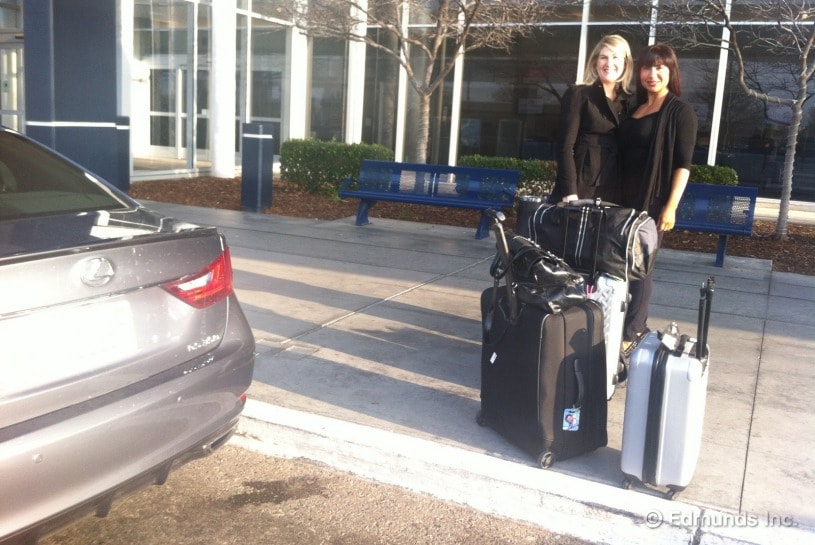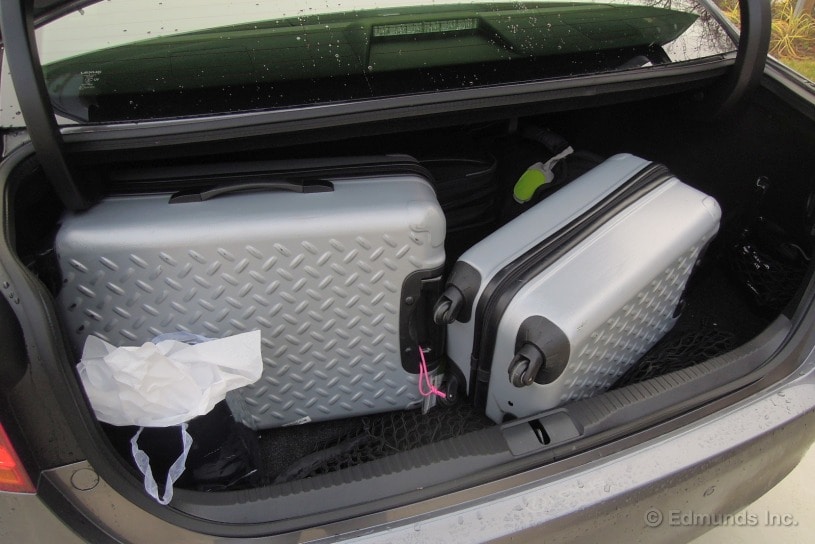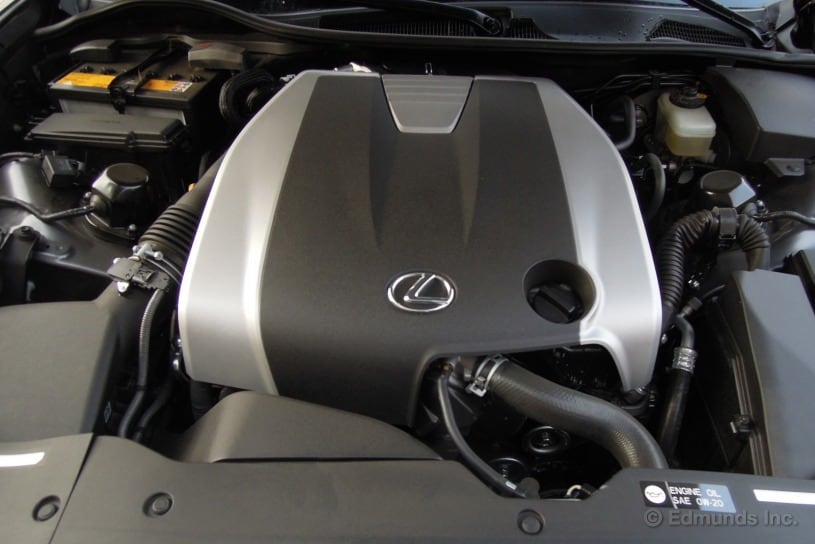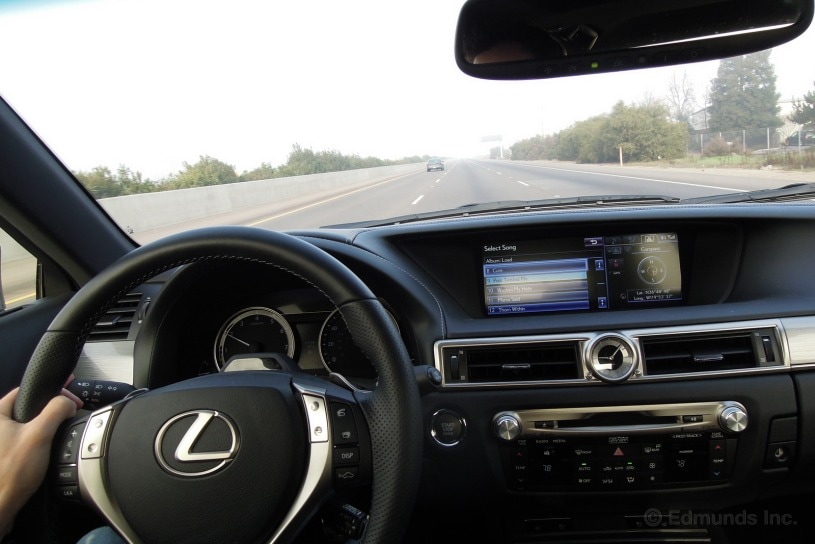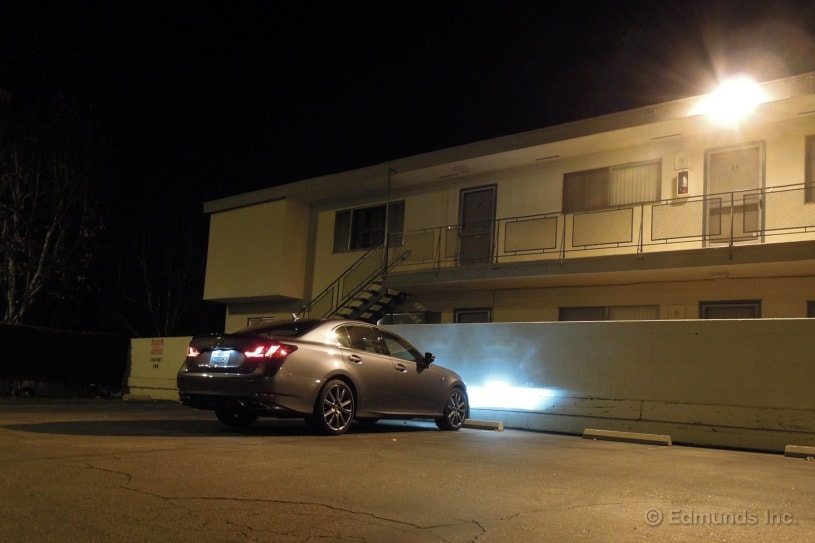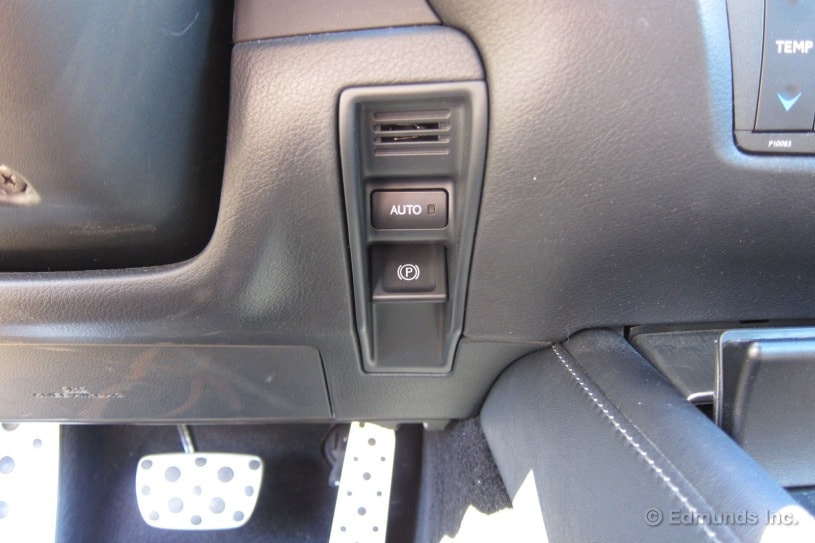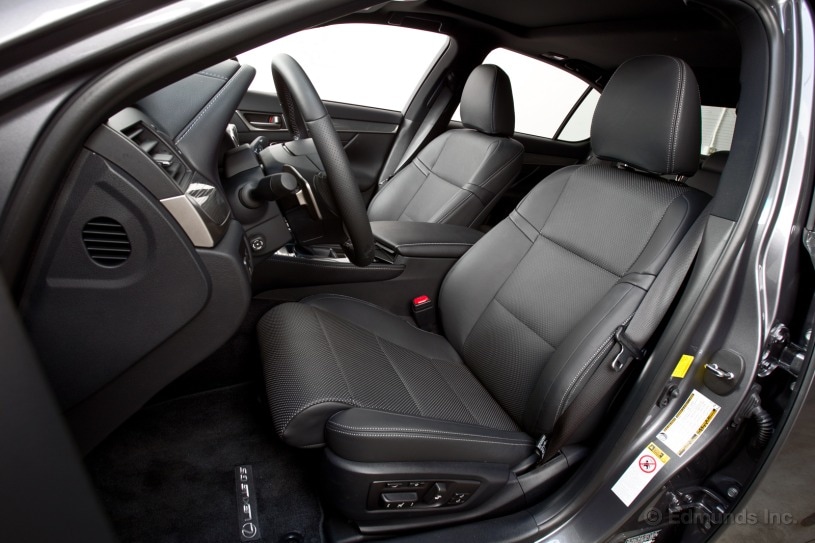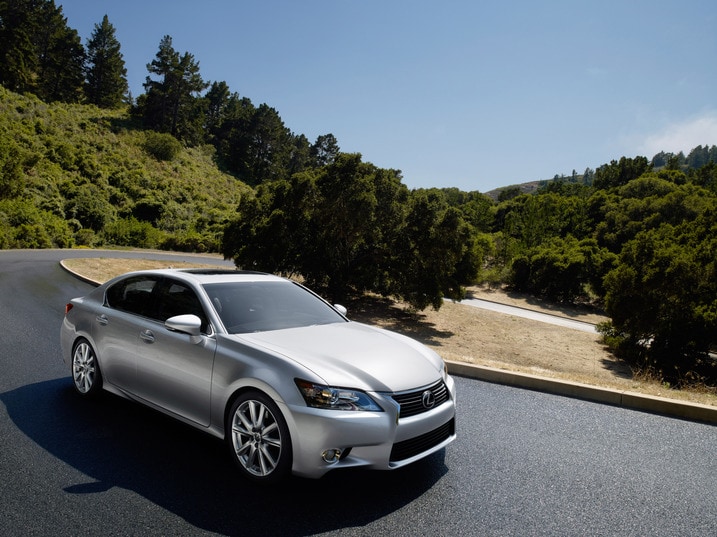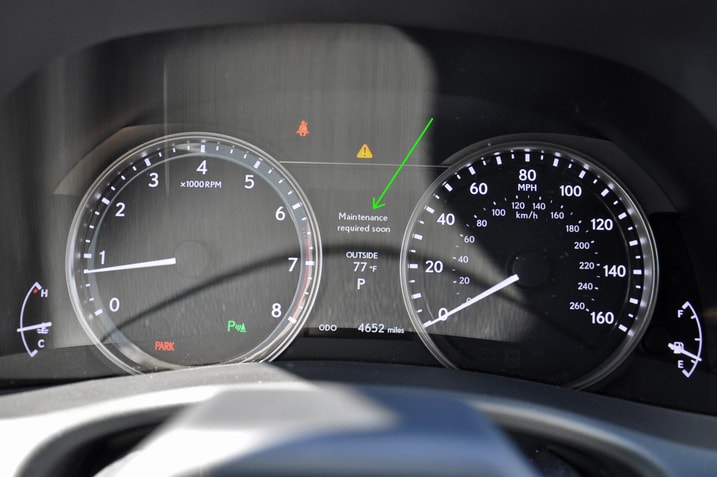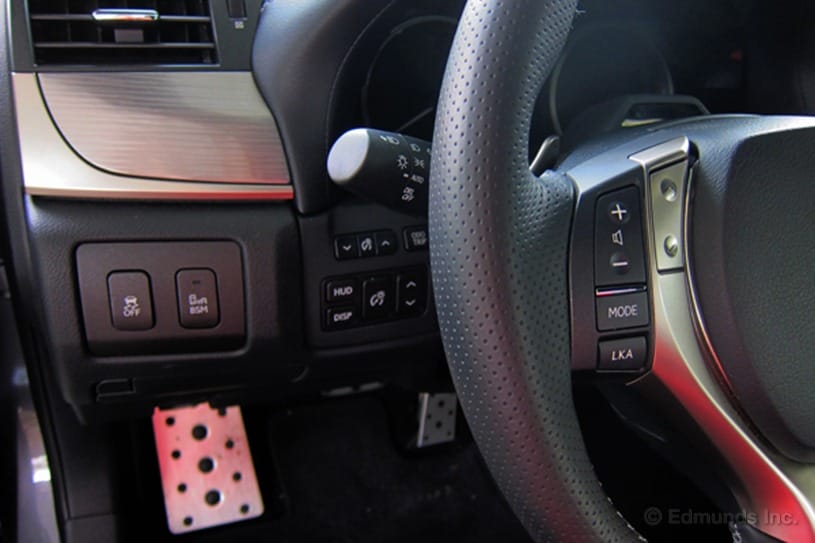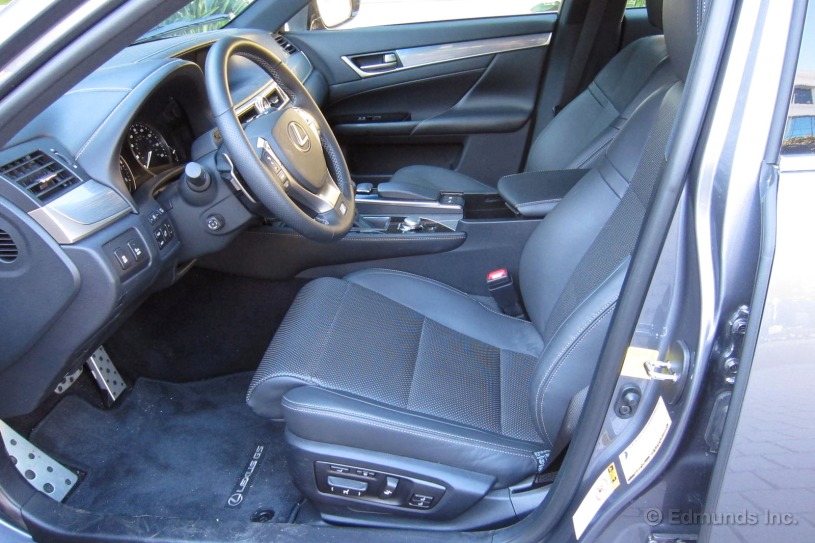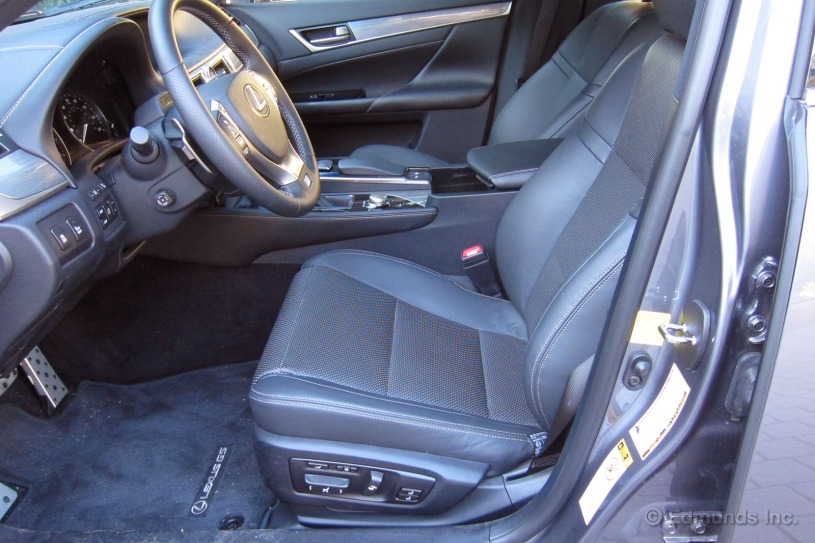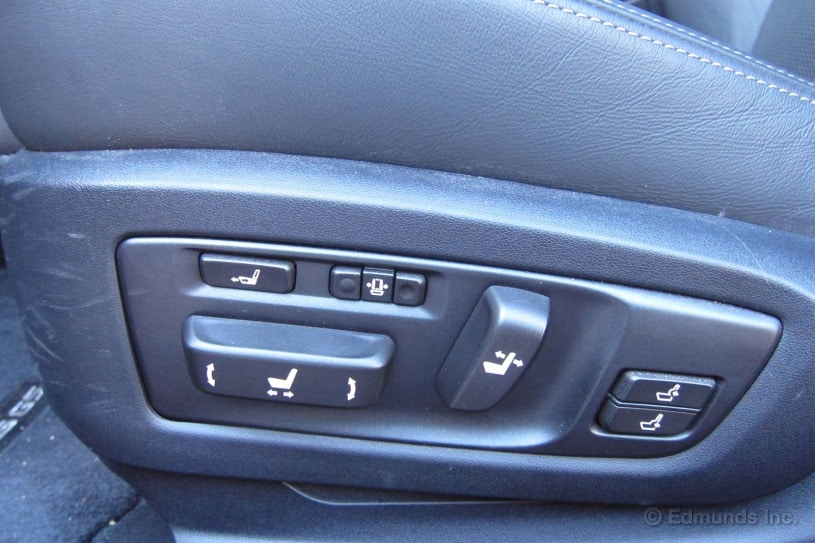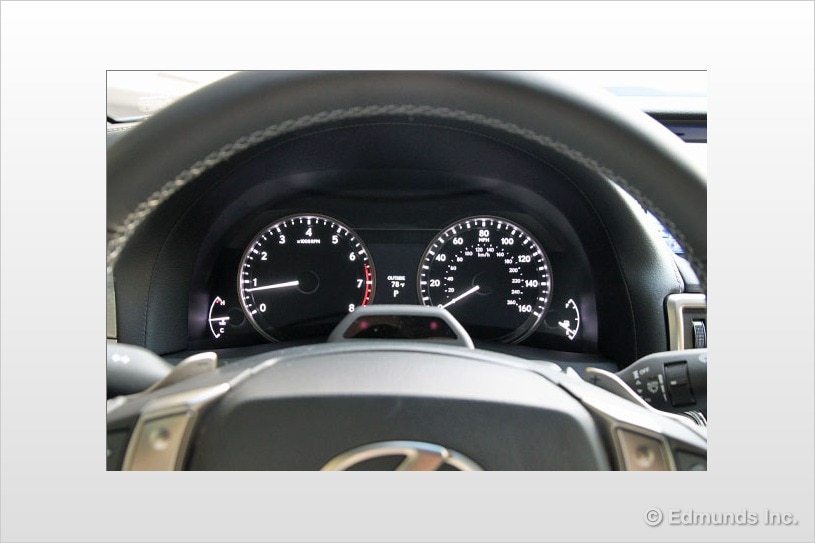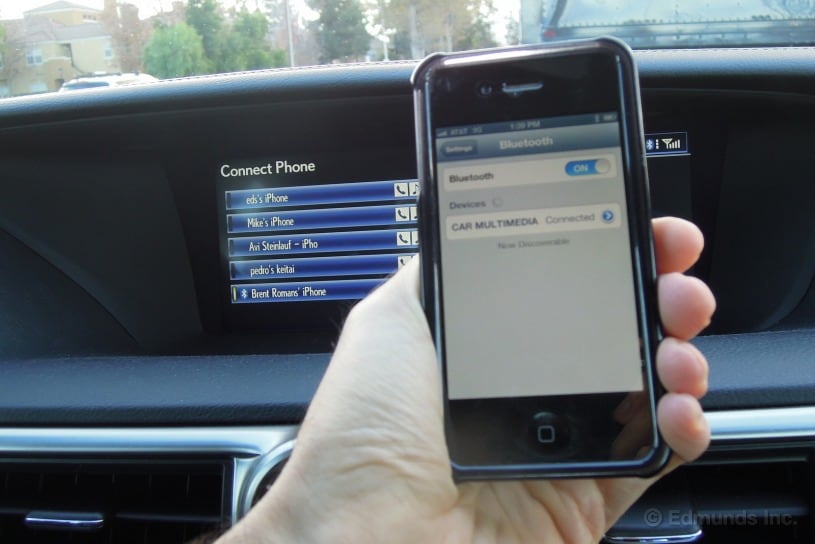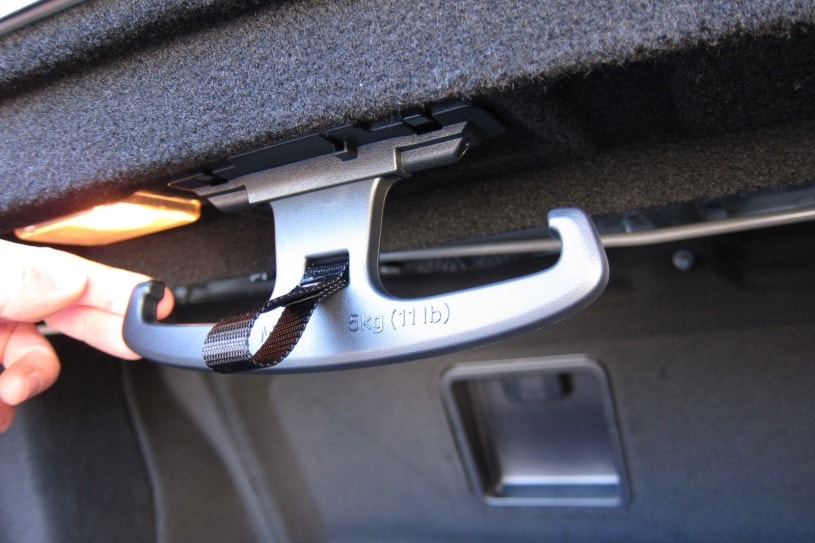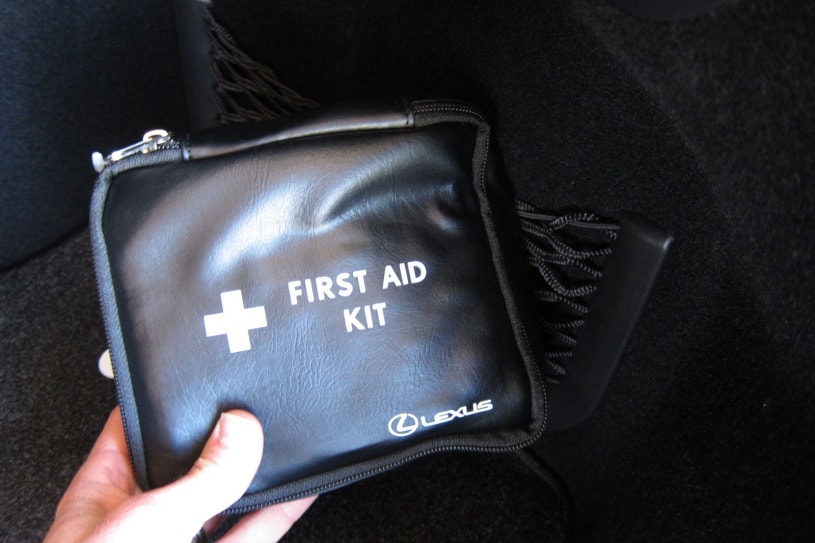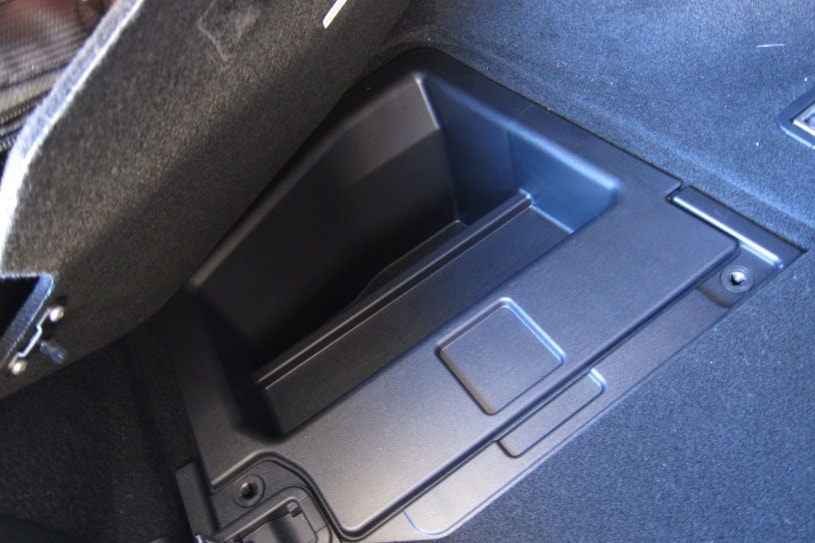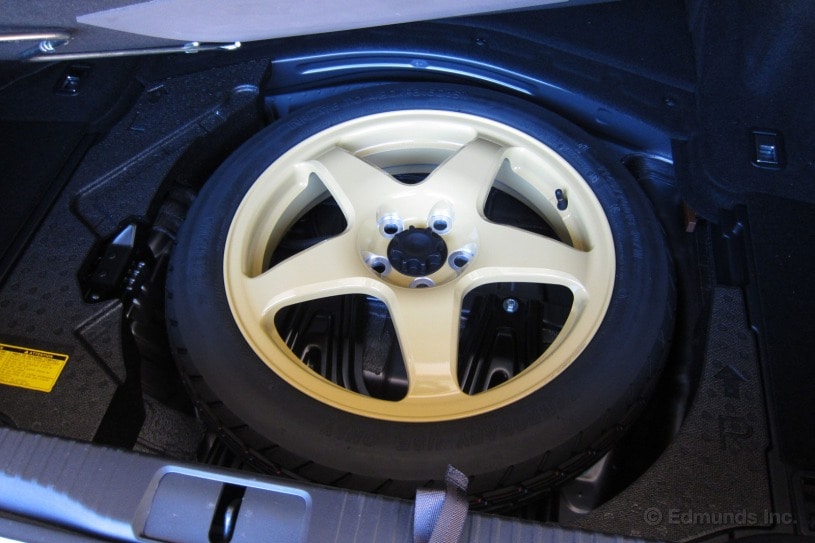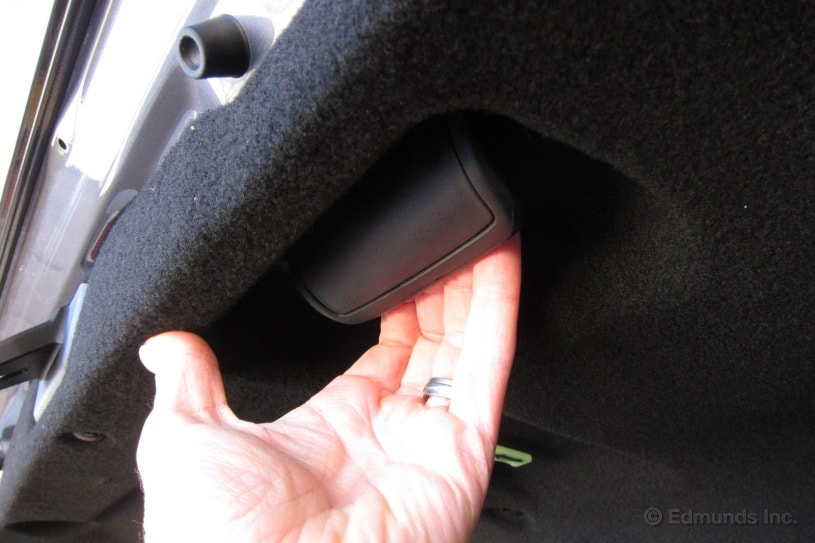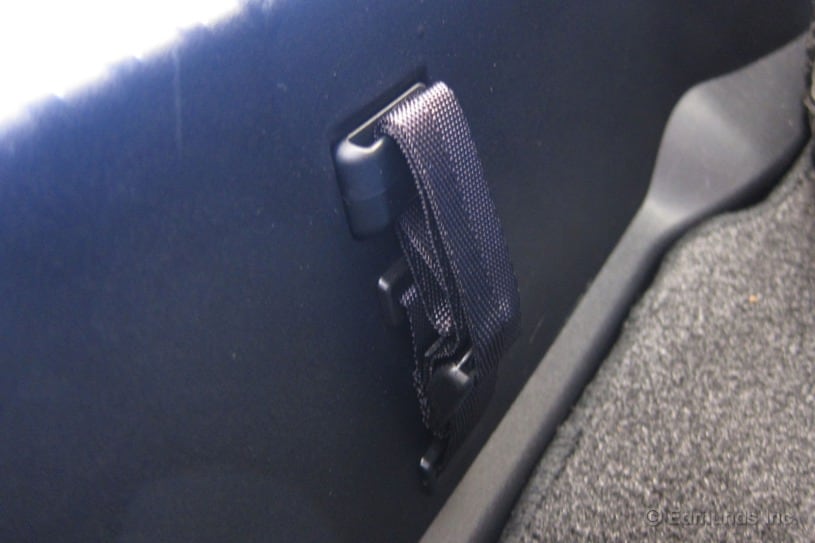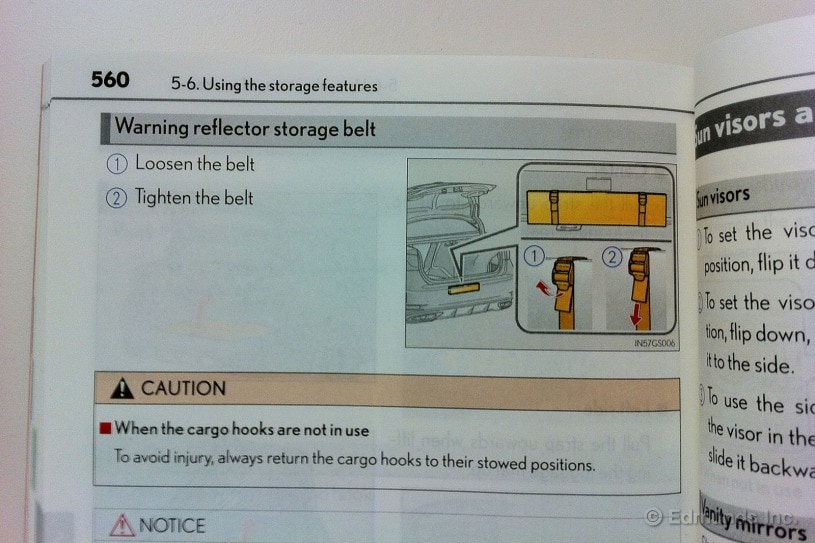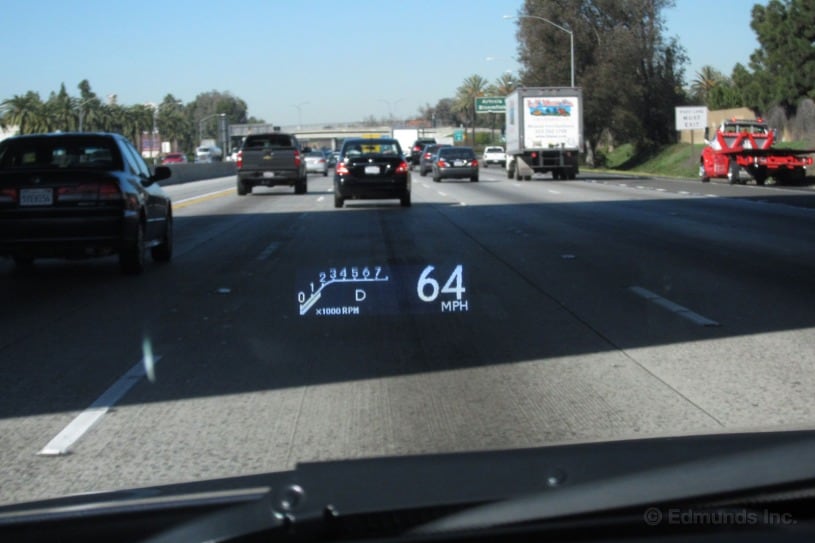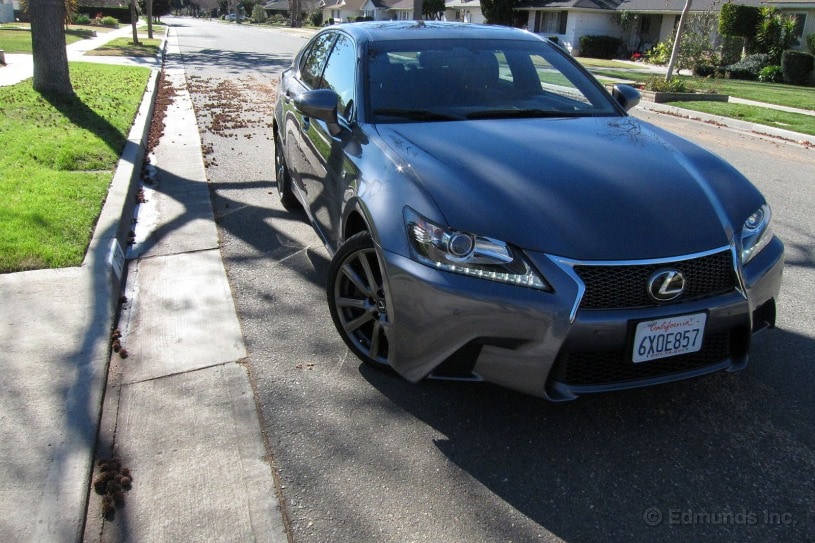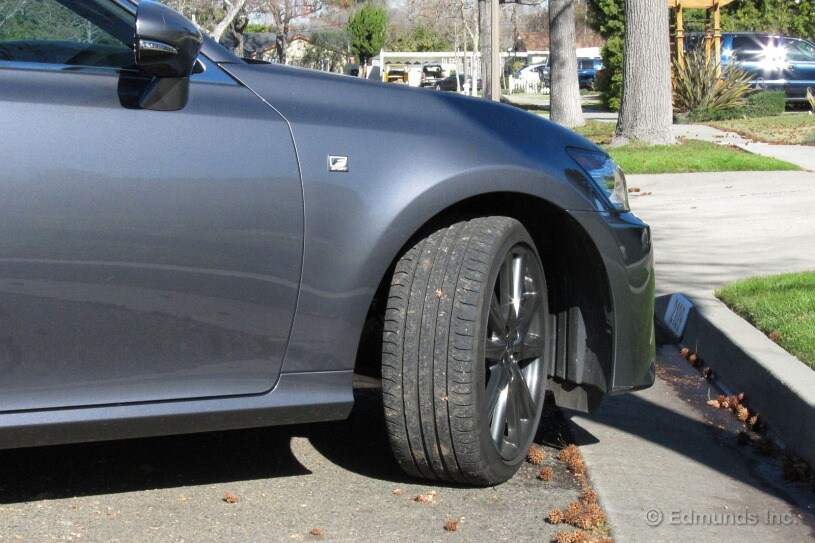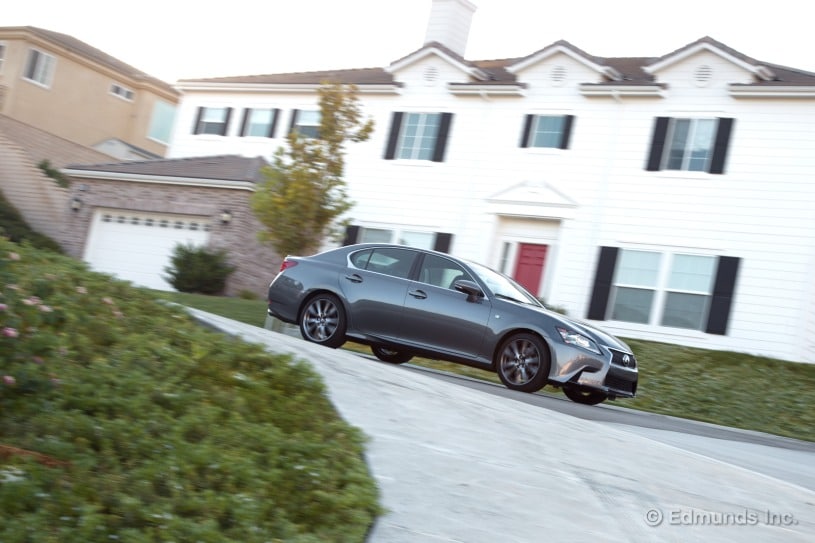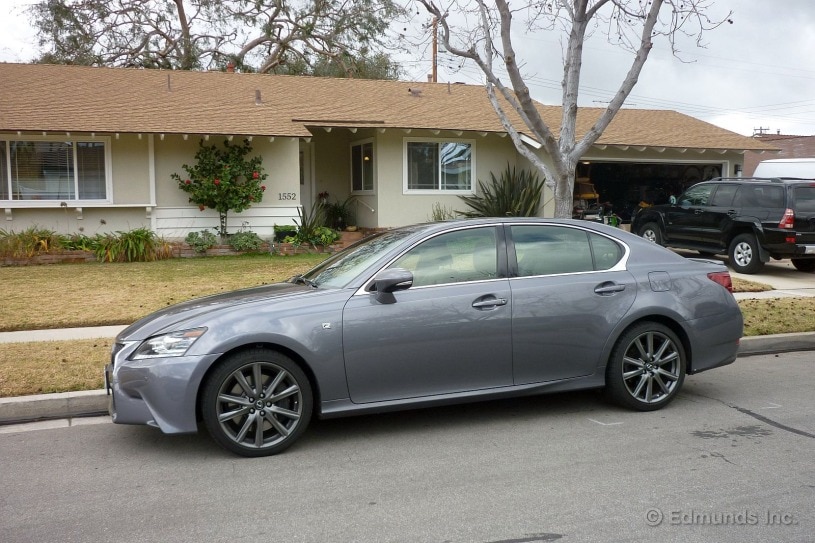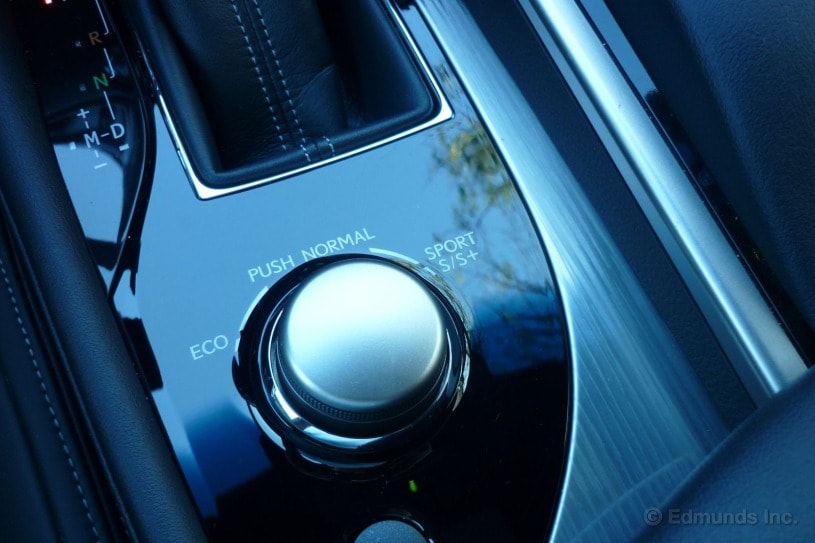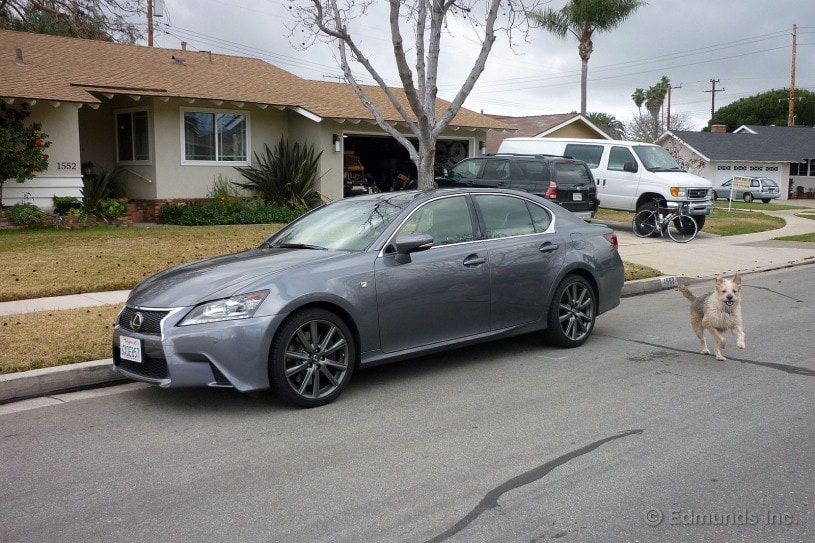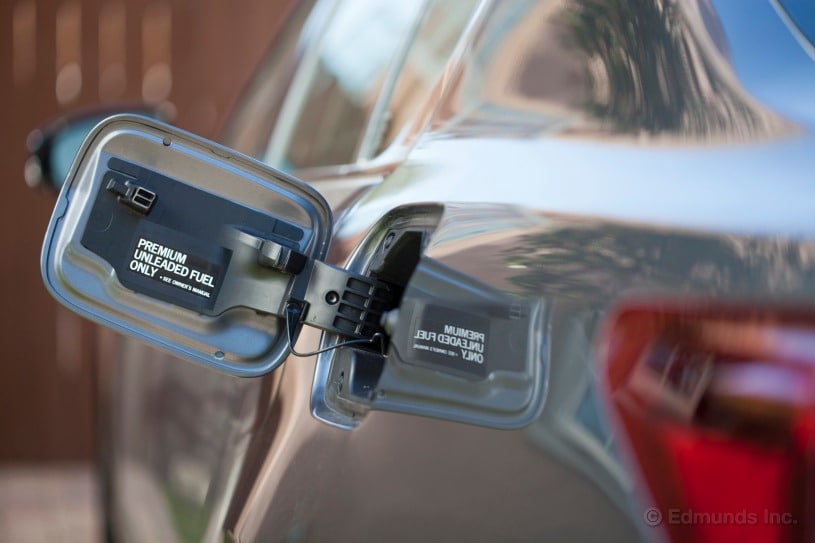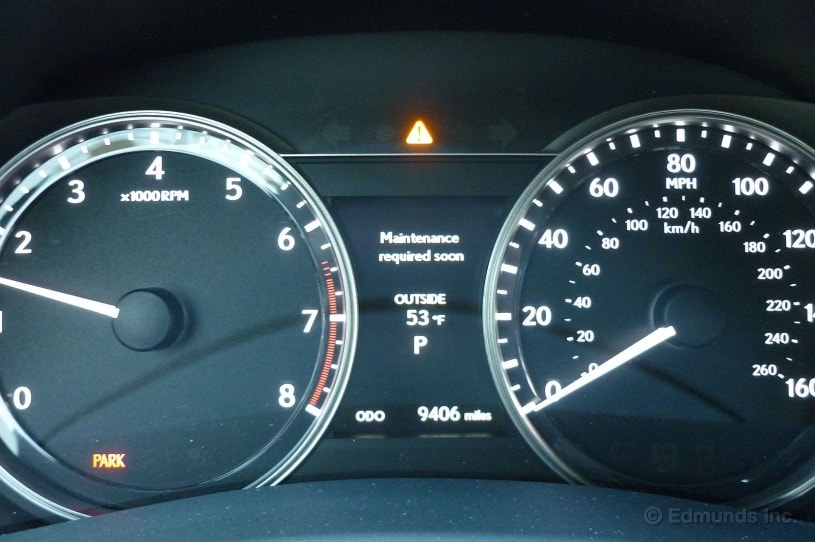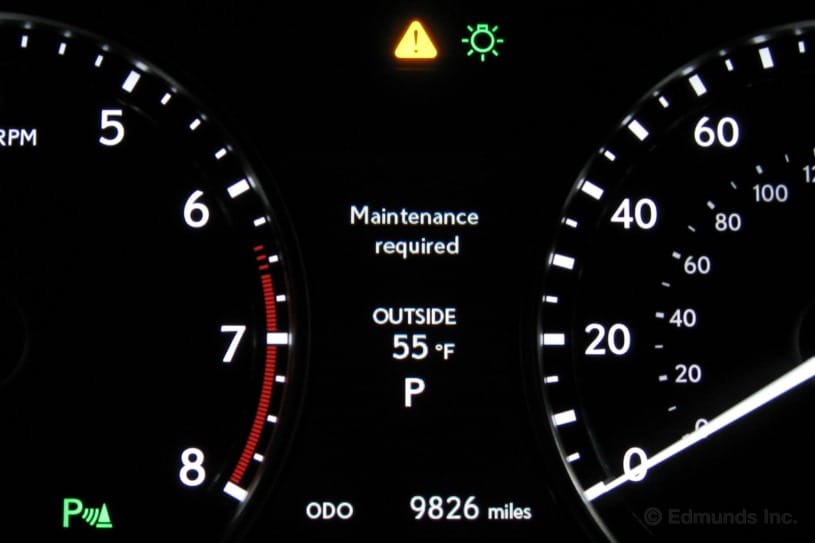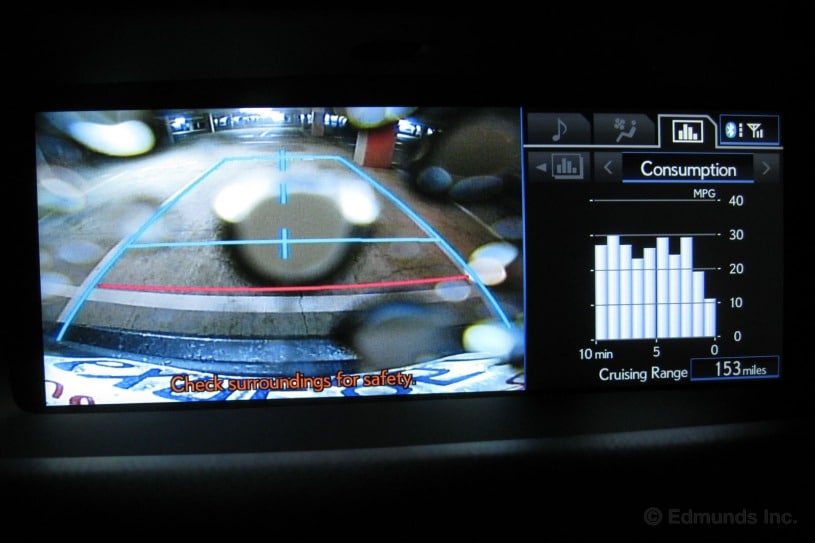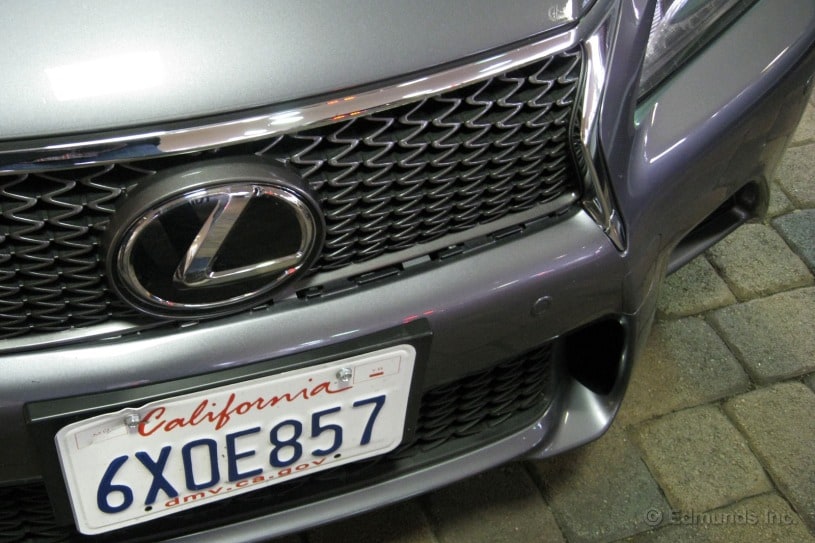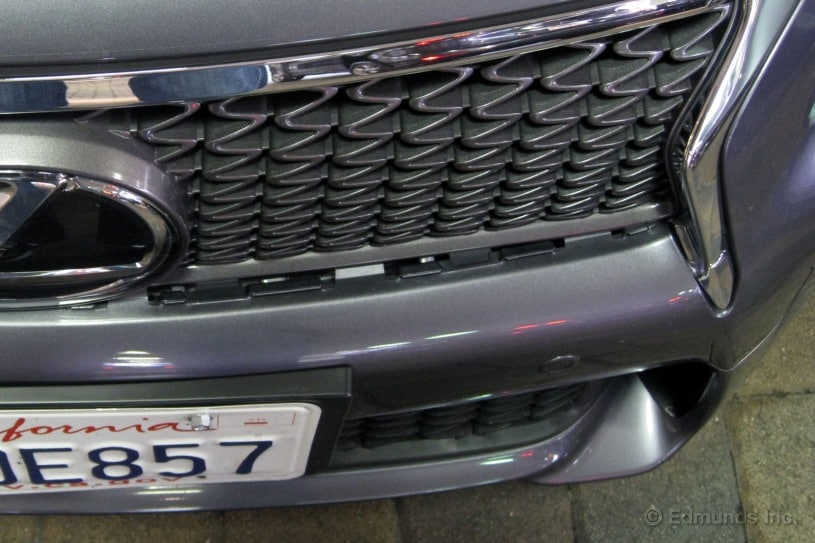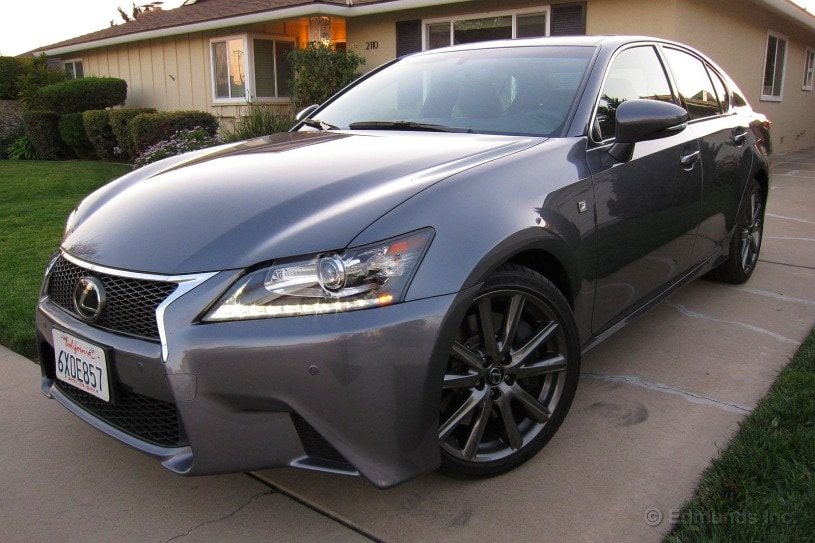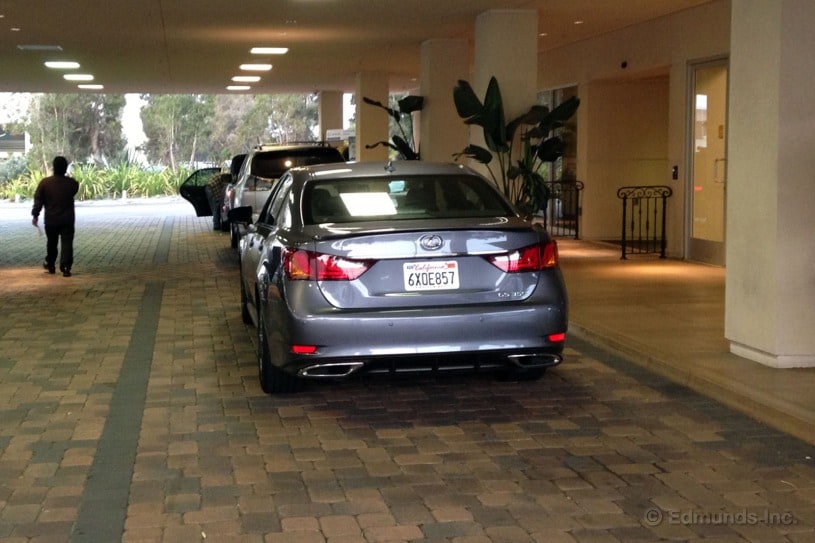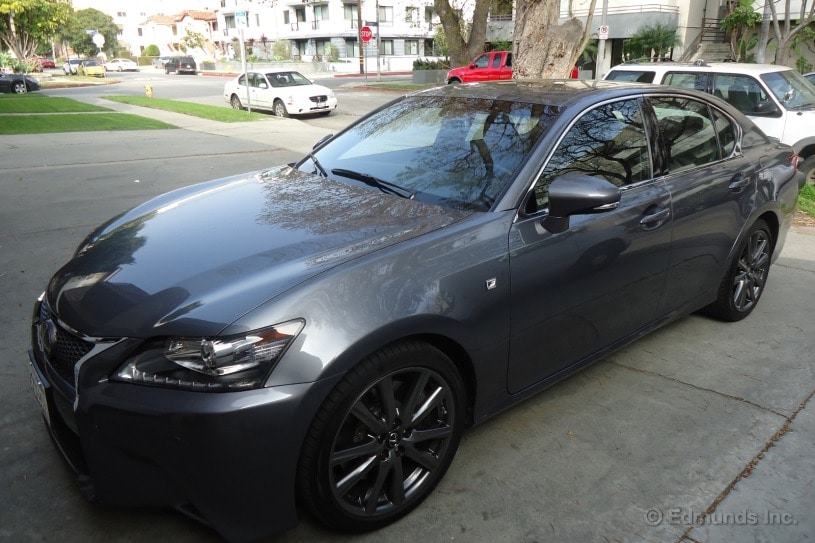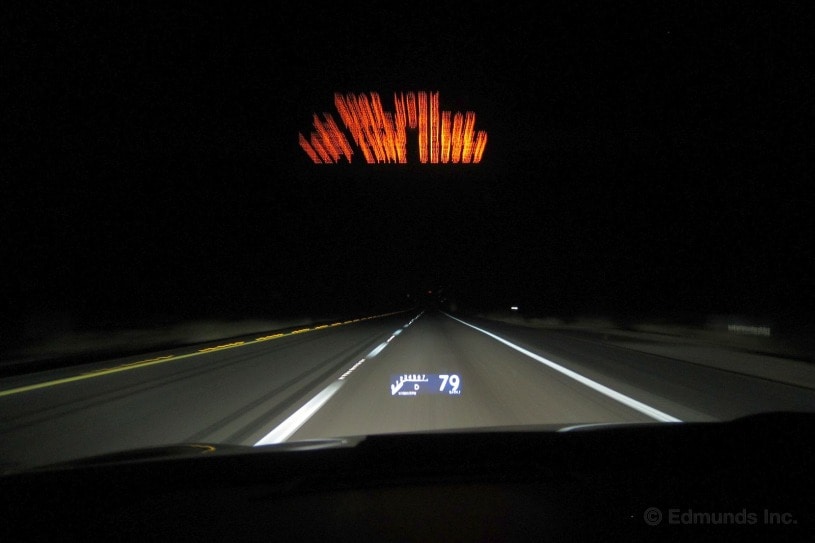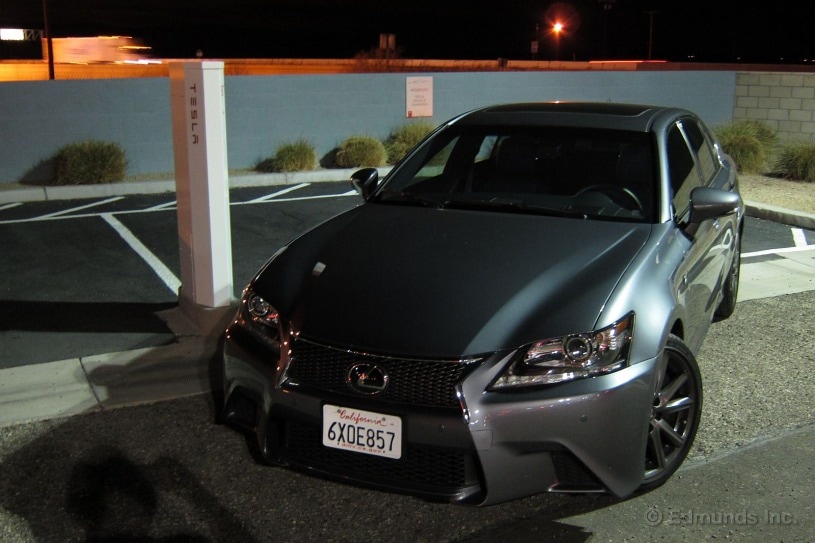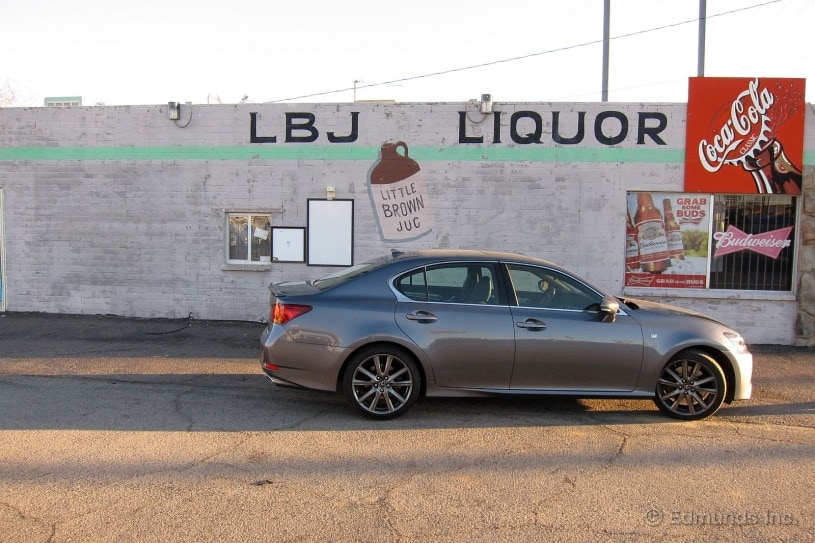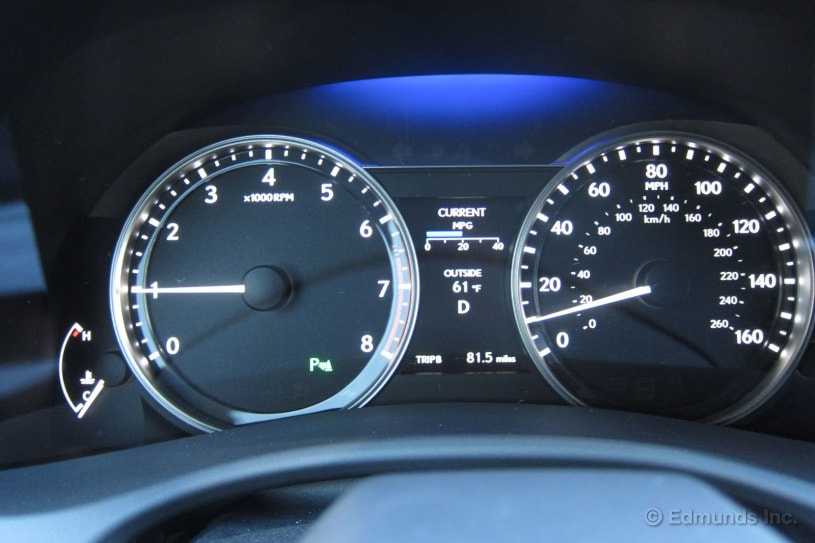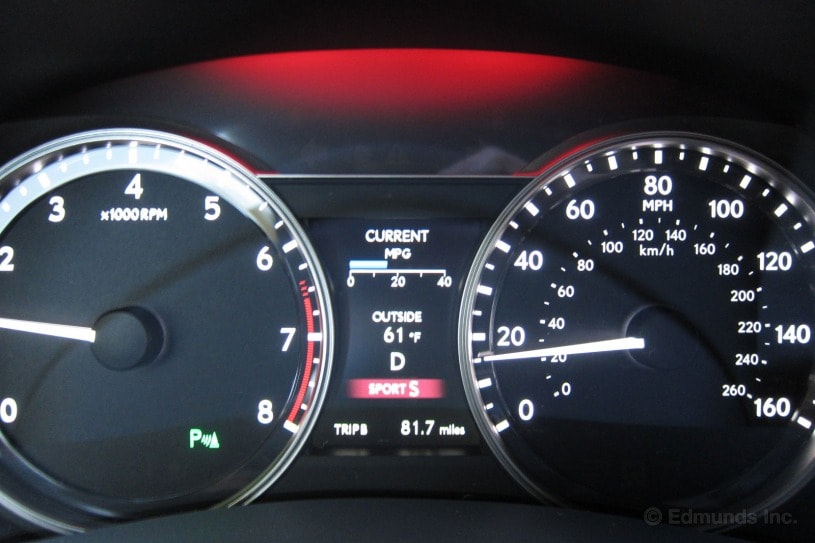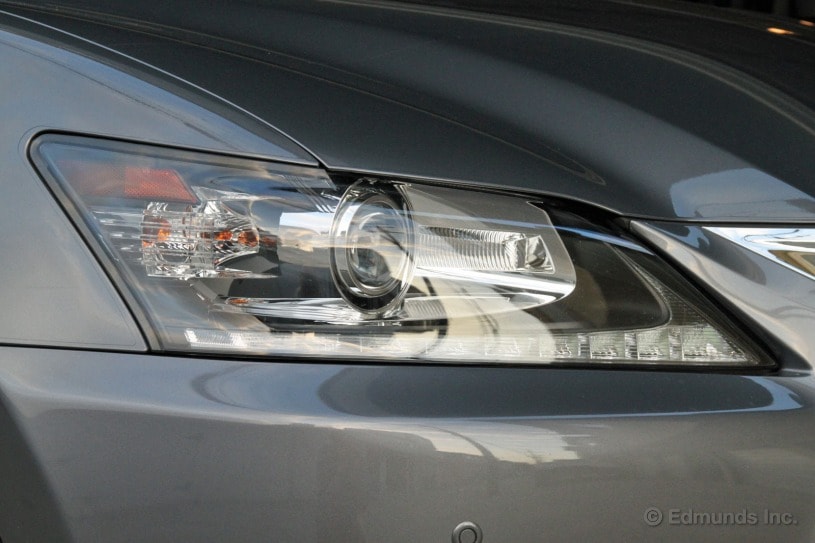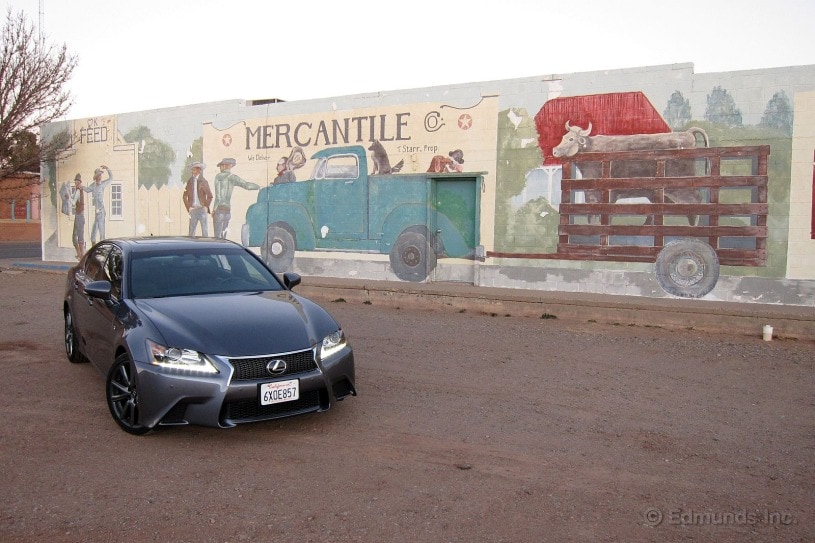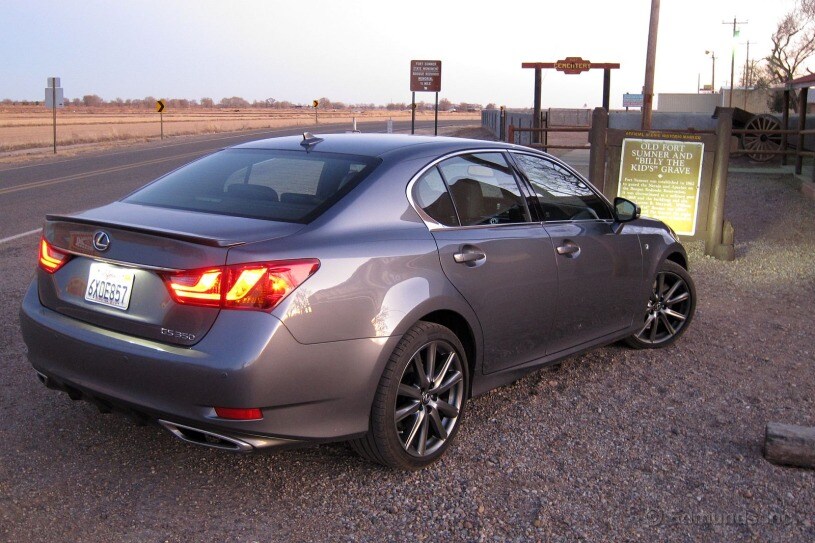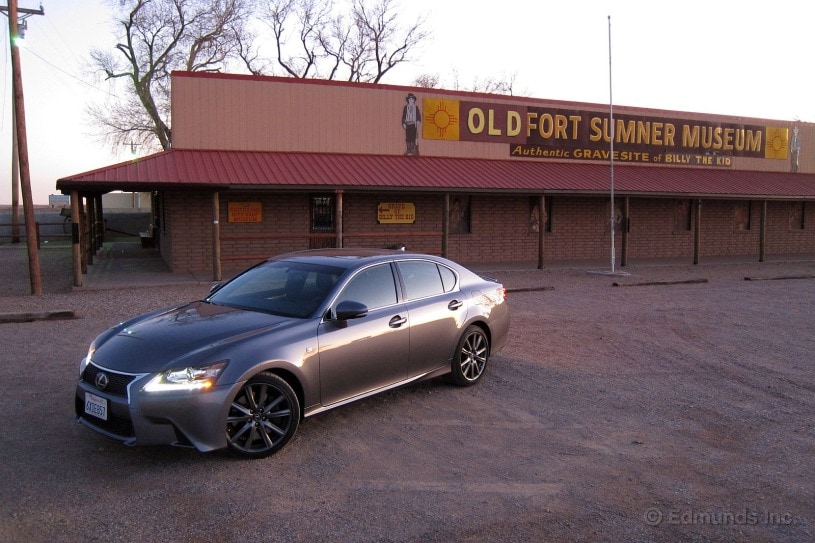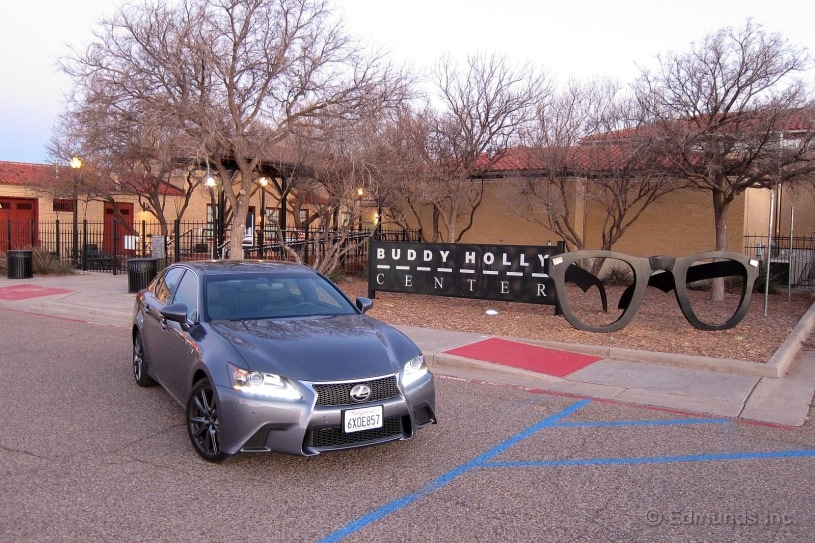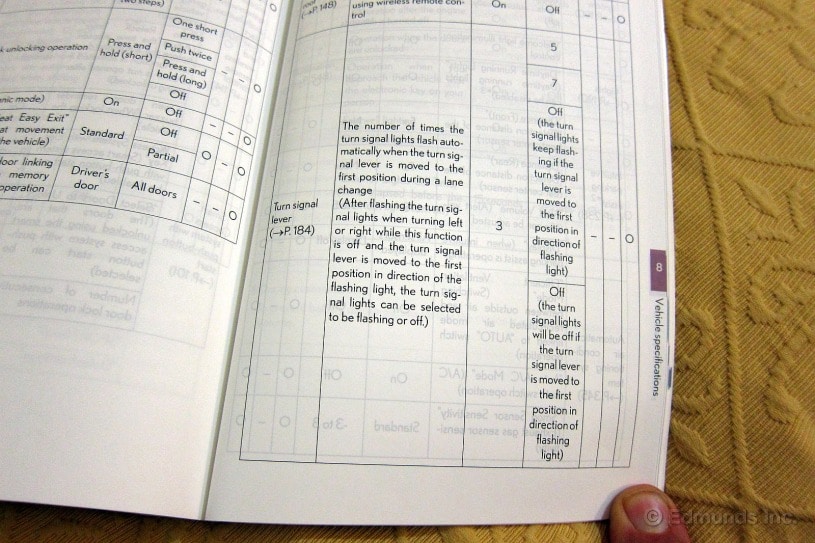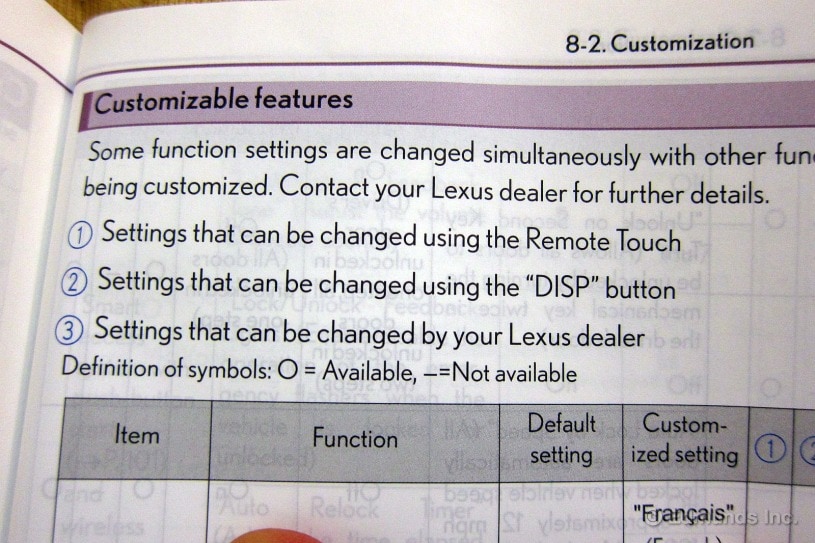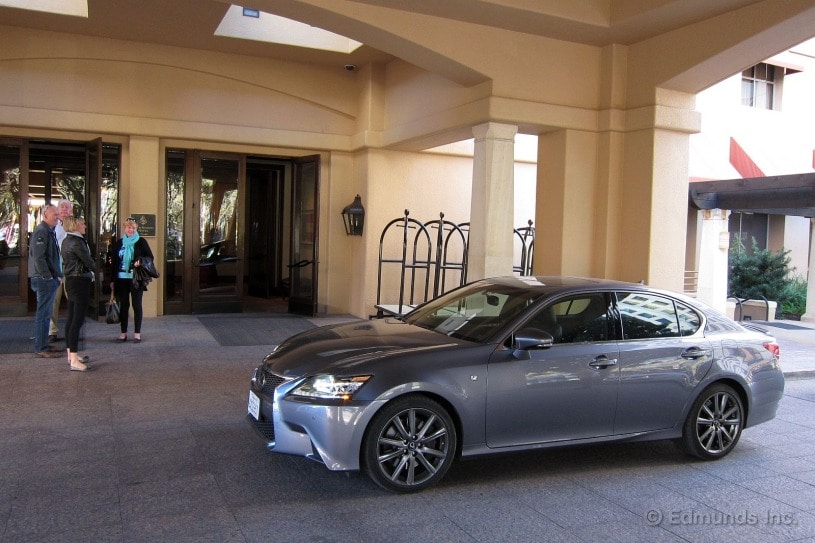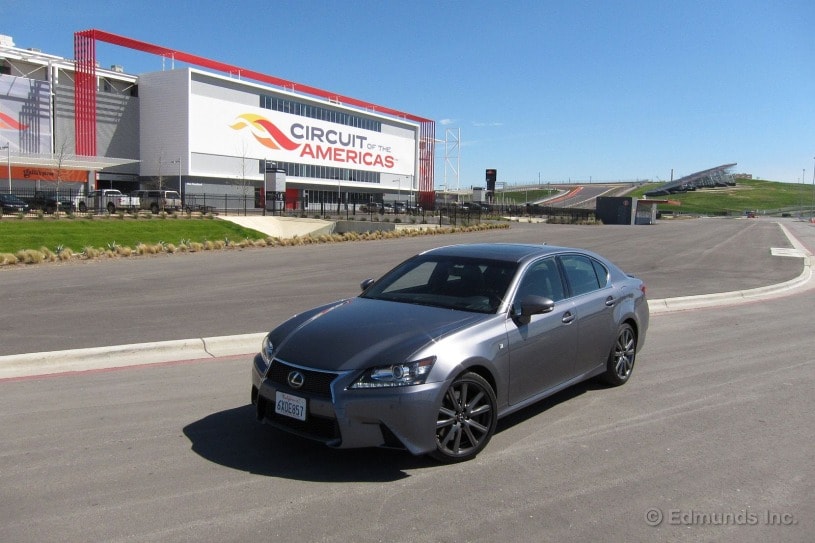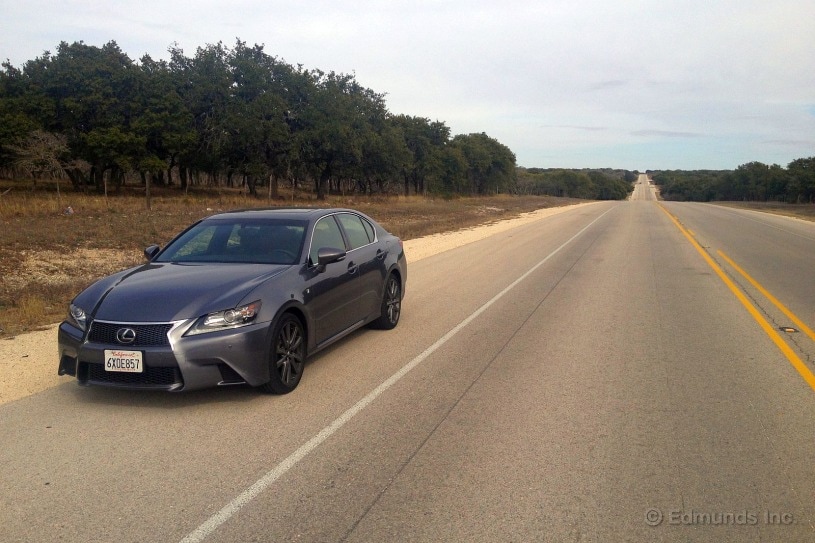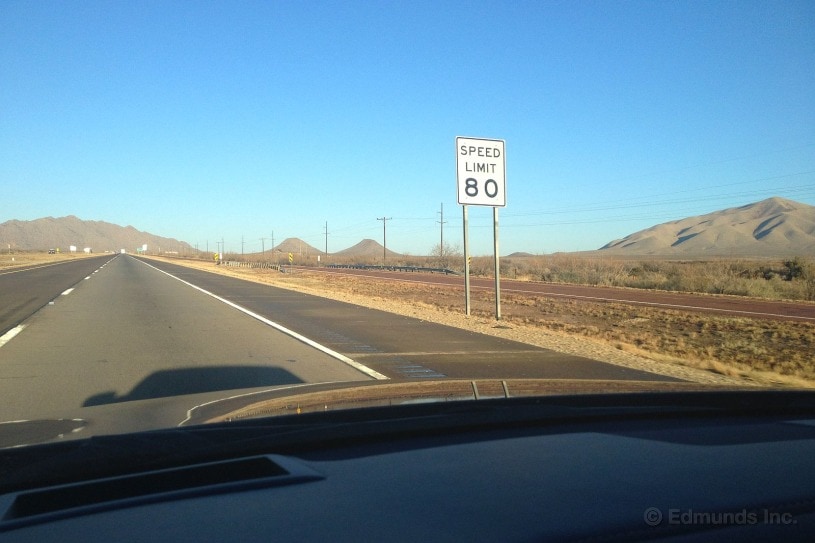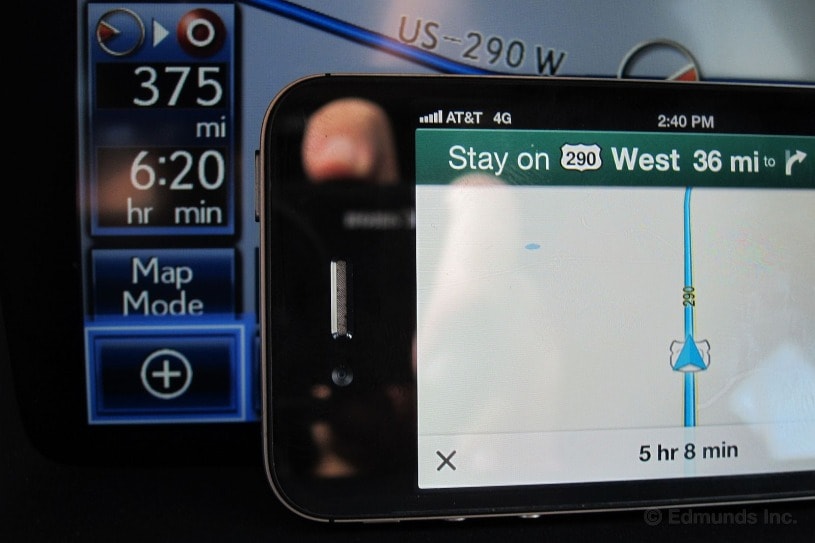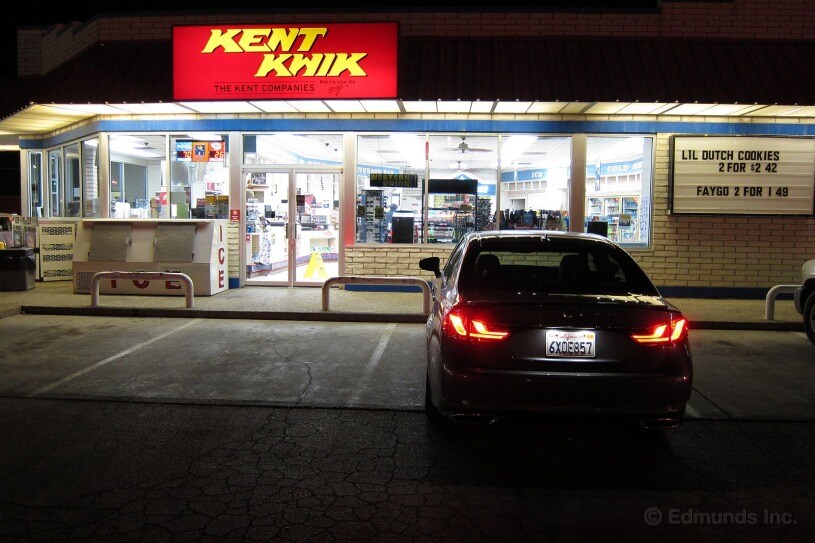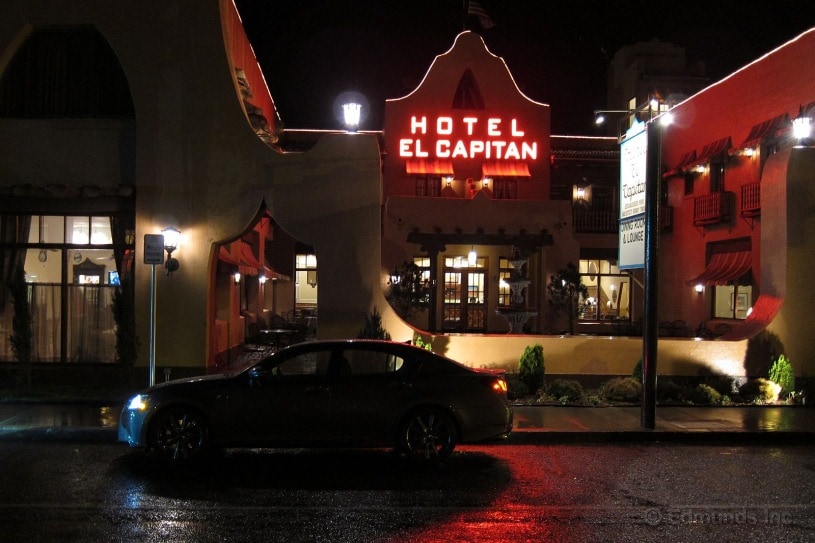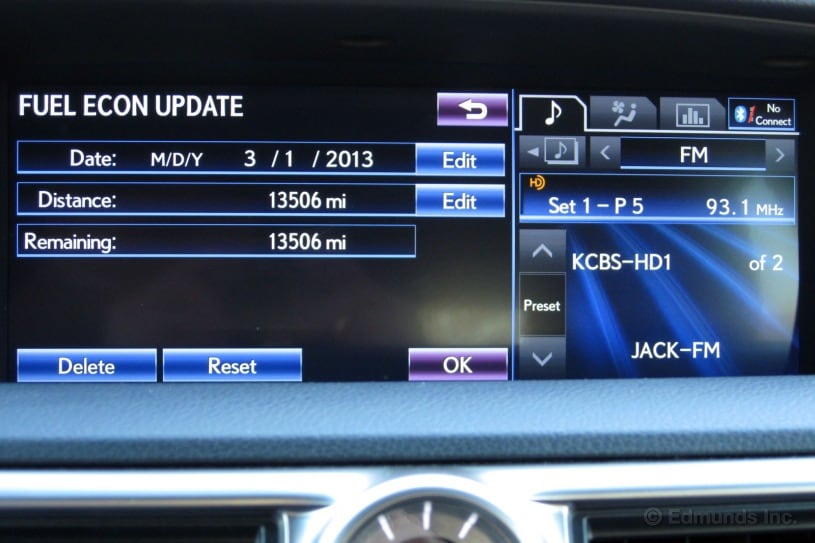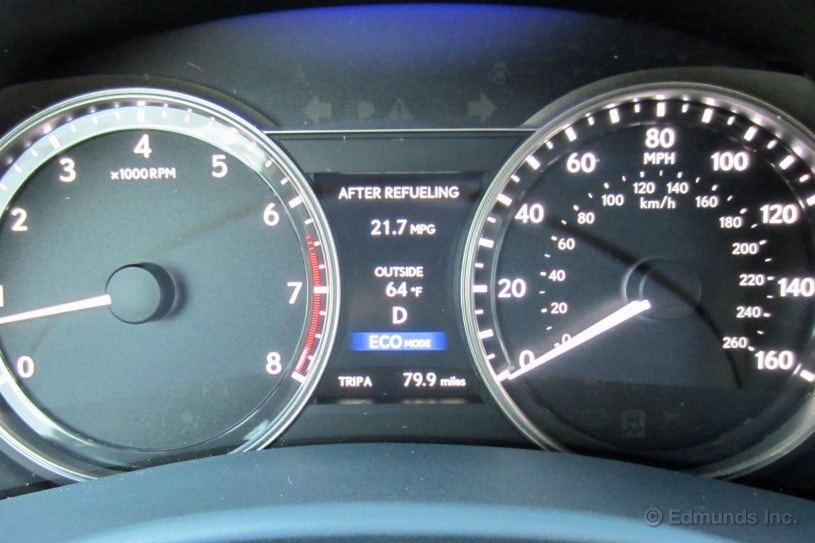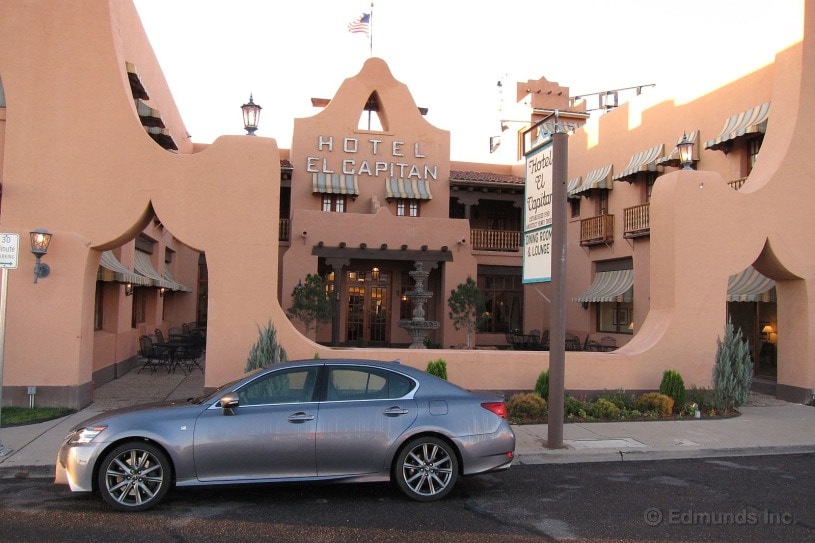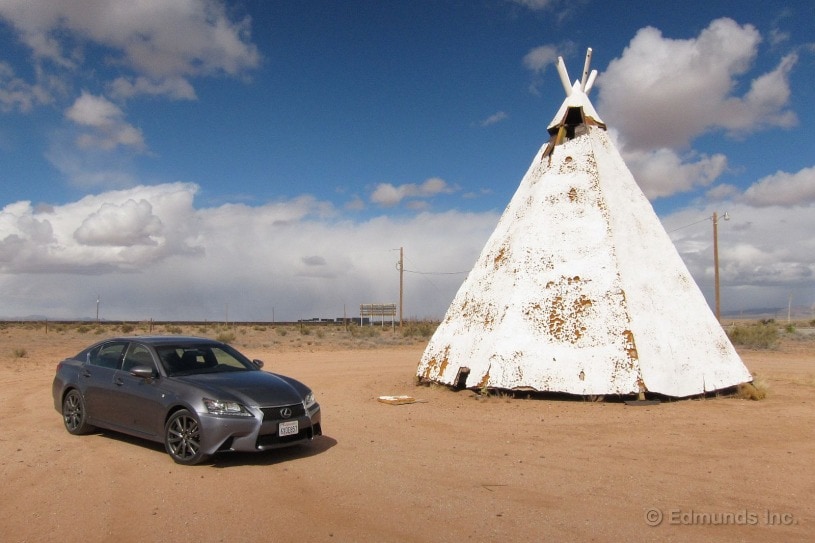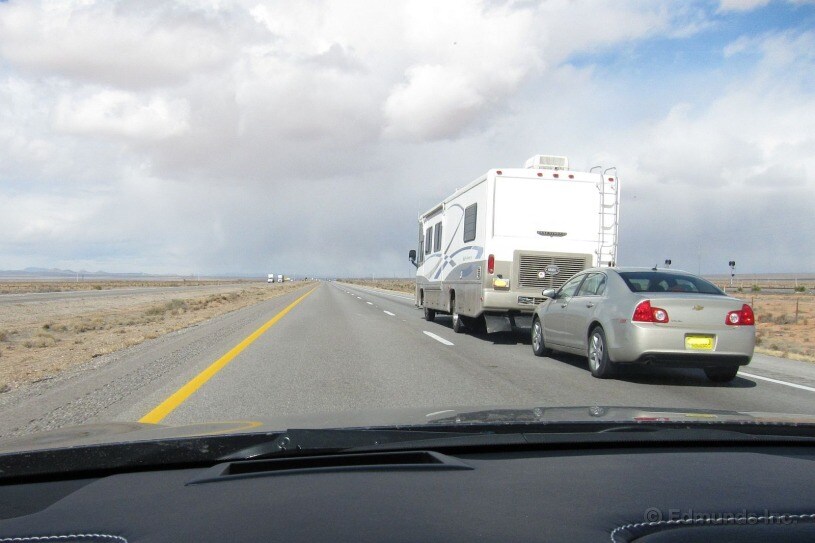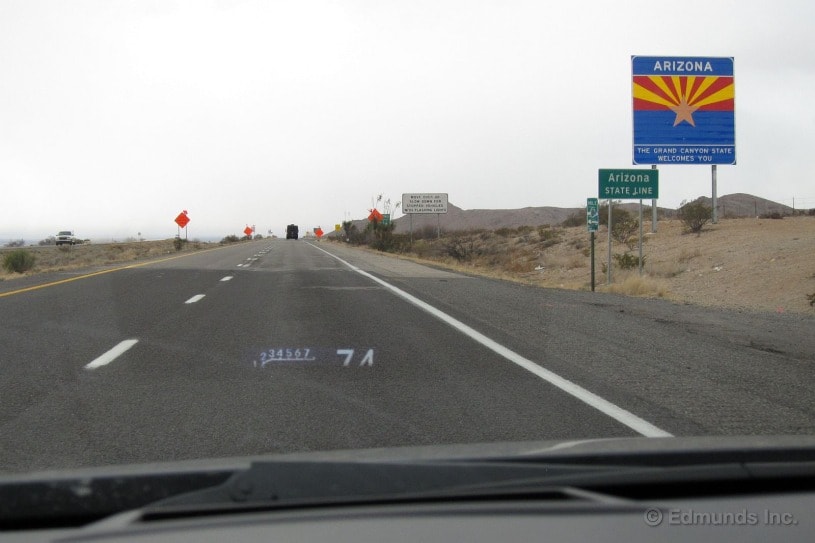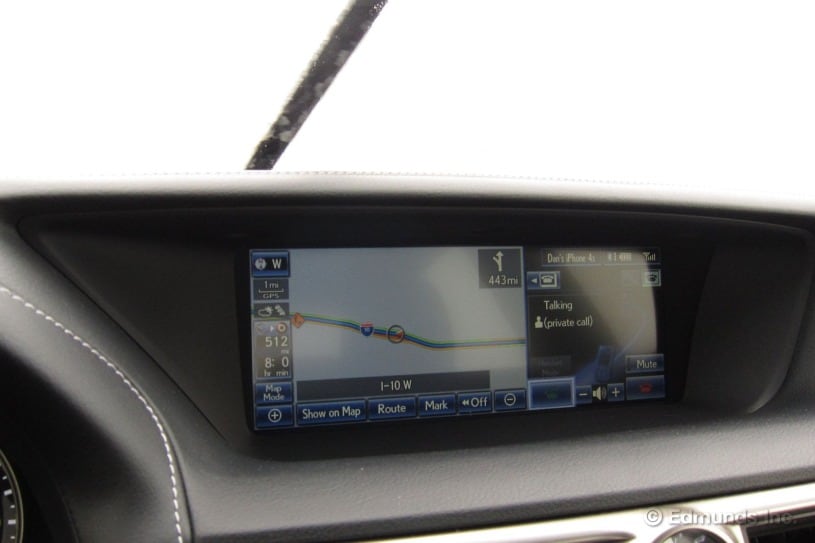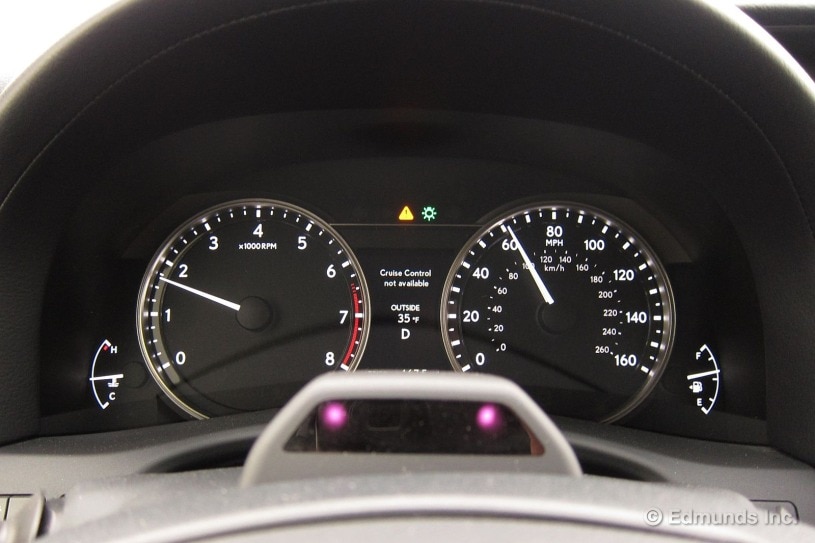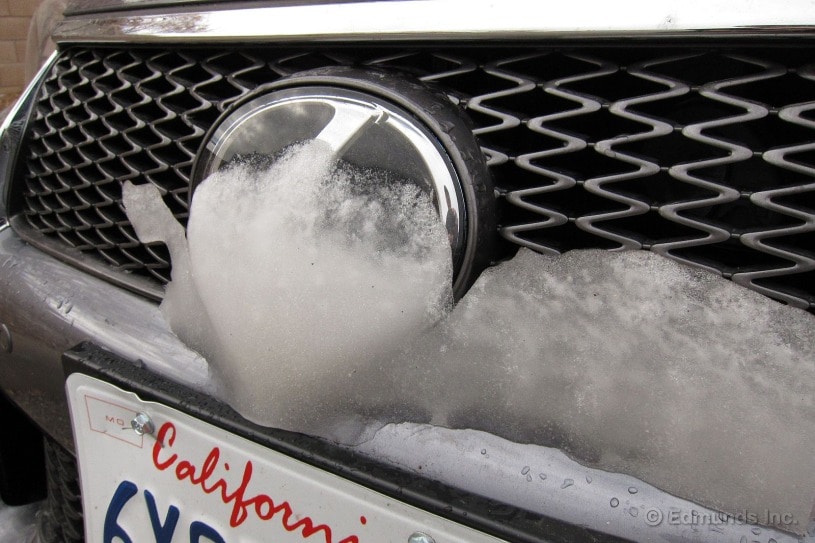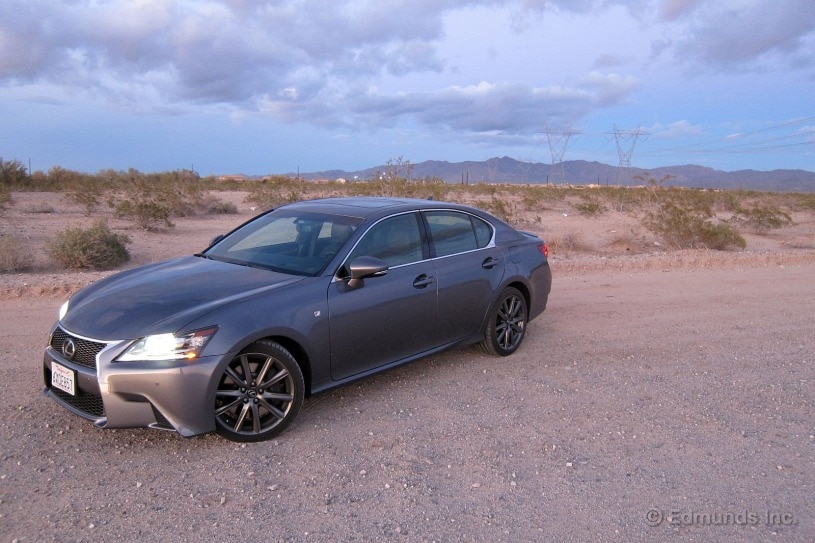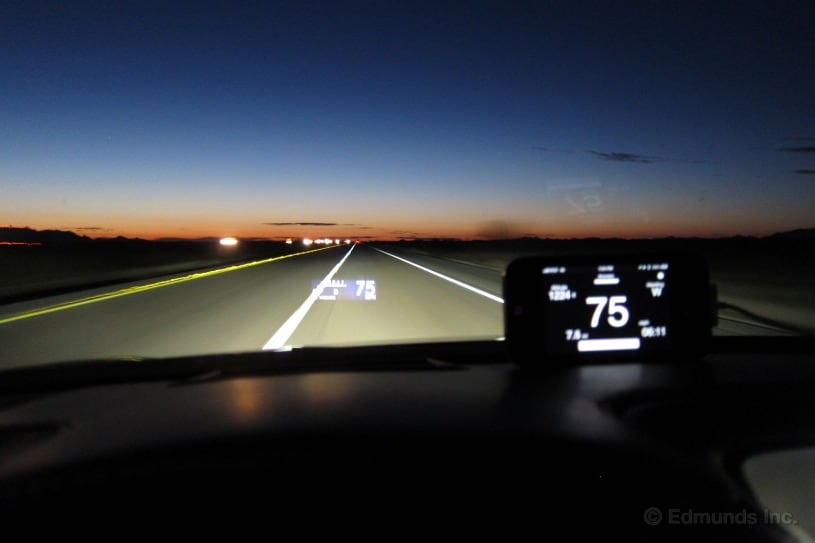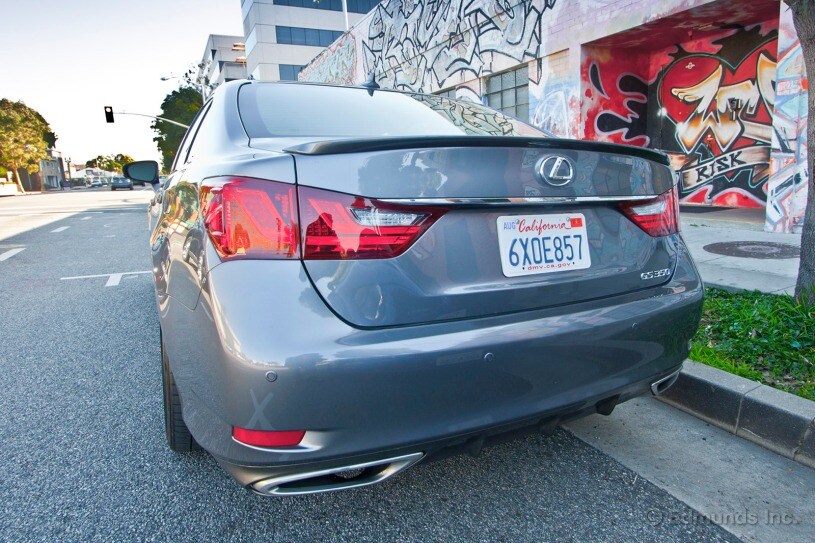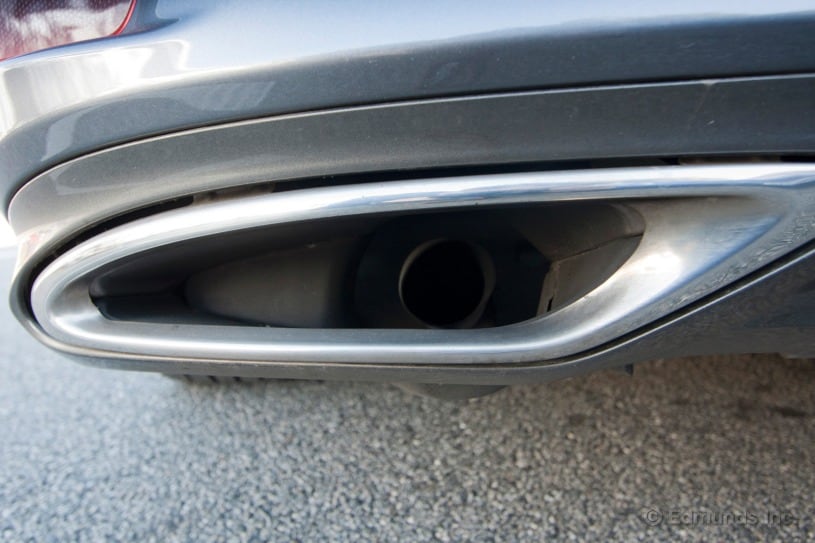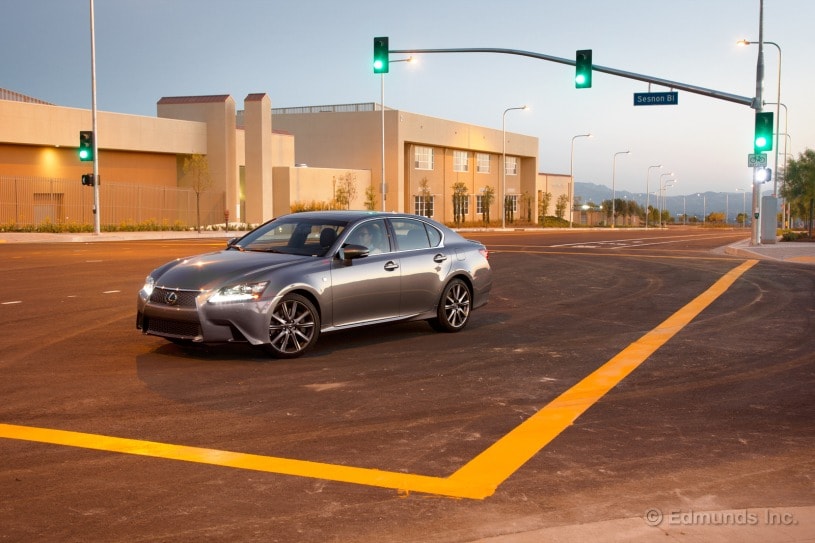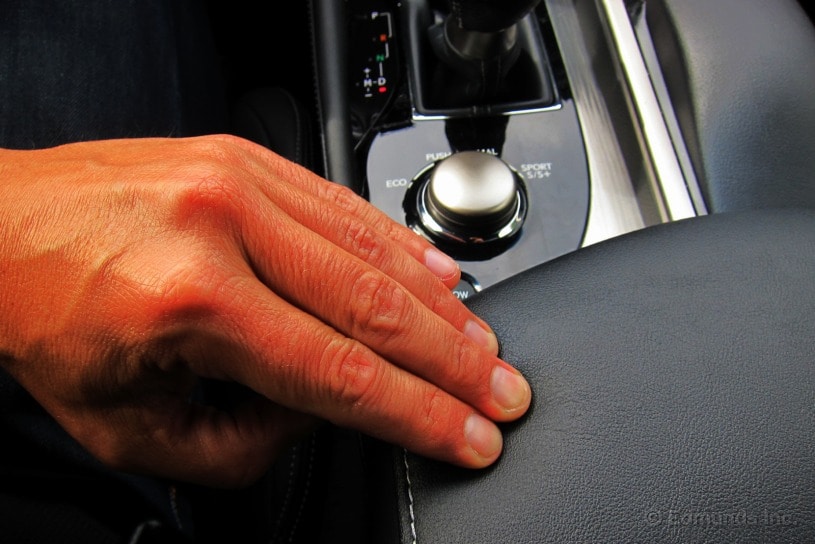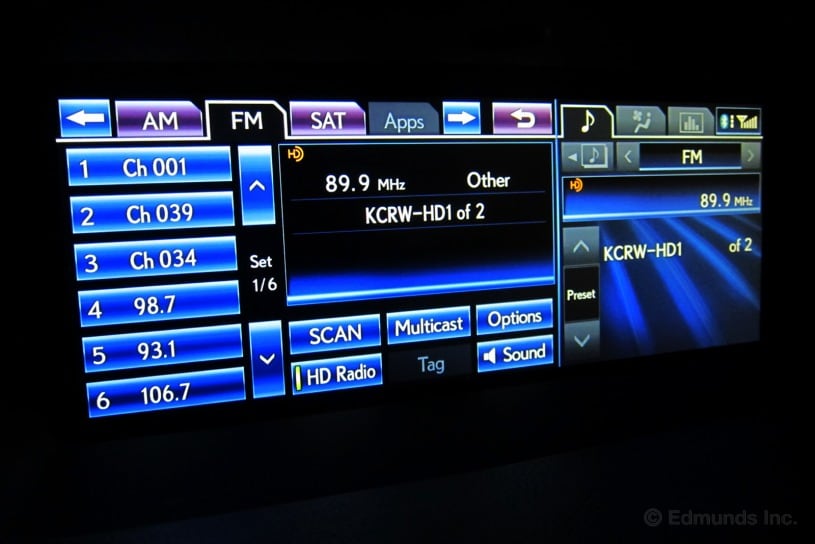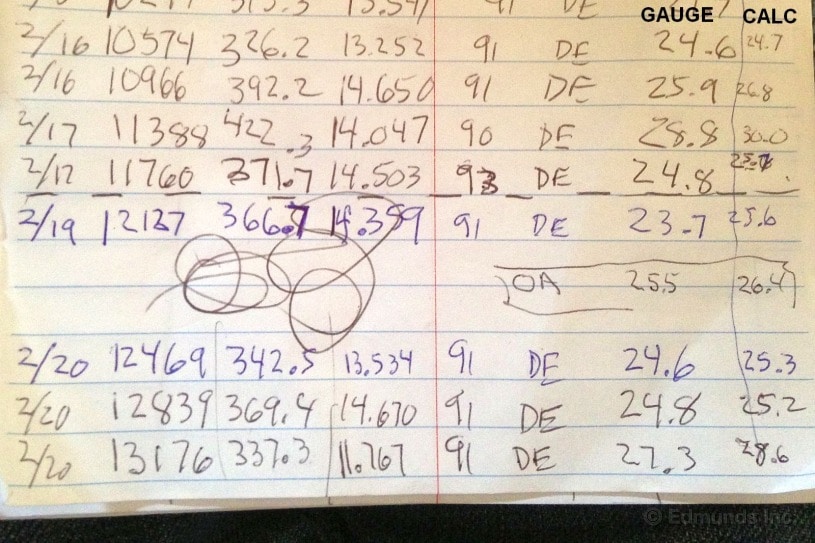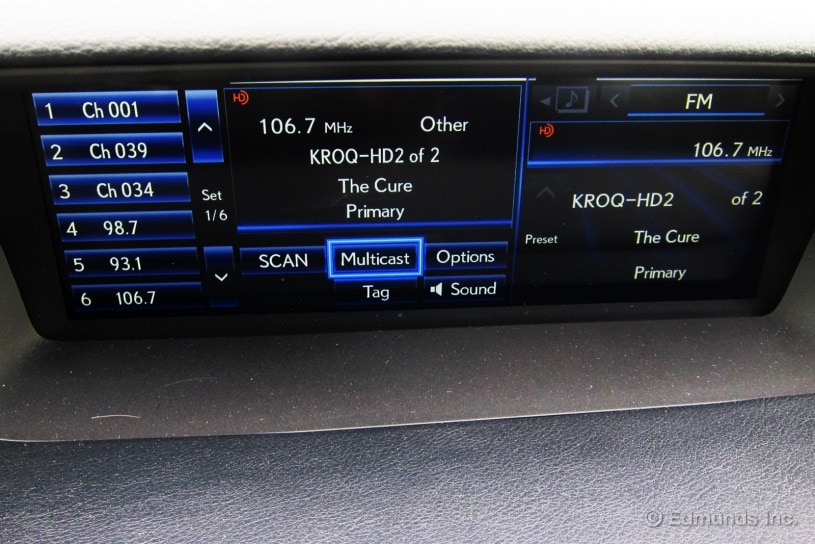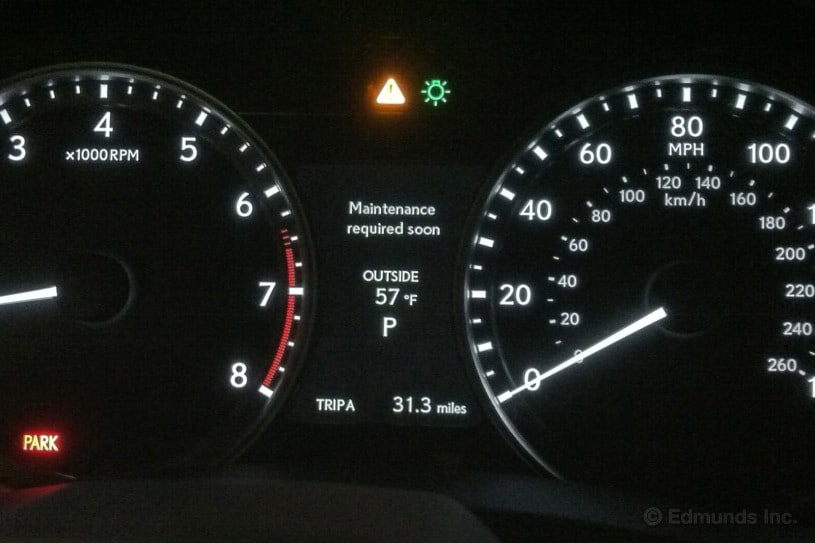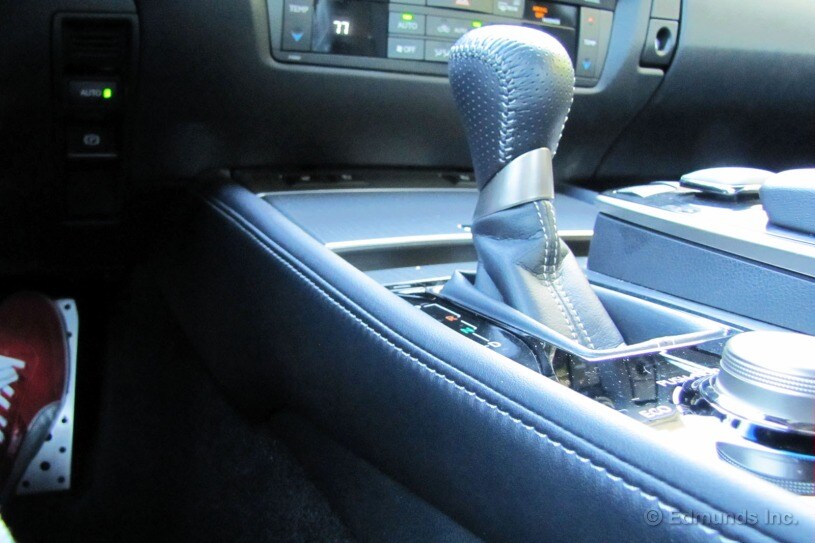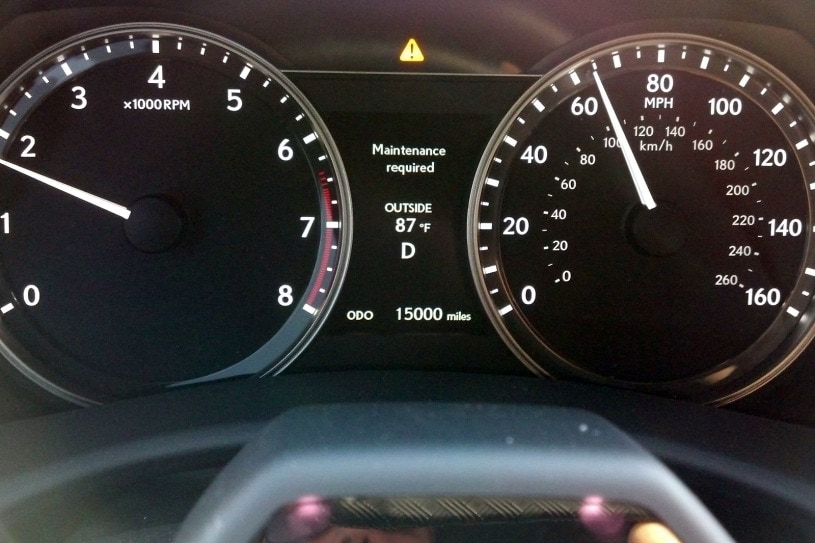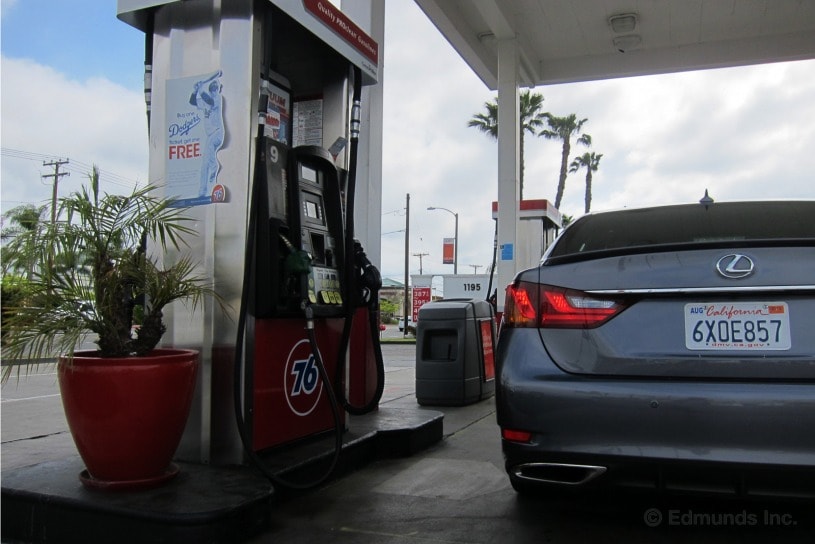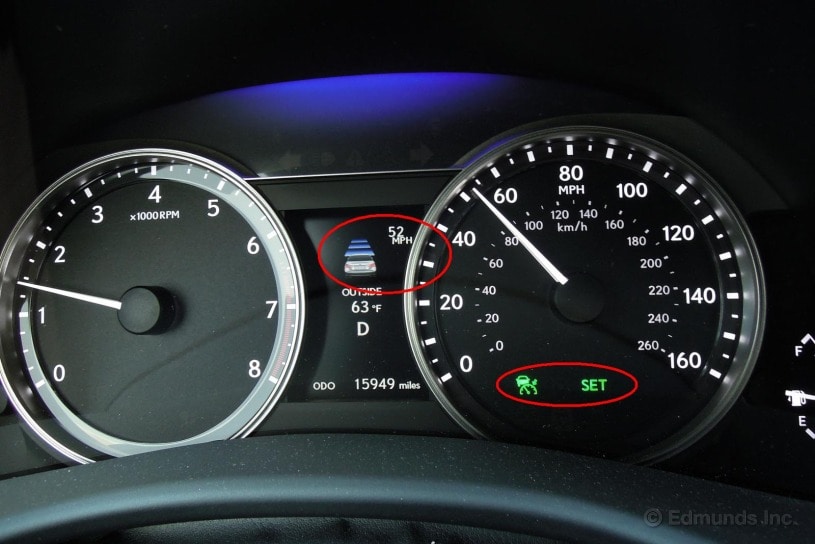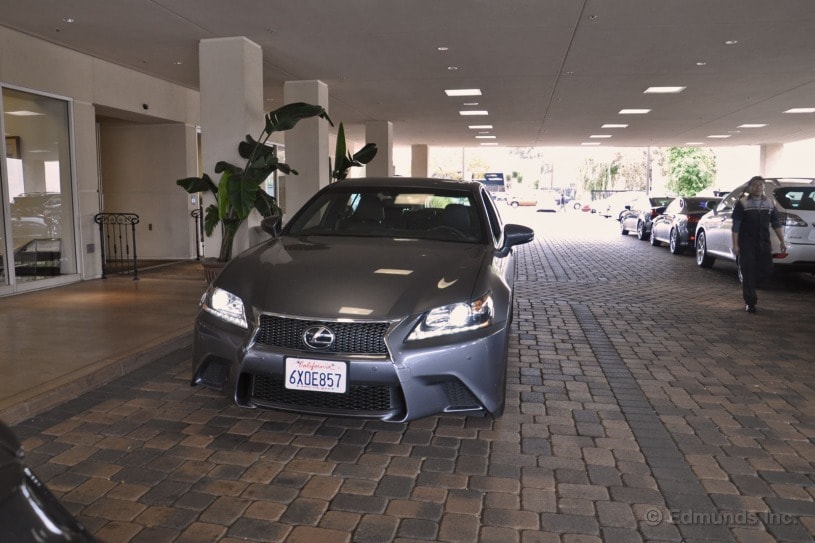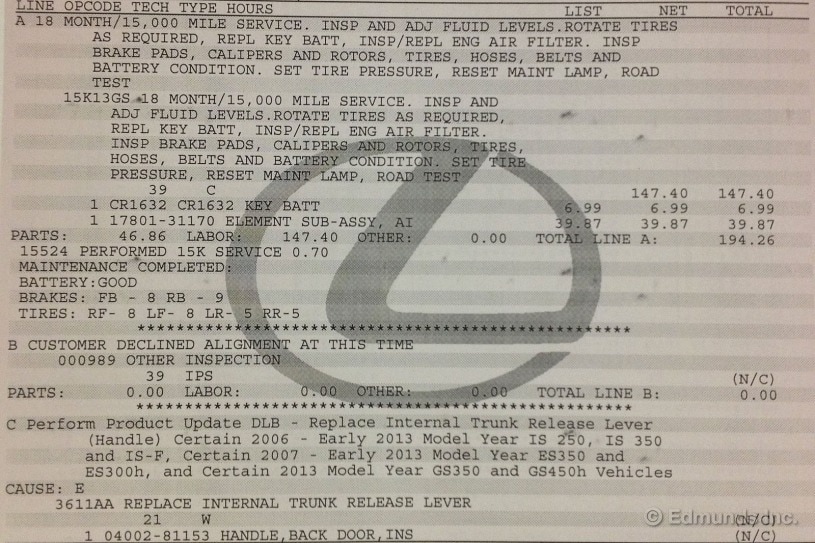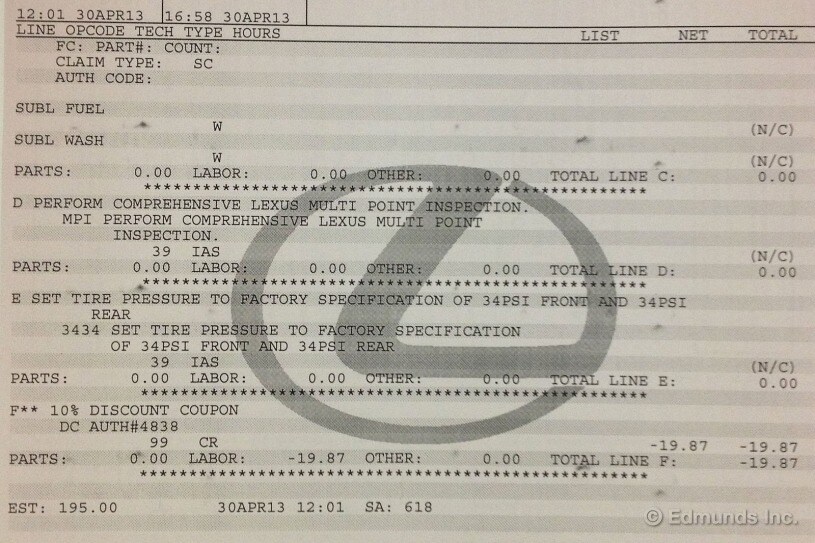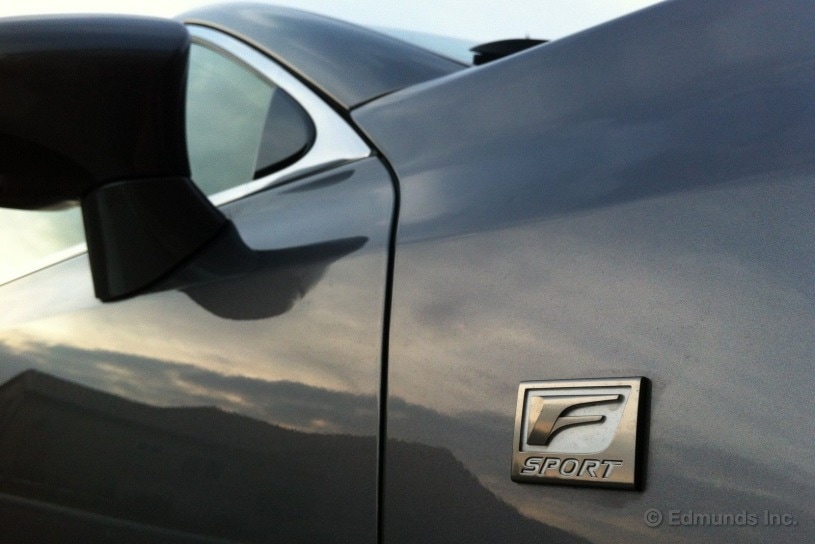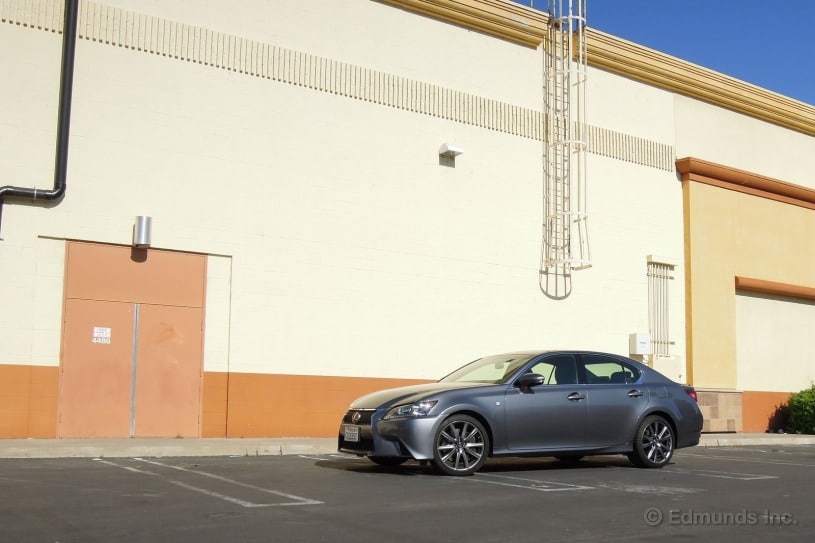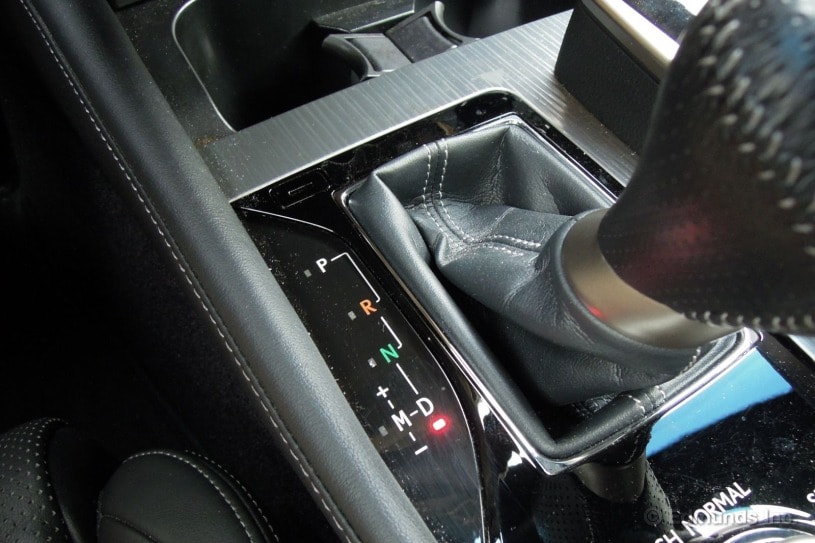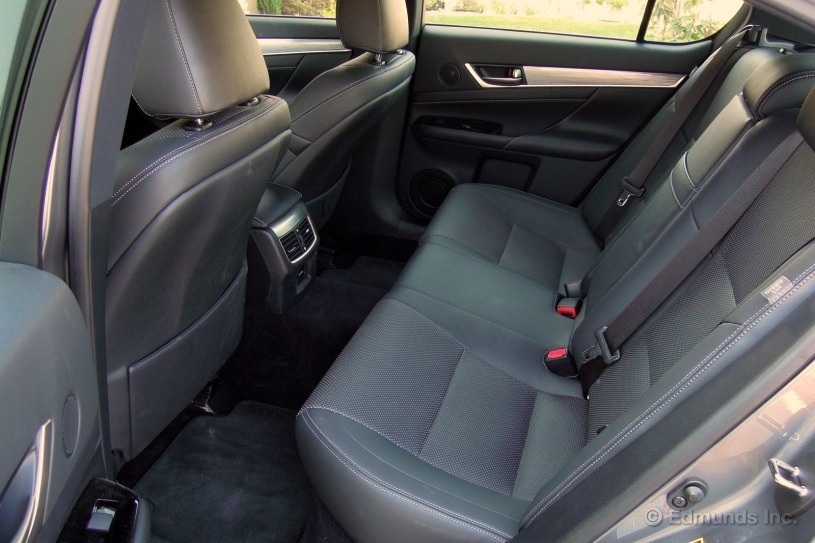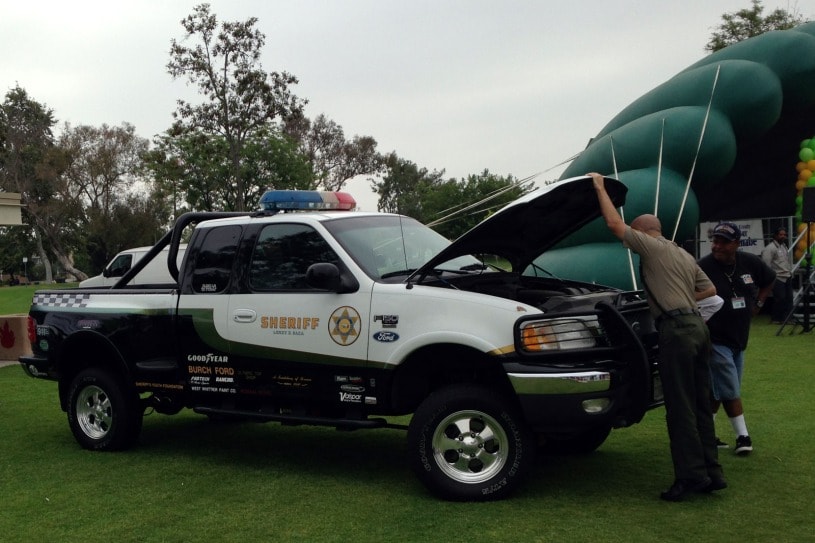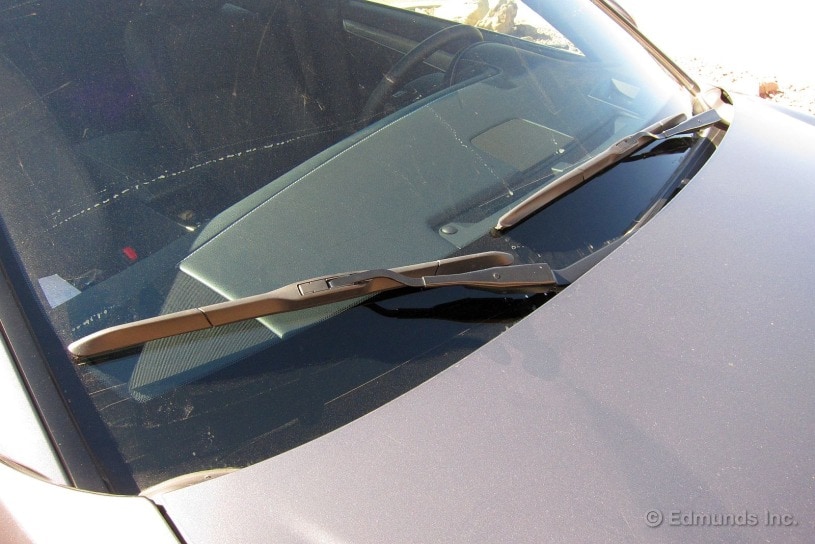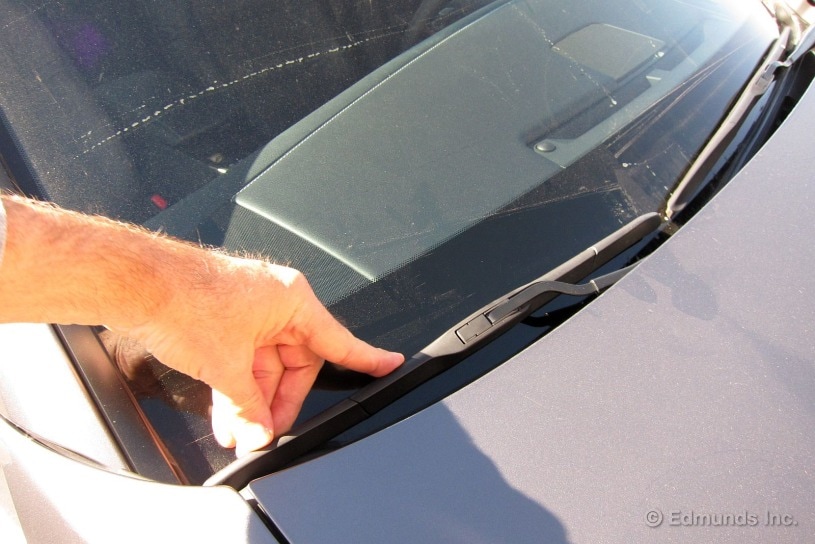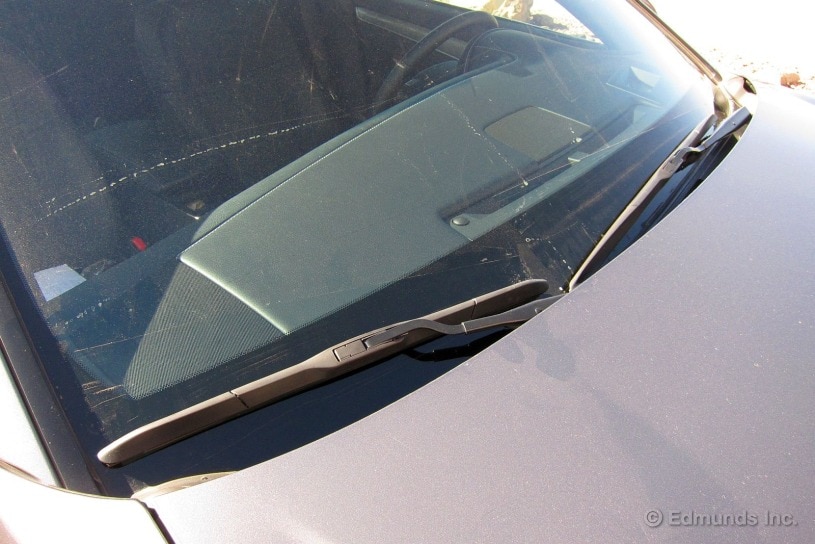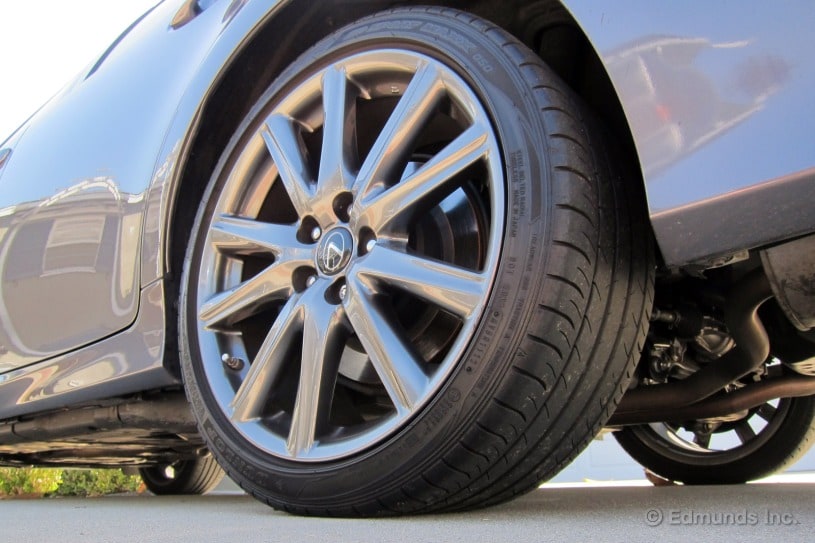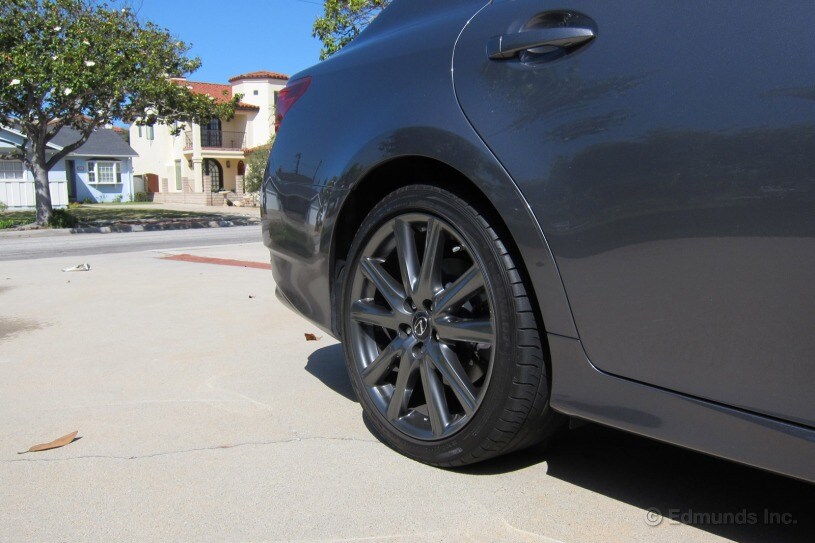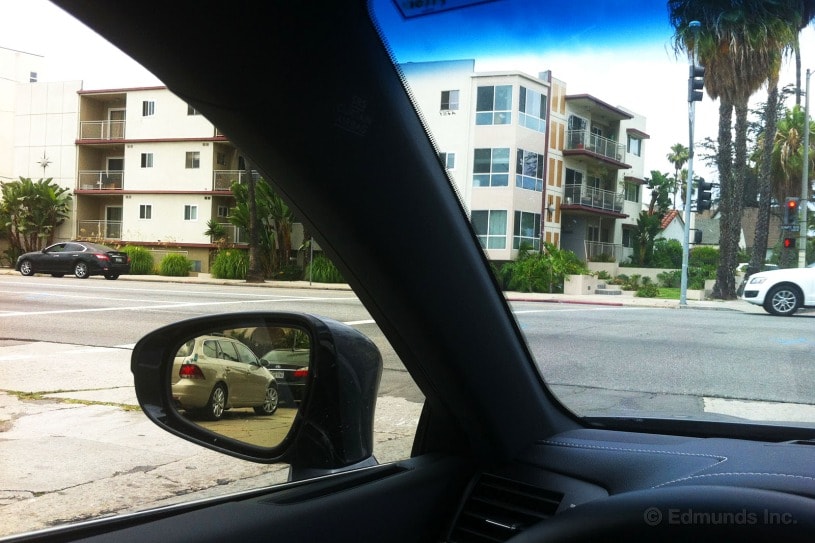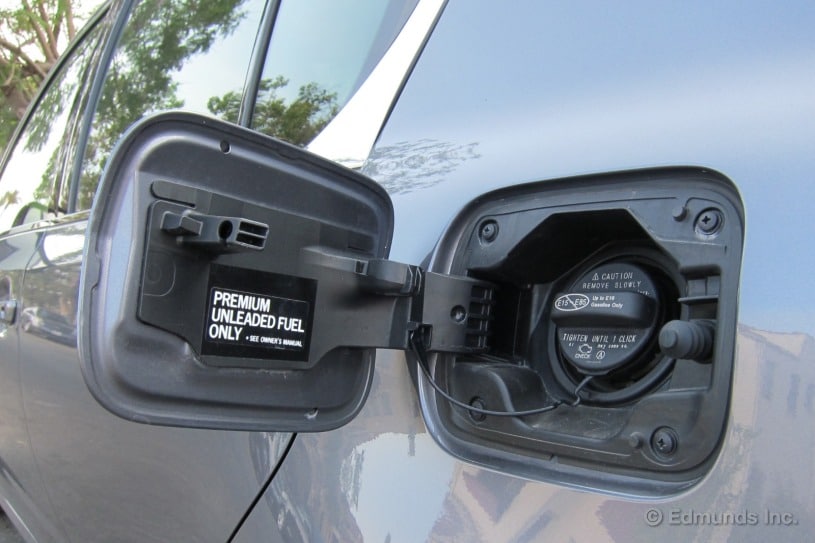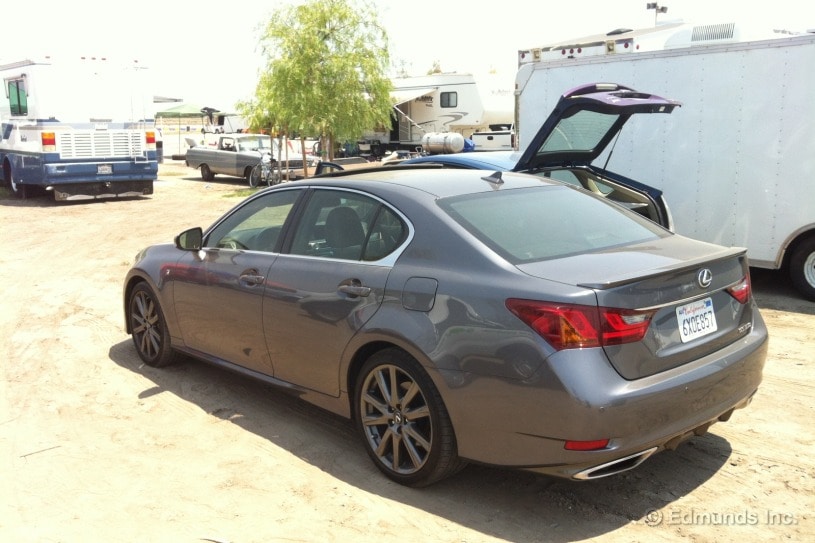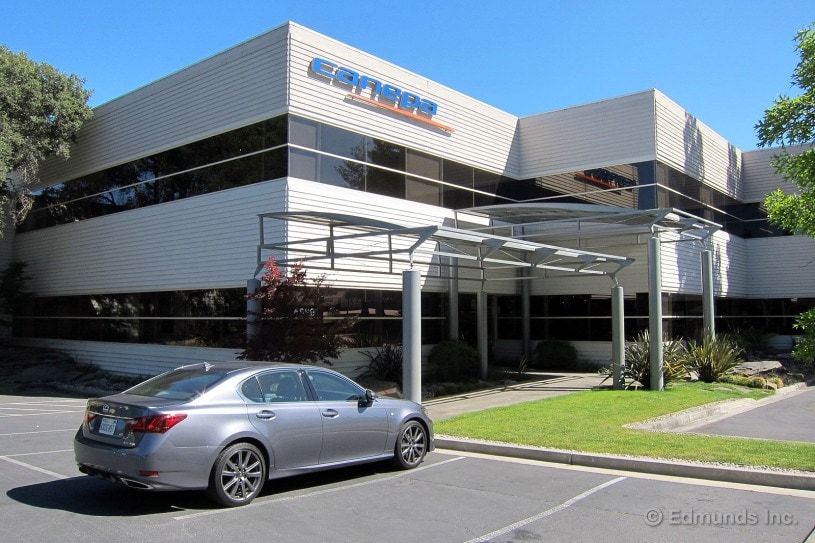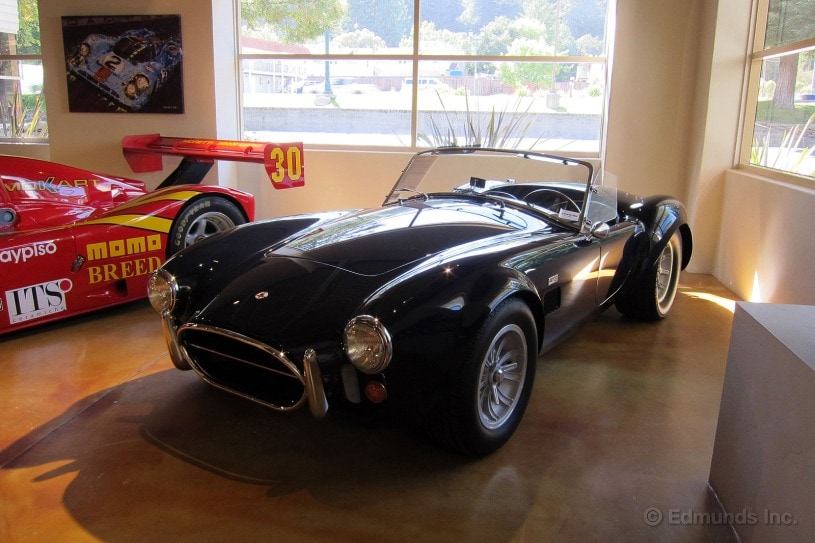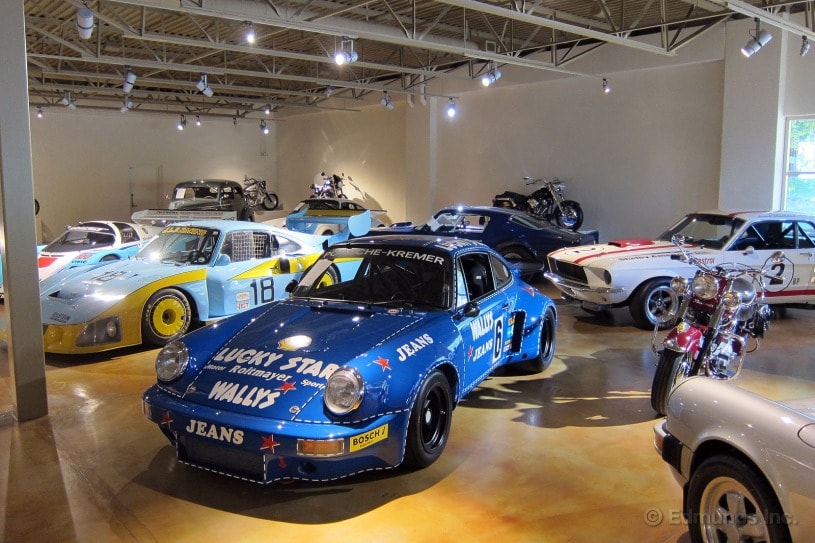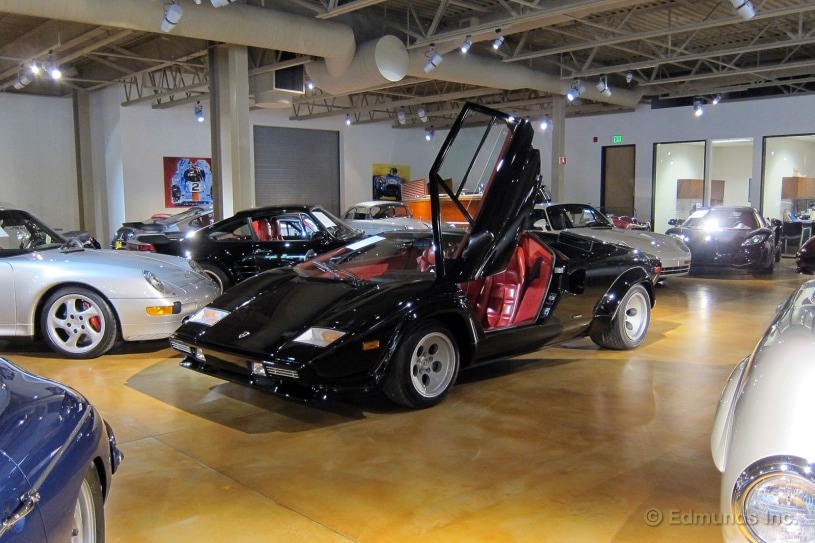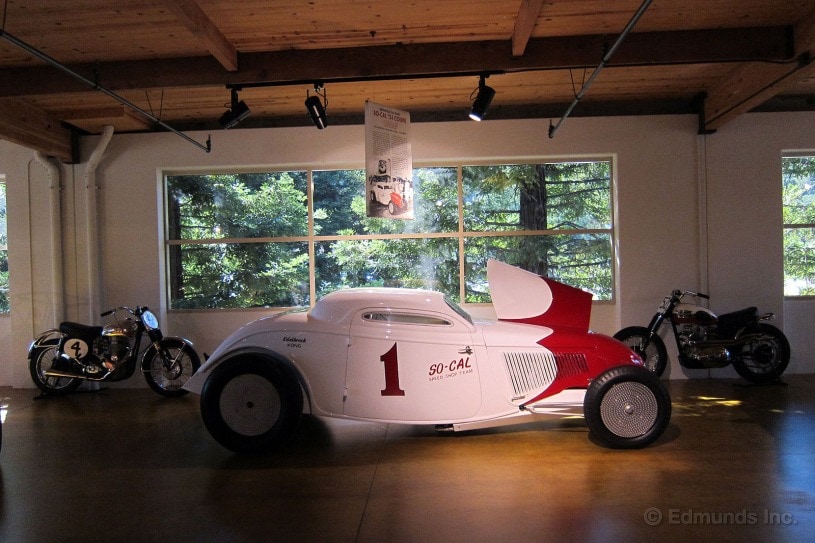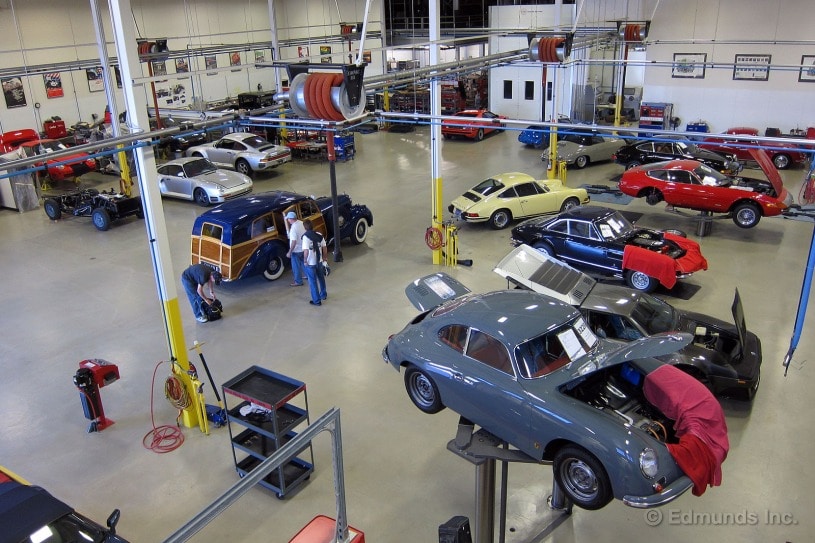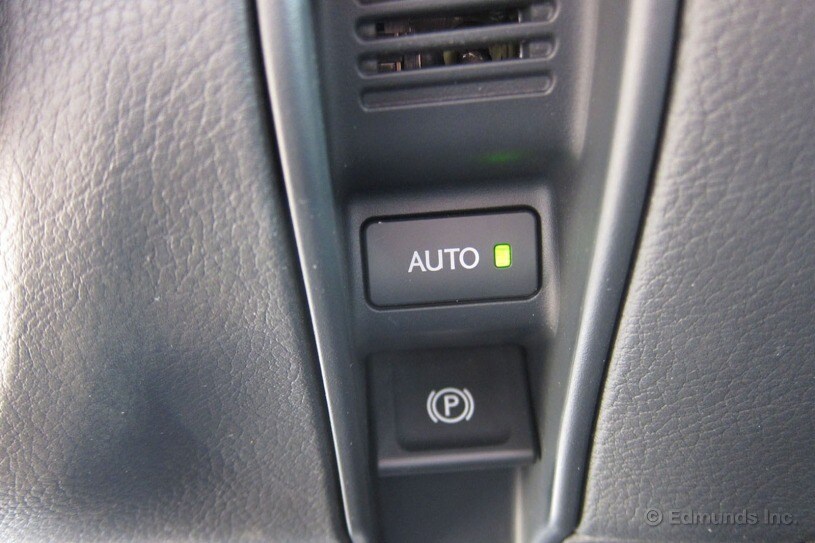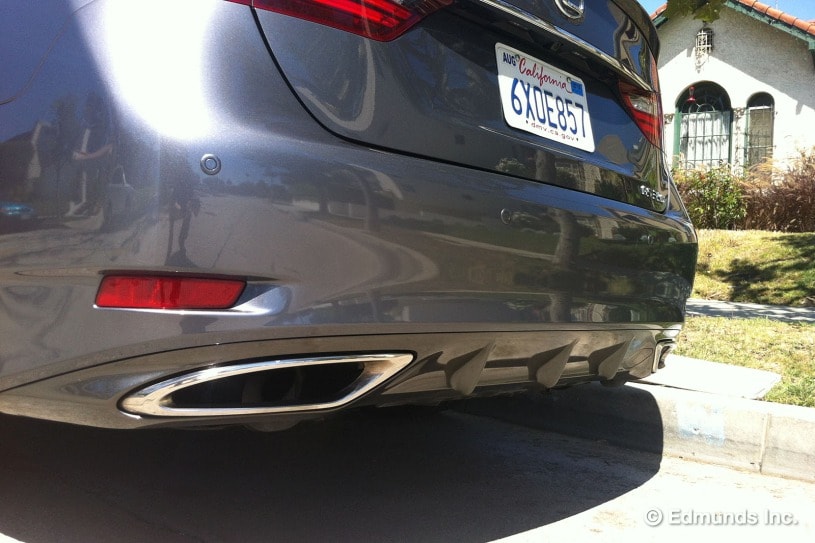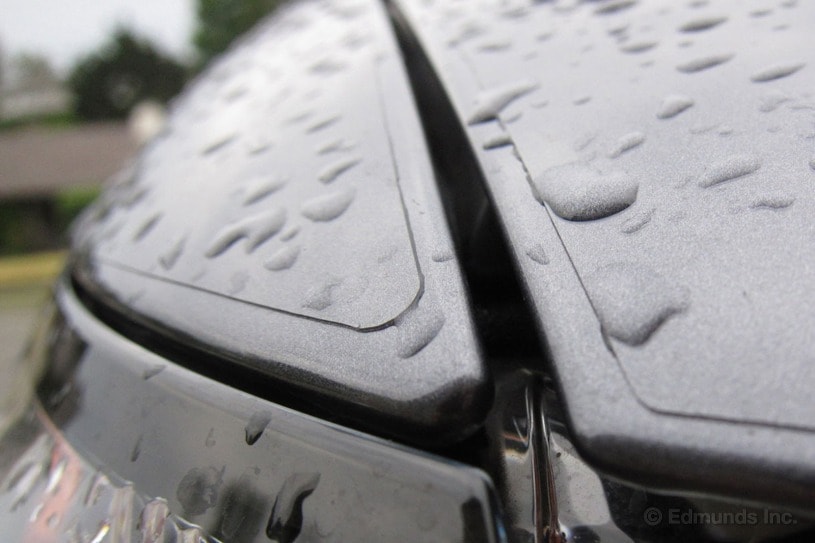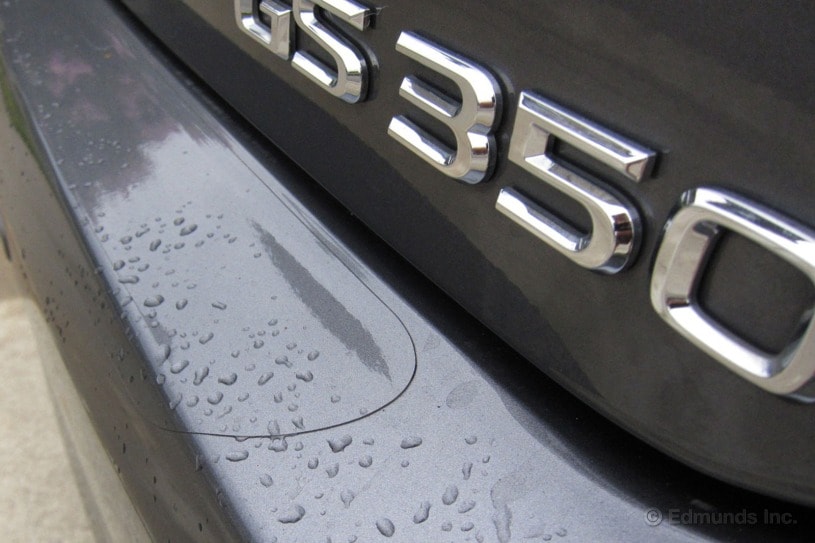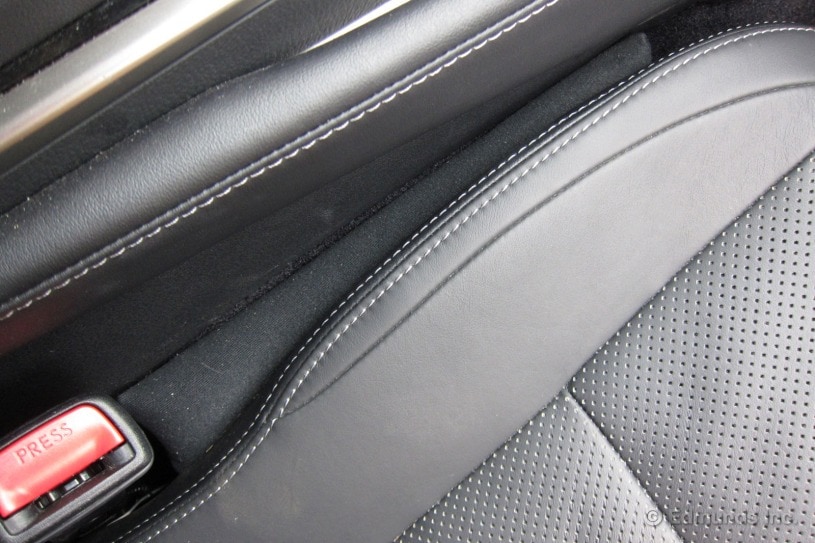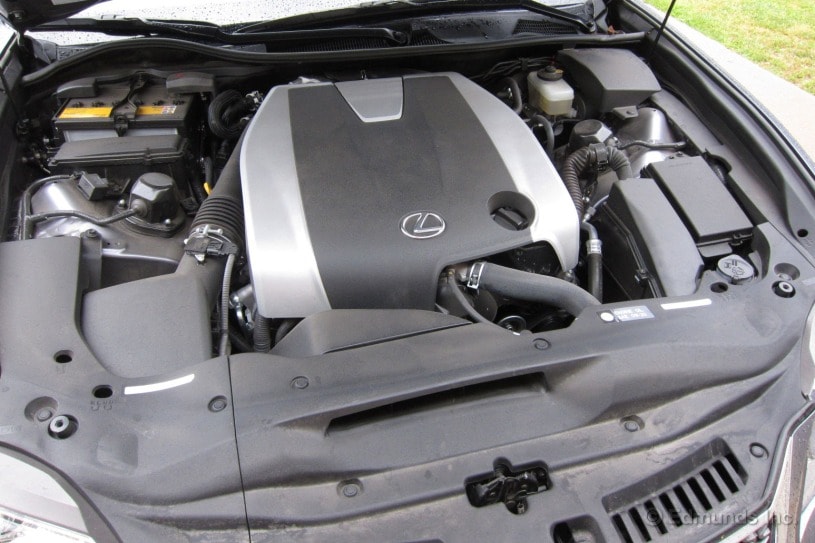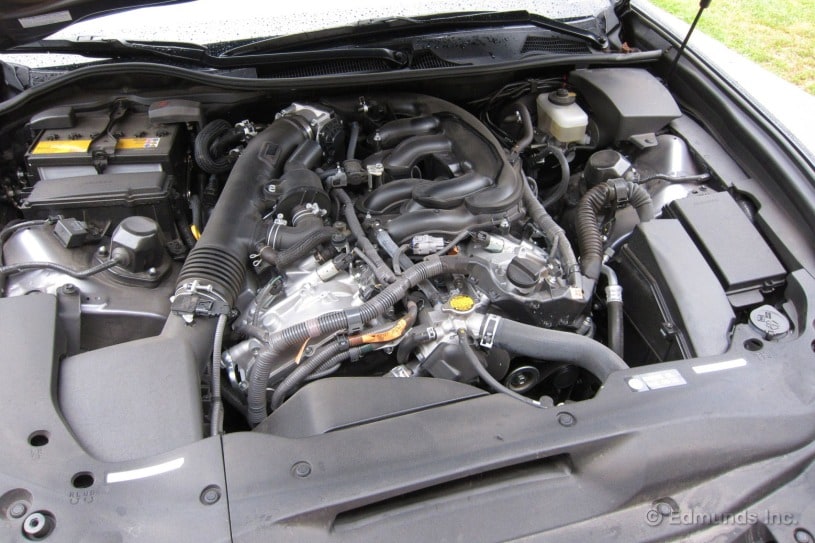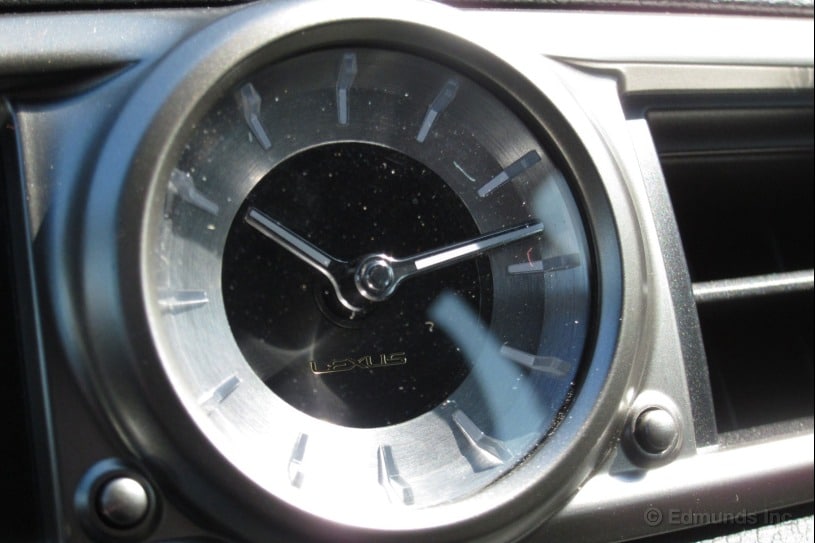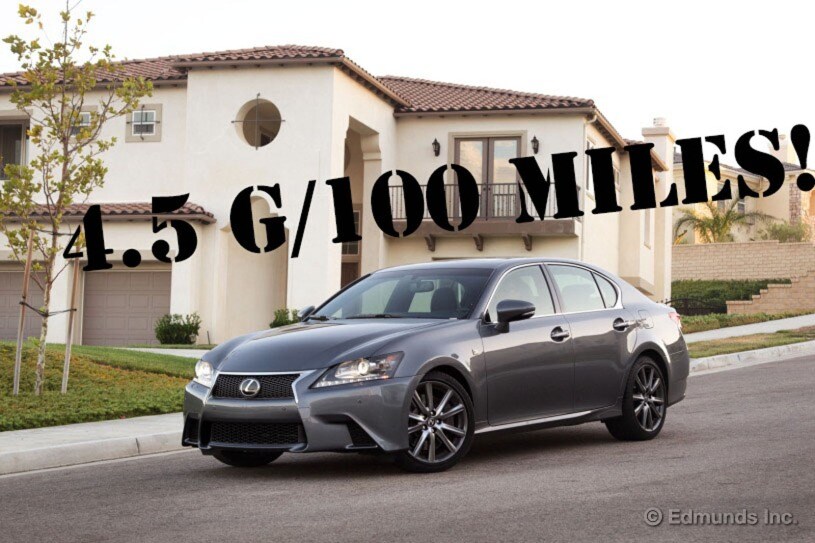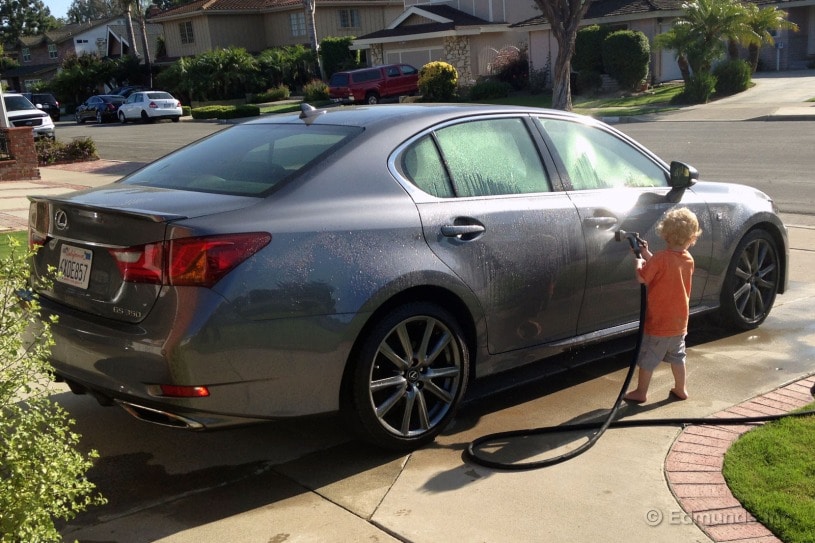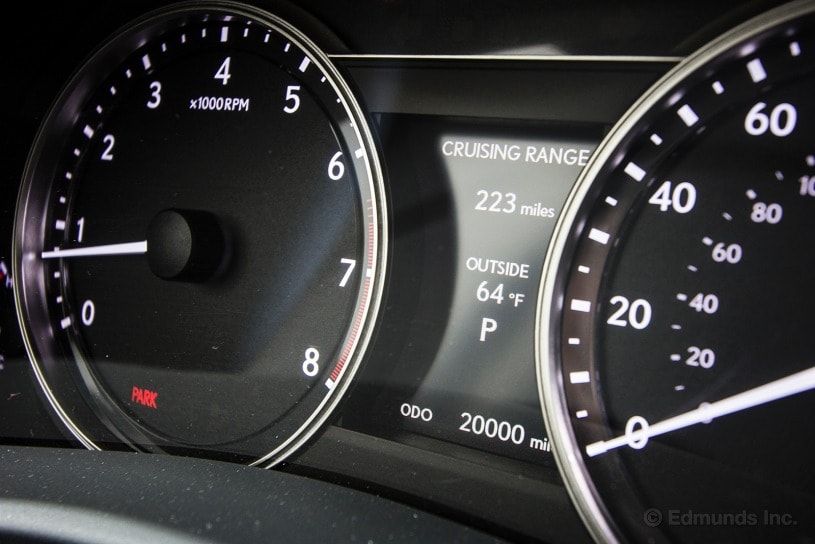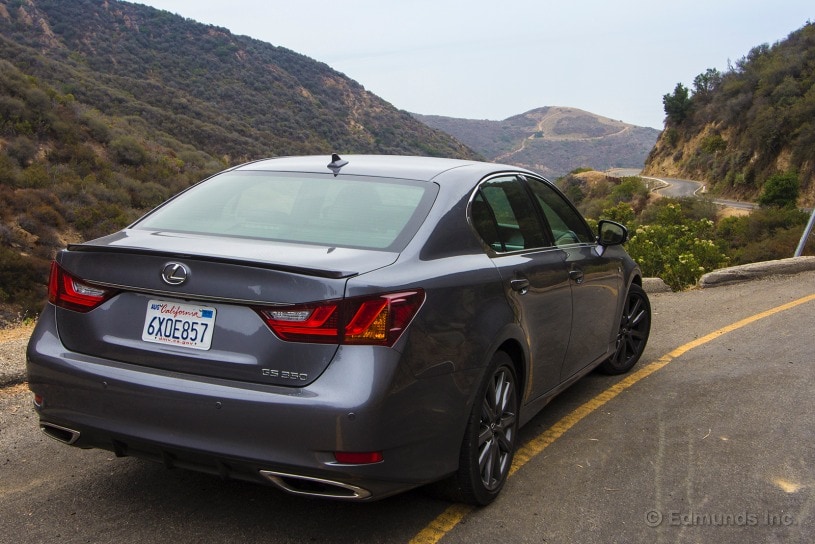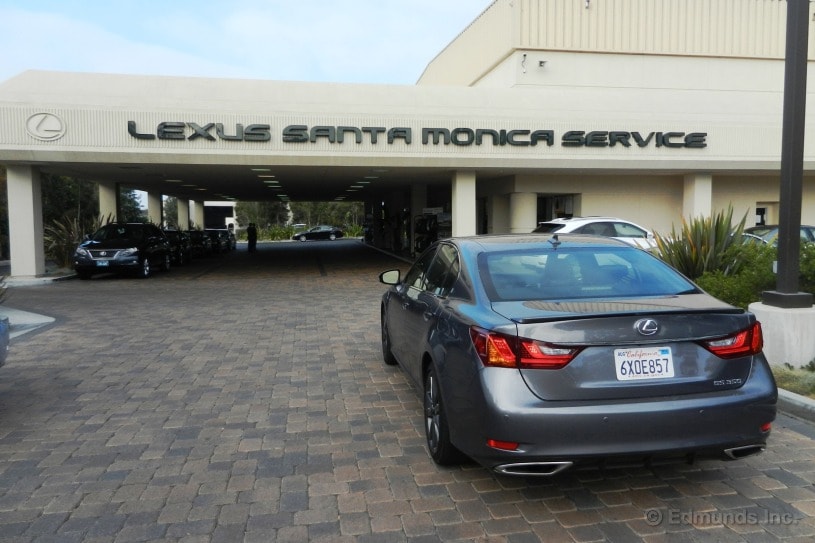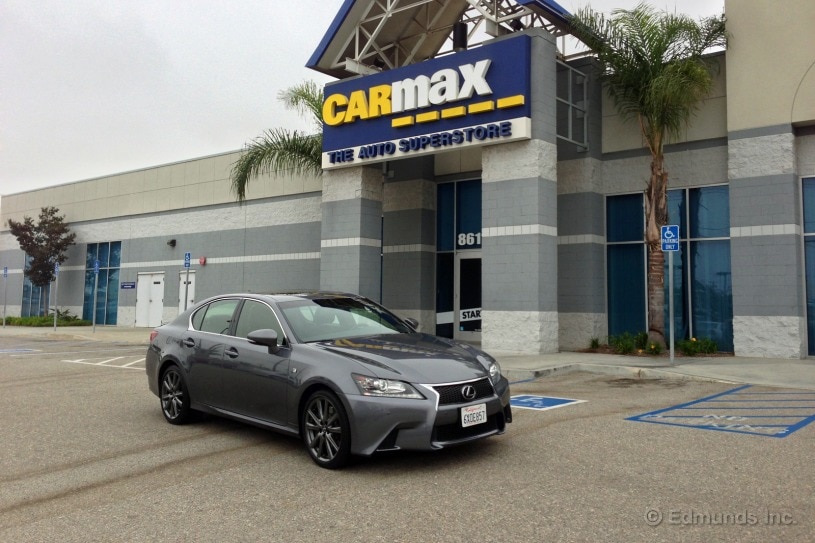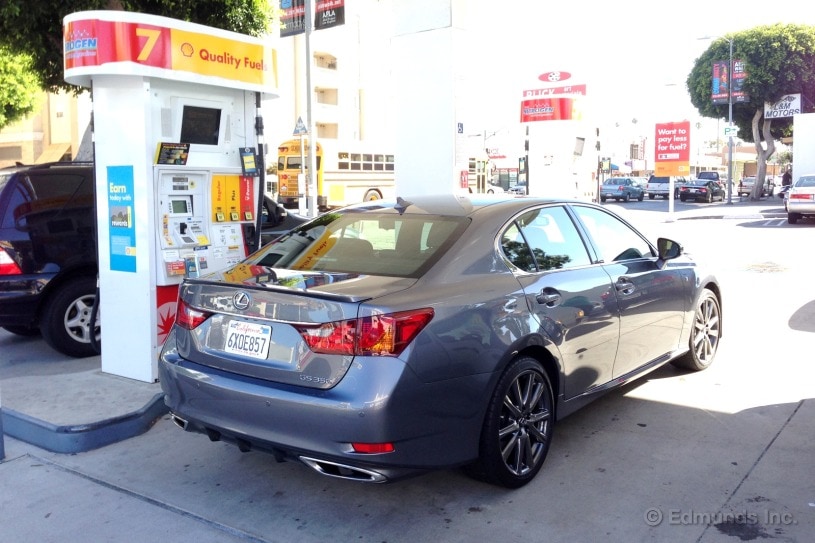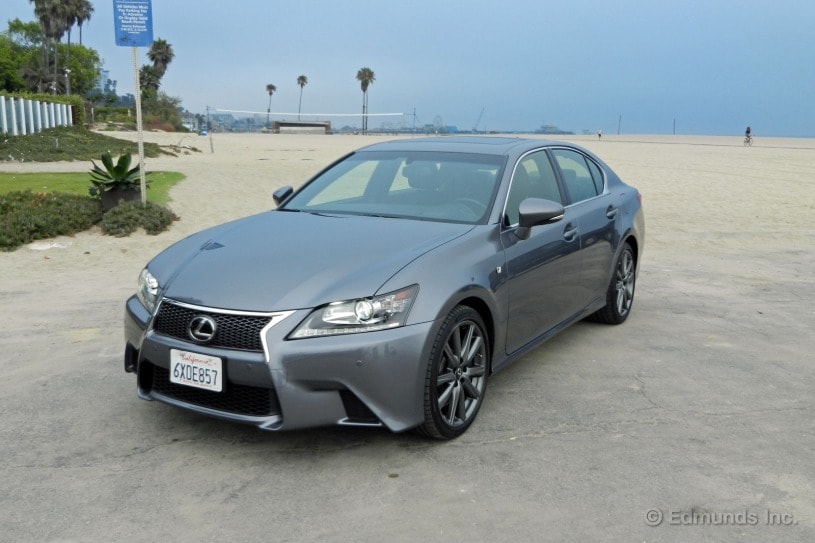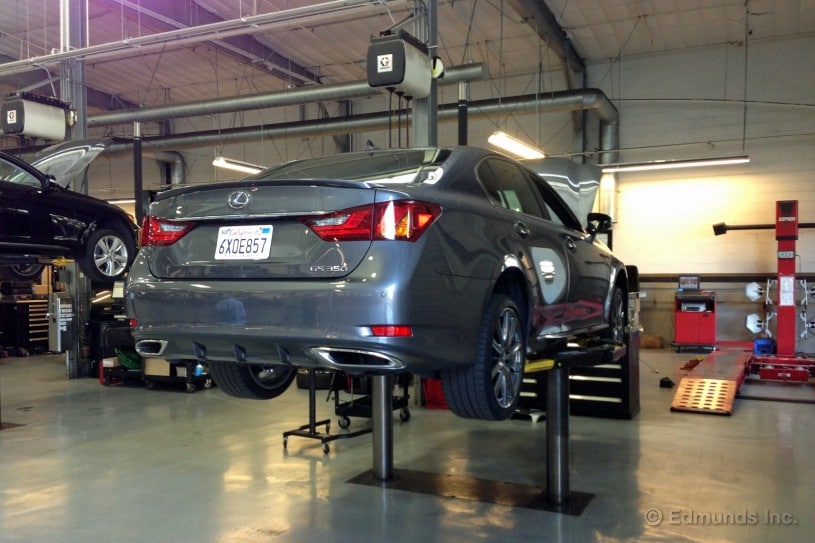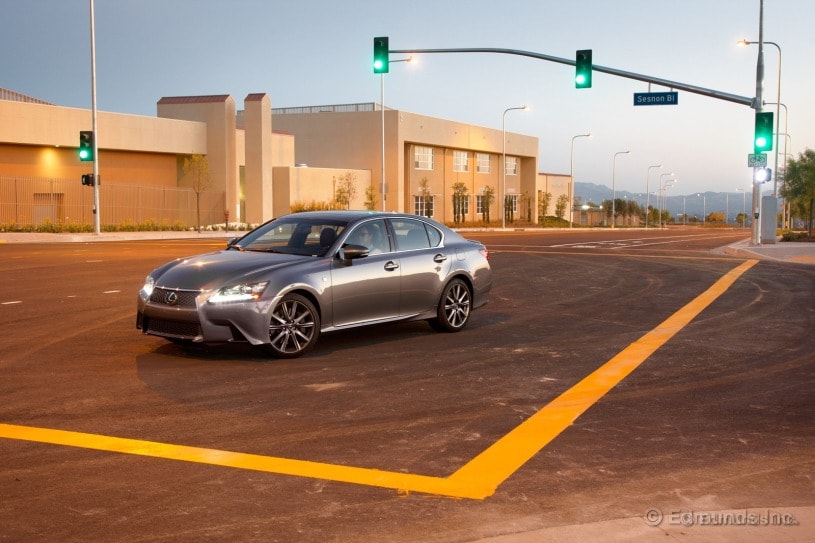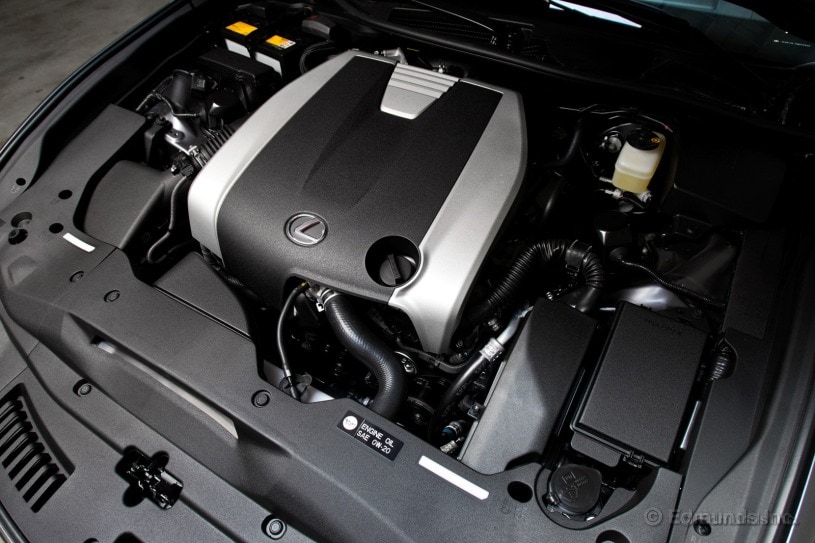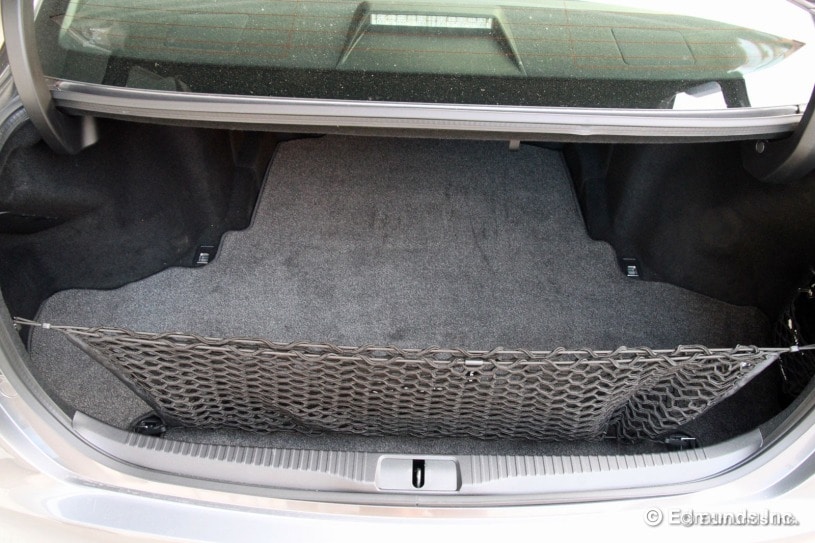2013 Lexus GS 350: What's It Like to Live With?
Read daily updates on our long-term road test of the 2013 Lexus GS 350 and follow along as our editors live with this car for a year.
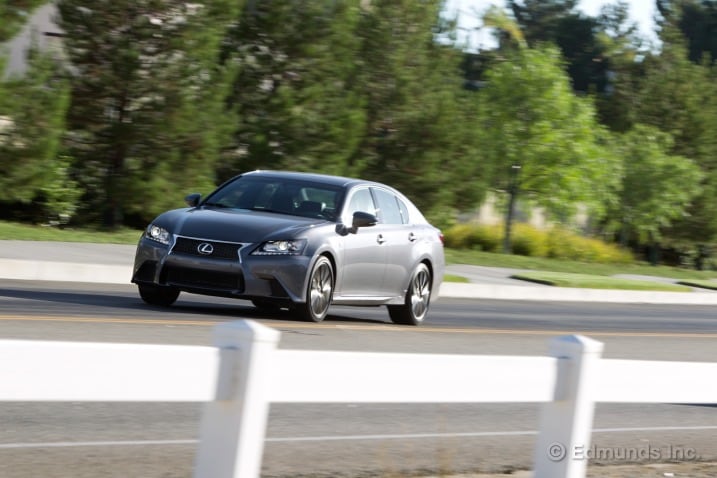
What do you want to know about?
- How Did We Get Here?
- More On Remote Touch
- Airport Taxi
- V6 Sounds Great, Mostly Filling
- Highway Ride Quality and F Sport
- One Of My Favorite Midsize Luxury Sport Sedans
- Hidden Parking Brake
- What's Happening Under the Driver Seat?
- The Anti Grocery Cart
- First Road Trip
- Road Trip Fuel Economy
- Mystery Box
- The High Cost of Art
- Auto Parking Brake
- Remote Touch Impressions
- Zero Range
- Leather Seats That Won't Scorch
- Does It Look Good?
- Dog Report
- A Closer Look at Interior Materials
- Road to Palm Springs
- Great Road Trip Ride
- How Did We Get Here?
- What's Missing?
- Dancing the Bernie in Oakland
- Favorite Tech Features
- Separated At Birth
- Unsporty Gearbox
- A Look Underneath
- Cruise Options
- 5,000-Mile Service
- Heads Up
- Rubicon
- Liking It
- Blame Audi
- Resetting the Maintenance Reminder
- Worst to First?
- Knee Pad
- "Is That A GS?"
- Milestone
- The Planchette
- The Road to VaVOOM
- Everyone OK?
- This Is Silly
- You Write the Caption
- Our Favorite Caption
- Sounds Better Than It Looks
- Marketing Manager Wanted
- Massive Dead Spot
- What is This Stuff?
- A Decent Shopping Partner
- Interior Panel Fitment
- All-Arounder
- Great Thigh Support
- Crisp, Clear Gauges Make for Easy Reading
- Easy Phone Pairing
- Trunk Features Part One
- Trunk Features Part Two
- Heads Up Display
- Tight Turning Circle
- Handsome Sedan
- Dual Personality Sedan
- Fuel Economy Update for January
- Maintenance Warning Light
- Officially Due for Service
- Rain and the Rearview Camera
- Mystery Body Damage
- Road Trip to Austin, Texas
- 10,000-Mile Service
- Comfort King
- Nighttime Lift-Off
- Moody Instrument Panel
- Headlights Look Good and Work Well
- Kingman to Lubbock
- Rolling Into Austin, Texas
- Circuit of the Americas to Van Horn, Texas
- Fuel Economy Update for February
- Fuel Economy
- Van Horn, Texas To Home
- Exhaust Trim Charade
- Overzealous Steering
- Soft Machine
- Busy
- Road Trip Fuel Economy Reveals Believable MPG Gauge
- Bonus Sounds
- Time for Maintenance
- Extra-Padded Center Console
- Every Car Should Have a Cargo Net
- 15,000 Miles
- Fuel Economy Update for March and April
- More On Adaptive Cruise Control
- 15,000-Mile Service Complete
- Five Reasons To Get the F Sport Package
- Escape From the Mundane
- Are Six Speeds Enough?
- Rear Seat Comfort
- Fuel Economy Update for May
- Off-Road at the Fishing Derby
- The Windshield Wiper Trick
- Dark-Finish Wheels
- Road Trip MPG
- Yellow Tinted Windows
- Fuel Economy Update For June
- Road Trip Report
- Finding Car Heaven
- Automatic Parking Brake
- Trying Really Hard
- Paint Protection Film
- Attention To Detail
- Plastic Engine Bay
- Analog Elegance?
- Fuel Economy Update for July
- New Car Wash
- 20,000 Miles
- 20,000-Mile Service
- Carmax Appraisal
- Fuel Economy Update for August
- Alternate Appraisals
- Inspected and Sold
- Wrap-Up
How Did We Get Here?
Lexus has a bit of a problem. The Japanese luxury carmaker builds some of the finest midlevel luxury cars in the world and they've been instrumental in the hybridization of that class. They have excellent reliability, great name recognition, inoffensive styling and all of the luxury trimmings buyers expect at this level.
Trouble is, few people are passionate about owning a Lexus. "Oh, Bob bought a Lexus? That's nice." That is the extent of the excitement most Lexus sedans generate. And in a crowded, highly competitive market segment that features numerous high-powered sport sedans, that reputation doesn't help.
The 2013 Lexus GS 350 is the company's latest bid to change that. It not only has more aggressive styling, it's available with an F Sport package and a dynamic handling pack. Together they put the new GS on a dynamic level that Lexus hopes will attract customers who would typically gravitate to Audi, BMW and Infiniti sport sedans.
Does it really deliver that kind of performance? We decided to add a 2013 Lexus GS 350 to our long-term fleet with those exact packages to find out.
What We Got
The 2013 Lexus GS is available in only one trim level. It costs $47,795 and includes a 306-horsepower 3.5-liter V6 spinning the rear wheels via a six-speed automatic transmission. There is no V8-powered model in the lineup.
Based on our early drives of the 2013 Lexus GS we knew there were two optional packages that we had to have. First up was the F Sport package for $5,690. It adds staggered 19-inch wheels with summer tires, an adaptive variable suspension, variable-ratio steering and 14-inch front brake rotors with four-piston fixed calipers. Additional upgrades include rain-sensing wipers, heated and ventilated front seats, aluminum interior trim, a black headliner and unique F Sport bodywork.
The other option we wanted was the slightly less expensive Lexus Dynamic Handling system. This $1,700 package includes an active rear steering system that, in concert with the sport steering, helps the GS whip around corners like a much smaller car.
Unfortunately, Lexus dealers are not as bullish on the system, as it was nearly impossible to find a car equipped with both packages. We finally tracked one down at Keyes Lexus in Van Nuys, which is relatively close to our home office in Santa Monica. The only problem was that in addition to the sport packages, it also had a host of other options we didn't want.
The extras included a blind spot monitoring system, head-up display, the Mark Levinson stereo system, Intuitive park assist, a pre-collision system and dynamic radar cruise, paint protection film and the massive 12.3-inch high-resolution screen running Lexus' newest infotainment system. All told, the extra options added about $16,000 to the base price of our GS 350 for a final sticker price of $63,427.
Our choice was either take all the extras or wait for another car to arrive with the packages we really wanted. We decided to go ahead with this car after negotiating a price that was much closer to the invoice price.
We struck a deal for the car but hit one last snag. On the day we were to take delivery, the salesman called and said he found some damage on the car. It was a small dent in the roof on the passenger side, but it wasn't something that could be fixed by a dent repair specialist. The roof would have to be repainted. At that point, we told them that if they would be willing to take $1,000 off our negotiated price we would still take the car after it was fixed. The salesman took it to his general manager who agreed, and the deal was done.
Why We Got It
Lexus stormed the castle when it entered the U.S. market with a sedan that stepped over the largely irrelevant domestic competition and set the Germans back on their heels. Since then, Lexus has not been able to wedge very far into the sport sedan segment. Whether it was the IS compact sedan, the GS midsize or the even larger LS sedan, none of them had much draw for enthusiasts. Lexus was always too soft, too bland and too disconnected to make those who label themselves "drivers" swoon.
In our road test we wrote, "The 2013 Lexus GS 350, F Sport in particular, is an impressive redesign. It's a Lexus that driving enthusiasts can get excited about. More than just promises, it's actually fun to drive. And unlike the IS F, the GS 350 F Sport's adjustable suspension won't punish you for the performance it brings. It can do smooth and quiet, or serious and sporty: your choice."
Those are big promises, and we put our money where our mouth is. We've got 12 months with the GS 350 to see if these feelings hold true for the long run or if this, like other Lexuses of the past, fails to tick our emotional boxes. Follow along on our Long-Term Road Test Blog for updates on this and the rest of our Long-Term fleet.
Current Odometer: 1,091
Best Fuel Economy: 21.3
Worst Fuel Economy: 18.1
Average Fuel Economy (over the life of the vehicle): 19.8
Edmunds purchased this vehicle for the purposes of evaluation.
We've written a few posts on our GS 350's Remote Touch electronics interface during the past few months. The opinions have varied so far, with posts such as This Is Silly taking a pretty negative view of the system while Remote Touch Impressions is fairly positive overall.
Since I've spent a fair amount of time with our GS 350, I thought I'd offer up some additional opinion. Since the rest of the car is so good, your reaction to Remote Touch really could really make a difference in your purchasing decision.
I can certainly understand both viewpoints, and I'll agree that the system's worst aspect is the sensitivity of its controller. It just takes a certain level of concentration to move the mouse-like cursor to where you want without overshooting your desired menu or button. Setting the controller's level of physical feedback to maximum helps minimize this aspect, but it still requires a level of concentration that could be a deal-breaker for some people.
On the positive side, however, I'd argue that Remote Touch has the advantage of being a very familiar style of interface. By this, I mean it's a lot like a personal computer with menus and a mouse, and it strikes me as very logical in the way information is organized. As such, the actual learning curve is lessened.
This might seem insignificant at first, but I'll relate it with this story: I bought my wife a MacBook Air notebook computer about a year ago. I thought she'd like it and would acclimate to Apple's interface after years of working on PCs. But that's not been the case. She's never warmed to it, claiming it's "not for linear thinkers" even though other people find Apple's OS to be superior. So I'm having to look at PCs again for her (although, ironically, Windows 8 is a lot different).
The bottom line is that I think people considering a Lexus GS really should spend some time testing with Remote Touch, particularly while driving. Your reaction will vary.
I recently took my wife and a friend of hers to the airport in our long-term Lexus GS 350. They're meeting in Las Vegas for a girls' weekend. (Yeah, it sounds like trouble to me, too.) Using the GS gave me the chance to test out how the trunk could handle multiple pieces of luggage.
Official trunk space is listed at 14.3 cubic feet, which is a tad small for this class of car. (Our Jaguar XF offers 17 cubes, for instance.) Still, it proved to be sufficient to hold two medium suitcases, a small suitcase and a duffel bag.
One thing I noticed after I took the photo was that the GS has the "gooseneck" style of trunk lid hinges. I couldn't actually close the lid since the left suitcase in the photo was in the path of the hinge's downward path. Not a huge deal — I just repositioned the suitcases — but it could be an issue if you frequently use the GS' trunk for a lot of cargo carrying.
One thing I've noticed about the 3.5-liter V6 in our 2013 Lexus GS 350 is that it has dual personalities when it comes to the way it sounds. Under normal driving conditions it sounds like your typical Lexus V6, which is to say understated and quiet. But when you nail the throttle, the V6 becomes much more aggressive and is highlighted by a throaty intake sound at higher rpm. There's some sound enhancement going on — Lexus has added special sound generator tubing on the air intake to make it happen — but overall I like it.
The only issue I can see somebody having is that the V6 sounds a little sportier than it really is. Granted, 306 horsepower and a 0-60 time of 5.8 seconds is perfectly fine for this class, but you do have to rev the engine fairly high to access that power. Some competing sedans with their supercharged or turbocharged six-cylinder engines (Audi S5, BMW 535i, new Jaguar XF 3.0) have beefier amounts of torque that's readily available at low rpm.
Our long-term 2013 Lexus GS 350 is equipped with the F Sport package, which includes a sport-tuned suspension. So during two recent highway drives when I put on about 600 miles, I was curious to find out how comfortable the GS would be for long stints behind the wheel.
Overall, I found our GS' ride quality to be pretty agreeable, with the caveat that F Sport is not going to be for everybody. The F Sport's 16-way sport driver seat was comfortable and supportive, and I was able to find a very nice driving position that I liked. The ride quality is firm, no question. When you drive over rough pavement on the highway, you're going to feel it. But I didn't find it to be objectionable given that this is supposed to be a sport sedan, and it has a sport package equipped. One thing I did notice was a fair amount of tire noise for this class of car, though; the F Sport's wider summer tires might be the culprit.
I think the F Sport package brings some welcome character to the GS, and I'd order it if it were my car. But I would caution the potential GS buyer that that it does make a difference. If they're expecting the more typical levels of Lexus isolation, then I'd suggest skipping F Sport.
I'll have to admit that previous years of Lexus GS mediocrity had lowered my expectations about the new 2013 GS 350. But after spending time with our long-term test car, I've come away very impressed.
Of some significance, I find our GS fun to drive. Granted, a lot of that comes from the optional F Sport package that our car has, but I mention it because it's a rare quality these days. I can point to midsize luxury sedans that are certainly capable and sporty — the latest 5 Series, for instance — but don't really engage me as a driver. Our GS, in contrast, makes me want to search out fun roads. It turns in quickly, "drives smaller" than it really is and, even if it's average in terms of power, sounds good and is quick enough.
I also like the way the new GS 350 looks, the quality design of the interior, the massive central display screen and the comfortable backseat.
Along with the Audi A6, the 2013 Lexus GS 350 is the car I'd most consider right now if I were buying a $50,000 midsize luxury sport sedan.
Not a big thing, but Lexus seems to have gone out of its way to hide the button which operates its electronically actuated parking brake. It's located on the lower dash at knee level to the right of the steering column.
Most manufacturers place these buttons on the center console or to the left of the steering column on the dash where the old-school releases were located. Took me a little hunting to figure out how to apply the brake.
Unusual, but not wrong.
Something is moving under my butt.
It's the first time I've driven our long-term GS 350 F-Sport. I'm slowing the car to a full stop at a red light, and my brain registers a little buzz or flicker coming from beneath my tush. At first I assume it's my phone letting me know that a new email or text message just arrived. But my phone's not in my back pocket; it's in a cupholder. And a quick glance shows that there's no new text or email.
I immediately chalk the sensation up to "I'm Crazy" and move on. But then it happens a few more times, and I can't possibly be that crazy, can I? So I pose the question to you: What is trying to contact me from beneath the driver seat in our F-Sport-package-equipped Lexus sedan?
I’ve done my time with plenty of rear-wheel steering systems.
Most of them worked in a way that made you think of a grocery cart swapping ends at the end of an aisle as you make the hairpin and go up the next alley.
As the 1970s began, the Datsun Z-car's independent rear suspension gave you a little extra liveliness as the toe and camber changed when the wheels stroked through their travel, a kind of passive four-wheel steering in a way. It seeemd all right at the time, but as the 1970s concluded, the effect no longer seemed so charming. While testing the last 280ZX Turbo in a slalom at Riverside International Raceway, I arrived at the last gate under perfect control and got a nice round of applause from onlookers. Sadly, this was because the car was perfectly backwards.
As the 1980s began, active four-wheel steering became fashionable for a brief period. Oddly enough, Nissan led the way with HICAS, a hydraulic (later electric) active system developed from a Nissan R&D research vehicle. It proved fairly brilliant on the street in the Nissan 300ZX Turbo Z32 and the Nissan 240SX S13, but there was lots of moaning and groaning about its behavior at track speeds from the usual know-it-alls, so it didn’t last long in production.
Instead, four-wheel steering became a kind of gimmick as the 1980s ended. The Honda Prelude's low-speed system made parking easier, but that seemed to be about it. In the end, no one wanted four-wheel steering — not from Honda, not from Mazda, and not from Nissan. Not from anybody, really.
So it's kind of a miracle that the first time I drove the Lexus GS 350 F Sport over a high-speed demonstration course set up on the old runways at El Toro, I was totally impressed by the effect of its four-wheel steering.
This Lexus system not only quickens the car's response as it turns into a corner but also seems to improve the way the car grips the pavement as it leaves a corner. I drove the F Sport back to back with a BMW 5 Series and a Mercedes E-Class on the a wide-open, high-speed course on the old runways at El Toro, and the European cars felt like donkey carts compared to the Lexus.
We'll be talking about this system more as time goes on. Maybe four-wheel steering is an overnight success at last.
I think I'm the first to road trip our new 2013 Lexus GS 350 F Sport. Today I'm driving it over 300 miles from Santa Monica to Palo Alto, CA and tomorrow I'm driving it back. Tune in Friday for a full mileage report.
I just completed my very first road trip in our long-term 2013 Lexus GS 350. On Wednesday I drove the car from Los Angeles to Palo Alto, CA and on Thursday I drove it back. A total trip of 727 nearly all interstate miles.
By the way, here's a photo of the sedan parked at my Silicon Valley hotel just to prove I was there.
Now that you believe me, I'm ready to report that the GS averaged exactly 25.0 mpg during the trip running on its required premium fuel (91 octane). The EPA rates it at 28 mpg on the highway.
Alright, what's that thing on top of the steering column? I had my own suspicions, as did some of my colleagues. Is it a secondary set of warning lights? A driver alertness sensor?
When I shot this photo in the parking garage, I pretty much knew it was a driver alertness sensor. With two very bright infrared emitters, I couldn't think of any other possibility.
My contact at Lexus confirmed this. According to her:
"That's the infrared camera of the Driver Attention Monitor option. It scans the driver's eyes to see if they're open or looking away from the road. If the driver is not looking forward and a collision appears imminent, the system will beep at you. If you don't react, the system will apply the brakes 1.2 seconds prior to impact to help lessen the severity of the collision."
There. Mystery solved. Were your guesses right?
Throughout the weekend I was beset by the irritating message shown above. When I'd go to skip a track on my iPod, I'd get the "Data is being acquired from iPod. Please wait..." warning and the current song would continue to play. The thing is, my iPod was plugged in for quite some time and the system should have had ample time to acquire said data.
This morning, however, I noticed that little data loading symbol where the album artwork should be. "Hmmm," I thought. I waited until the artwork appeared, then tried to skip a track. Voila! Time after time, I tested this with the art loading and loaded with consistent results.
The fix? I went into the menus and disabled the album artwork display. Now I can skip to my heart's content (now there's a visual you might struggle to get out of your head).
I like this feature on the Lexus. Practically every other car I've ever driven the parking brake must be manually engaged and disengaged. But the GS has an Auto setting for this operation. Put the sedan in Drive and the e-brake is released. Put the transmission in Park and the brake engages.
Cadillac's once did this...sorta. Back in the 1970s, the parking brake on a Caddy would disengage when the car was put in gear, but the Lexus is the first car I remember that sets the brake when the car is shifted into Park.
Now that's luxury. Cool touch.
iDrive. COMAND. MMI. Now, Remote Touch. How does Lexus stack up against zee Germans?
Well, like anything, there's the good and the bad. Let's start with the good.
The controller and palm rest are well placed and just feels right under your hand. Moving the mouse-like toggle pad is as intuitive as interfaces get. The simulated detents (when you roll over an on-screen button) are incredibly helpful, clever and just plain cool. The graphics look rather dated (as shown in my last post), but at least they're legible.
Now the bad — well, maybe bad is too strong a word. Here's where it could use some help.
The menus and tabs aren't all that intuitive. After a few days, though, I started to "get it" and navigating around the various systems got a little easier. Think of it as your favorite website that just went through a redesign. All the stuff you need is there, it's just rearranged and you need to figure out the logic behind it. For some reason, I also find myself needing to pay more attention to the screen than I do with other systems. Finally, those cool detents I mentioned above could be a bit more aggressive. Even at its highest setting, I'd like more of a button stop.
The staff here is split on what interface is best. Personally, I think Audi's MMI system is the best. It has tack-sharp graphics that look as modern as a 21st-century car should. The menus are also better organized, at least for my way of thinking. I'm ok with iDrive, it doesn't irk me the way it does to some. Mercedes' COMAND is probably my least favorite. No matter how much time I devote, it never manages to feel right to me.
I'd place Remote Touch in second place, just after Audi.
What do you think? Which system fits you best?
Last week during my 700+ miles road trip in our long-term Lexus I risked it all and drove the sedan down to "0 Miles" on its fuel cruising range readout. I then immediately pulled into the nearest fuel station and filled the tank. The GS took 15.5 gallons of 91.
Now Lexus says the GS has a 17.4 gallon fuel tank, so theoretically I had a two gallon cushion.
Above, our 2013 Lexus GS 350 passenger seat looks perfectly harmless. But take into account that it's been sitting under the hot afternoon sun for hours, L.A. is suffering from record-breaking heat and I'm wearing a slip of a summer dress.
Fortunately after opening the front doors and the windows and blasting on the seat coolers, which both front seats are equipped with, I was able to safely ease into the cabin and the seat without yelping. I've had painful experiences with hot leather seats before so was kind of gun shy here.
But the cabin and seat cooled down quickly. By the time we were halfway down the block, the A/C made us forget that it's 94 degrees outside. Man, I LOVE seat coolers!
The Lexus GS 350 F Sport is a controversial car around these parts (what, am I a cowboy?), especially from an aesthetic stand point. I've heard that it's ugly or plain, while the interior draws similar negative feedback.
I actually like it.
The front end has a lot of interesting details — especially the lower airdam — and the rear is nicely done. True, it does feel a tad overly dramatic given the rest of the car's rather conservative shape, and I definitely don't need the silly rear diffuser. So perhaps it's overdesigned, but I don't think it's ugly, and I definitely don't think it's plain.
And no "buts" on the inside, I just flat-out like the modern, minimalist design featuring horizontal lines that reduce the dash's visual bulk. It's more technological than organic and I like that in an interior.
What say you, does the GS 350 look good?
Yesterday I had to take my dog Mya to the vet. Unfortunately she had a tumor that needed to be removed from her shoulder. Poor puppy. And I drove her to the vet wayyy in the Valley in our 2013 Lexus GS 350. Fortunately, the luxe sedan was a decent way to do it.
Since LA is suffering from scorching temperatures right now, the cabin of the GS was boiling when we first got into it, but I was able to quickly cool it down by turning on the car and blasting on the A/C before bringing Mya in. The rear seat does have a couple of vents pointing its way from the front-seat center armrest but for some reason I couldn't figure out how to increase its fan speed. The fan speed control up front only seemed to work for the front vents. The only control in the back allows you to open or close the vents. So it just gently blew cold air in Mya's direction. To get her more air back there I had to point all the vents in the front dash her way. I could tell this worked when her desperate panting eventually stopped 10 minutes into the ride.
I like how the seatbelt fasteners protruded from the seats, making buckling her in easy. Very important because I had to be oh-so-gentle around her surgery area which displayed an impressive Frankenstein's monster-like scar (8 inches long!) and didn't want to have to struggle too long with fastening her in while the seatbelt strap pulled her harness against her new stitches. Eesh.
Since Mya's shoulder is tender, when she tried to jump down from the backseat she tried to do it from the footwell to get as low to the ground as possible first. But her big cone kept catching on the door's protruding storage area. Not that this would be an issue for cone-less dogs but it was just sad seeing her struggle to get out while the cone kept catching on the door. Would have removed the cone but at this point she made up her mind to get out of the car and wouldn't stop.
In the end, the GS 350 did fine as an injured-doggy hauler. I'm looking forward to the time when Mya's feeling better and we can use it to take her on a road trip.
Our 2013 Lexus GS 350 cost us $63,427, driven up from its base price of $47,795 by all the options we put in it, including the F Sport package which gives it its striated aluminum interior trim. Looking at these snaps, think the interior materials are befitting that of a $63K car?
This weekend I took our 2013 Lexus GS 350 on a weekend jaunt to Palm Springs. At only 240 miles roundtrip, it's not as impressive a drive as chief Oldham's 727-mile trip to and from Palo Alto but I was able to gather some impressions about the car during the trip.
The paddle shifters came in handy during the Friday mass exodus on the 10 East. Didn't have to tire myself out with pedal work before I even began the trip. The seats were comfortable and the ride plush enough so we didn't feel the need to stop midway to stretch our legs but just drove straight 2 1/2 hours to our destination.
The navigator came in handy since we were checking out places we've never been to before, but the only thing is that we had to plug in the addresses before we got moving as the nav doesn't allow you to type it in while the car is in motion. You can use it to find previous destinations or POIs though.
The A/C stood up to the desert temperatures of Palm Springs, keeping the cabin nice and cold and making it that much harder for us to tear ourselves away from its chilly embrace to face the oppressive heat.
Suffice it to say, the 2013 Lexus GS 350 was a comfortable, luxurious ride for our road trip and I'd gladly swipe its key again.
A few weeks ago I drove our long-term Lexus GS 350 from Los Angeles to Palo Alto and back in two days. That's 700+ miles of interstate and California freeways is less than 48 hours.
When I emerged from the GS the final time I remember looking back at its bug ridden, gapping grille and its once clean flanks now covered in grime and feeling a sense of connection with the machine. The car and I were enjoying a mutual moment of accomplishment. And there in my driveway we were taking a few seconds to acknowledge each other. The only sound was the metallic clicking of the sedan's cooling exhaust system.
For me, this was a first. I've never had such an exchange with a Lexus sedan. It was emotional. The 700+ miles were covered in comfort and a quiet cocoon, as you would expect from a Lexus, but this car offered more. I enjoyed the trip. I felt like I had driven a car. I had an experience. This might be the first Lexus sedan that allows you to experience the journey and not just the arrival.
I like driving the 2013 Lexus GS350, really I do. Or at least I like driving it fast, as the F Sport rear-wheel steering makes it ever so much better than a BMW 5 Series or a Mercedes-Benz E-class.
But the way it looks gives me the horrors. Since I still remember the introduction of the second-generation GS at Calty Design here in Los Angeles, when the car seemed like a miracle of good design — the first-ever Toyota sedan that looked world-class great — it makes me wonder how the GS’s design language has become so garbled.
Of course, it all started with the Toyota Cressida of the late 1980s, a fast car with an inline-6 engine, a five-speed manual transmission and rear-wheel drive. It had a serious case of Nissan Maxima envy, even though it looked like the Hyundai Equus of its day. Giorgetto Giugiaro and his people at Ital Design began to sketch a sleek Euro-style body for the hardware in 1988, combining themes from the Lexus LS sedan and Lexus SC coupe, just then in the design stages themselves.
When the S140-type Lexus GS 300 finally came to America, we all thought it was just a version of Ital Design’s 1990 Kensington concept car, which had been built with a Jaguar inline-6 engine (though Ital Design later officially denied it). In any case, the first GS with its 1980s-style monochromatic paint treatment and unified, aerodynamic shape was an artistic success but a commercial failure, great to look at but stodgy to drive.
The S160-type Lexus GS just knocked us down in 1997, and Toyota must have been pretty excited as well, since it opened the gates at Calty Design for us to see it, one of the first times that journalists had been permitted access to the company’s design studio in L.A. The quad headlights came from the Lexus SC coupe, and the fender blisters and rear wing reflected the concept, which Lexus called “HPS,” (High Performance Sedan). With the LS 400’s 4.0-liter V8, the GS 400 was the fastest sedan in the world until the latest BMW M5 was introduced a year later. No wonder the S160 was built until 2004 and you still see so many on the road today.
The S190-type Lexus GS came along in 2005, and it introduced a new design language for Lexus that was called L-finesse. There was a lot of controversy about the whole idea of L-finesse at the time, as less adventurous elements at Toyota tried to rein in the Lexus division. In any case, the monolithic, fastback shape of the new GS didn’t win any friends, even though the chassis had been worked over with some serious high-performance intentions, as it would be shared with the Lexus IS sedan. More power, a six-speed automatic transmission and all-wheel drive fulfilled the car’s high-tech mission. Nevertheless, it never caught on despite very successful sales, and aside from a introducing a fastback profile that soon became familiar from many different manufacturers, it didn’t prove memorable.
Now we have the L10-generation Lexus GS, and you can see some of the same design themes in the short front overhang and vaguely fastback roofline, while the GS 350 F Sport has a tricky rear-wheel steering system. Yet on the whole, the car seems even more monolithic than before, thick-waisted like a BMW 7 Series only with a more upright cabin. Meanwhile, a zippy cheese-grater front cap incorporates some of the styling licks from the Lexus LFA, while the rear wears a sci-fi bubble. Meanwhile, the interior tries to be inventive, yet it seems traditional instead of modern. This is a car that looks heavy and bland, though it’s trying desperately to be something else. Maybe it’s no wonder that Toyota chairman Akio Toyoda had strong reservations when he first saw the car in its early design iterations.
When you look at the details, the 2013 Lexus GS should add up. It still has a unique combination of high-performance technology that serves the ideals of comfort and convenience as well as speed, and this is what has always made the Lexus GS the ideal car in which to get quickly across town without being exhausted when you arrive. Yet the car looks heavy and plain, even though you can see in detail that it’s packing a lot of visual baggage. And it looks as if it’s riding its front tires like a front-wheel drive car, instead of leaning back on its rear tires in the way that the first two generations of the GS did so effectively.
If I were trying to fix the way the Lexus GS looks, I’m not sure that I’d know just where to begin. Maybe just paint it red, eh?
Looking at the above photo of our 2013 Lexus GS 350's climate controls, do you notice anything missing?
Yup, the centerstack climate controls are missing an air-conditioner button. You can only turn on the A/C via the touchscreen as pictured above in the lower leftside of the screen.
I realize this is the smallest of all nits and something that will become a nonissue to actual owners of the GS 350 but I just thought it odd that there wasn't an actual button for it. Instead, you have to scroll through the screen to Climate. Shrugs.
However, the GS did actually in fact win the award for Production Vehicle Interior Innovation of the Year from something called the Automotive Interiors Expo 2013 in June for its climate control system so what's a little missing A/C button compared to all that?
From the AIE site: "The Lexus GS features a Denso climate control system that makes use of Nano-E technology from Panasonic that moisturises those inside the vehicle! The industry has already had purified and scented air-con systems, but the Japanese OEM takes things to a new level by using nanotechnology that purifies the air coming out of the vents in order to moisturise the hair and skin of the occupants."
It's true that driving 1,000 miles is a little far for a baseball game, but then I've done dumber things. The ability of the automobile to help you actualize such dumbness on impulse (as long as you have access to a credit card from a major fuel company), is one of the great things about it.
So that's how I came to be in the O.co Coliseum with the baseball expert in my family to see the A's play last weeked, and they did everything expected with a walk-off home run to win in the 10th. And here's the road report:
Over the course of two days of cruising on California freeways, I recorded a 250-mile run at 23.7 mpg, a 310-mile run at 29.4 mpg, a 356-mile run at 27.6 mpg, and a 274-mile run at 27.4 mpg. Over the course of 4,036 miles, the GS 350 F Sport is averaging 22.4 mpg.
Up in Oakland everyone was dancing the Bernie, a kind of rally thing. It comes from Weekend at Bernie's, a 1989 movie in which two characters manage to persuade a house full of guests that their murdered boss is still alive. A comic dance of the dead guy ensues.
The A's players got a hold of the idea and turned it into not just a thing on the field but also a promotional day with the actor who played Bernie throwing out the first pitch and even a video. It's quite something to see 20,000 people wriggling like spasmodic zombies. Kind of a total A's thing that seems to say, "If we're out of it, how come we're still dancing?"
A's won their division against all odds, so it must work.
My name is Caroline and I'm a gadget-o-holic. (If I could have things my way, I'd have BOTH the iPhone 5 and the Samsung Galaxy SIII.) So naturally I geeked out a bit when I got behind the wheel of our 2013 Lexus GS 350. It's just packed with a lot of neato tech, and I'm not just talking the usual suspects of satellite radio and Bluetooth. Hit the jump for my favorites.
That auto-brake. OK, it's not the world's biggest deal having to turn on and off the parking brake. But, still, this is a cool feature to have so you don't even have to think about it. It does it for you. Just make sure to press that "Auto" button. And, yeah, if you'd rather do the brake yourself, just deactivate it.
The joystick and wristpad. For those who work with computers, the feel of this is so natural. Just aim where you want the cursor to go and click. However, if I'm going nitpick I will say that it takes some getting used to pushing straight down on the joystick/button. When I don't make a conscientious effort to do that and instead press at an angle then the cursor inadvertently moves and clicks on something else.
Head-up display. Sure, lots of cars have this but I still get a kick out of it whenever I get behind the wheel and see it.
Seat coolers. I already mentioned how much I like these but it bears repeating. I really do.
As one Mr. Takahashi noted, this doohickey atop our longterm 2013 Lexus GS 350's steering column is the
thing that shoots frickin' laser beams at your face
driver alertness monitor.
But the first thing I thought of when I saw it was this:
If Lexus/Toyota expects the 2013 Lexus GS 350 F-Sport to be taken seriously as a driver's car, they'll have to do something about the gearbox. It is decidedly unsporty.
Rev-matching — The Lexus has it, but only if you select "sport" mode. Isn't the F-Sport already the "sport" model? And is there really any reason anybody would want it to not match revs? I can't think of any. And heck, when rev-matching is available in autobox-equipped Mazda 3s all the time, Lexus/Toyota — and every other brand with any shade of sporting aspirations — can follow suit.
Slow responses — There is a distinct pause between command and result when shifting manually.
No other choice — you can get a 2013 GS 350 with a 6-speed automatic, or... nothing else. There is no manual gearbox offered, and the autobox doesn't cut the mustard when used manually.
C'mon, F-Sport, live up to the promise.
[updated- remembered it does match revs in 'sport'. Sorry for any confusion]
Our 2-post Rotary Lift has been busy. Last week it showed us the underside of our 2013 Lexus GS 350. Enjoy.
I was looking for a menu or a button or switch or something to switch our longterm 2013 Lexus GS 350's active cruise to normal, "dumb" cruise — sometimes, you just want to be in control — but couldn't find it while driving.
Once I R'd TFM, I discovered how to do it.
To switch modes, you push forward on the cruise control stalk (that is, the 'cancel' action) and hold it there for about three seconds. The system will then deactivate active cruise, leaving you with conventional, er, inactive cruise.
One caveat, it won't retain that state — the system defaults back to active cruise once you cycle the ignition.
The more you know.
We dropped off our 2013 GS 350 at Lexus Santa Monica today for its free 5,000-mile service appointment.
They have the most beautiful service department I've ever seen. It's like a big fancy hotel, all marble and dark wood. Very pleasant.
Four hours later, it's back at our office. And boy do they bring the car around fast. You step outside and it's there in seconds.
Our Lexus has thousands and thousands of dollars in optional equipment. For example, the Heads Ups Display, which shows the vehicle speed in the window in front of you. It's not new technology but I can see how it would be considered fancy by Lexus drivers.
Necessary? No. Nicety? Yes.
Would you pay $900 for the Heads Up Display?
I'm not talking about Julius Caesar crossing the river, but the now-defunct AMC series about intelligence analysts. The TV shows I like always get canceled. Sigh.
In that show, the POV would often switch to surveillance cameras because everyone is being watched. That's what this back-up camera display looks like to me. It has that surveillance video look. It's more high-def than your average soft focus vehicle camera. It gives me the feeling of being spied on.
In the words of Kurt Cobain, "Just because you're paranoid don't mean they're not after you."
I've lately spent some quality time in our longterm 2013 Lexus GS 350, and I'm finding this a very well-executed sedan. For starters, its V6 punches the GS around with such authority — Toyota's 3.5-liter 2GR-FSE V6 has always been an overachiever — that a V8 is not strictly necessary (did I just type those words?). Great throttle response, too.
And the steering, well...
... it's the best steering in a Lexus sedan to date. It's quick, linear, builds effort nicely and generally feels more honest than that of the current 5 Series. The rear wheel-steering system that's part of the F-Sport package is truly seamless in its operation — it simply works.
Also, just because I think the 6-speed automatic isn't sporty doesn't mean that it's a bad gearbox — on the contrary, in auto mode, it's right there with the top of its class, swapping gears smoothly and crisply and boasting an intuitive calibration that's not stingy with a kickdown right when you want it. It's just "meh" when shifted manually, that's all.
The F-Sport moniker might suggest to some that this GS is some barnstorming, hard-edged sport sedan. It isn't. Instead, the chassis tuning strikes a fine balance between comfort and ability (hey, why not just make all GSs like this?). This is a car that's got plenty of comfort a long-haul road trip but isn't afraid of a corner. It does shrink when you drive it hard.
So, yes, the GS 350 is a fine steer. Looking forward to more seat time.
When I look at the front of the Lexus GS, I think about the influence that the Audi-style full-frame grille has had on the automotive industry. And when I look at the Audi A6 Allroad above, I think about how destructive this influence has become, both on Lexus and Audi itself.
Grilles, bars, LEDs, ducts and geometry of all persuasions. This is the kind of design that makes me want to call in the Haz-Mat unit for a cleanup.
I started up the 2013 Lexus GS 350 last night, and what do you know, time for service. Wait, didn't we have that done last week? Ah, yes we did.
But in the midst of rotating the tires and doing the mandatory checks, our Santa Monica Lexus service tech apparently forgot to reset the maintenance reminder.
Well, that'll be easy to take care of myself, right?
It is, if you where to look. Initially, I looked up "Maintenance" in the index of the GS 350's main owner's manual (it's still paper and pretty much a set of encyclopedias) and couldn't find any relevant topics. Forget that, I thought, I'll be able to figure out how to do in the navigation system's settings menu.
So I clicked Settings, then Vehicle, then Maintenance and that brought me here (see above photo). And then I tried to plug in the date (10/10/2012) that we had the oil changed and tires rotated. Nope. This area is apparently only for setting future reminders. You're supposed to swap the oil and filter every 10,000 miles or every 12 months, whichever comes first (tire rotations are every 5K miles). We'll hit the mileage first, but just for the heck of it, I put in 4/10/2013 while I was here. Obviously, I still need to change the interval from 5,000 to 10,000... there's no telling how many settings I screwed up while fumbling around here. I'll be fortunate if the radio still works.
The next time I started the engine I realized I still hadn't solved the maintenance reminder puzzle. So I went back to the index, this time searching under "Reset..." instead of "Maintenance" and, sure enough, there's an entry just for that.
And here's how you reset the maintenance reminder in the 2013 Lexus GS 350, though evidently only if it's a U.S.-spec car. Any Canadian readers out there with a new-gen GS 350... is it actually a different process?
So yeah, I'd call the reset process a bit complicated (but then, midsize luxury sedans are supposed to be complicated) and I can kinda understand why the service tech didn't bother, but there's no question, that yes, he/she should have bothered because it's his/her job to bother with such details.
Regardless, the reminder is now reset, so we shouldn't see it again for another 5,000 miles or so.
Yes, I know I'm starting this entry on a mean note, but the previous-generation Lexus GS 350 didn't even rank among premium sport sedans. It was a nice, comfy, well-built luxury car, but really, it was a rear-drive ES.
This 2013 Lexus GS 350 F Sport is so different from that car. Yeah, I've only commuted in it so far, but I feel OK calling it a sport sedan, or certainly a sporty midsize luxury sedan, and I think it's now my favorite car in the class. It feels far less isolating and encumbered by its electronics than the current 528i and 535i. It reminds me a bit of the Audi A6, except this Lexus has much better steering feel and its V6 sounds fantastic when you peg the throttle (never had that thought about the A6's supercharged V6).
So far, the one thing that bugs me about the GS 350 is the Remote Touch interface, but I'm willing to make the effort to like it — based solely on how much I enjoy the driving experience.
What we're looking at here is the side of the center console on the Lexus GS 350 F Sport. If this was your average car, it would be covered with some form of hard-ish plastic material.
On the GS 350, it's a strip of very well-padded leather. And that's a nice touch, because it's where your right knee rests quite often.
I think the 2013 Lexus GS 350, specifically the F Sport, is a decent-looking machine. Of course, a car's styling is totally subjective.
But (why is there always a "but?"), the 2013 model is missing something...
It's missing a distinctive "GS-ness." Like Michael Jordan, I too think the second-gen GS was by far the best-looking. Not even a competition.
The reason: It stood out from the crowd. You see one of those cars on the road today, and you know instantly it's a Lexus GS. Not just because of the quad head- and tail light clusters. But the whole shape was big sports sedan cool.
The current car? To me it comes across as little more than a meaner, larger IS 350.
Lexus forgot to incorporate "GS-ness" into the new car's styling. And that's a shame.
But you know what? Doesn't mean I like driving it any less. More on that later...
It's been smooth driving so far in our new Lexus GS 350 F Sport.
With this car's mix of luxury, comfort and sport, you can bet it will prove to be a popular choice with the editors and we'll rack up the miles quickly.
Mark Takahashi gave an excellent rundown on how the Lexus Remote Touch stacks up against other multimedia interfaces. For me, the system's controller was a little jumpy at first and took some getting used to. Now I like it well enough (though I think that BMW iDrive is a better overall navigator).
The first few times out, the Remote Touch's pad felt skittery and slightly out of my control — a little like a Ouija board planchette. I half expected it to start spelling out messages from the Beyond.
Now that I've got a better feel for it, that hasn't happened. But Halloween is coming.
Thanks to the power of modern technology, I had in my smartphone two different routes to our destination: the Halloween edition of Lucha VaVOOM, which mixes Mexican masked lucha libre wrestling and old-fashioned burlesque.
I was fiddling around with the Lexus Enform system's navigation page, employing the "what does this button do?" investigative technique, when I hit Destination Assist. The icon of the call-center worker should have been a hint as to what would happen next, but we still were a little surprised when a voice greeted us through the car's speaker, inquiring how she could be of help.
Although I already had directions, I gave her the address of the Mayan Theater — just to see what would happen. She asked if she could use our vehicle location, and I said she could. A couple seconds later, she'd wirelessly sent mapping to our screen.
We were plenty early for the fun of seeing Mal de Ojo fling Zombie Chicken to the mat. Lucha! VaVOOM!
If you have such concierge services in your car, do you use them much? How accurate is the mapping or other information they provide?
South Bay is fogged in this morning. It never photographs well, though. Thankfully, that's about as severe as the weather gets around here.
I hope our East Coast readers weathered the storm. I have family in New Jersey, at the shore, and in Philly. Lots of water but everyone fine.
What about you? Everyone fine? Do any of you have car damage? Let us know you're OK.
I get that car manufacturers want their products to be special and different. But seriously, who sat in front of this system and said, "Yes, this is the one we should go with."
Why make us toggle around with the square whatchamacallit? It's like a mouse that is set to move too fast. I always overjump the commands I want. I like that is has a large screen but the back and forth is frustrating.
I encourage you to make all of your selections while still parked because you shouldn't operate this system while driving or even waiting at a traffic light. It takes too much of your time and attention. It's as distracting as texting.
As long as a system has good sound and does useful things like keep you warm or cool and send you in the right direction when you're lost, that's all we need. This system could be so much easier to use.
Clear and simple is always best.
Halloween caption contest. Yay.
Thanks to Mark for making this lovely Alien vs. Predator vs. Lexus photo.
What's your spooktacular caption? We'll post our favorite tomorrow after we recover from our candy comas.
Thanks to ergsum for our favorite Halloween caption.
Here are the others that gave us the chills.
On the I-405 no one can hear you scream. (ergsum)
It runs off of Prii. (hybris)
Just try and make me put on a front license plate. (boff)
What the F Sport is that? (boff)
It only hunts for sport cars. (ergsum)
This whole "in-your-grill" styling is really getting long in the tooth. (altimadude05)
Clawing for traction, biting with grip; this car is a real animal on back roads. (altimadude05)
The GS 350 is loaded with creature comforts. (ergsum)
Lexus active jaw control (stpawyfrmdonut)
Ripley's mobile (noburgers)
It just burst out of the garage door (noburgers)
Lexus runs deep (stpawyfrmdonut)
Carthulu (ergsum)
Carmagedon (jpnpower)
The relentless hunt of perfection. (sherief)
GS 350 F-Sport: Eats Germans for Lunch (natnut)
What was your favorite?
Lexus still has a way to go when it comes to making its engines look good, but it has learned how to make its engines feel good. The 3.5-liter V6 in our GS has been around in various forms for what seems like forever. From Camrys to RAV4s to pickup trucks, it's been in just about everything Toyota not to mention much of the Lexus lineup.
It's never felt special, though, even if it did make the RAV4 stupid fast or the ES350 brilliantly smooth. In the GS, it feels like a whole new engine. It's responsive, gutsy in the midrange and even sounds throaty at full throttle. Part of it has to do with the quick shifts from the automatic, but the engine is always ready with usable power.
It's not the V6 I'm used to in a Lexus and it's definitely one of the things about this GS that makes it feel so un-Lexus like.
This post has less to do with our 2013 Lexus GS 350 driving experience and more with the ownership experience. I was looking up another local deaelership on Google Maps when I saw this bubble over Lexus of Santa Monica. Looks like they need to hire a new marketing manager.
It turns out that this dissatisfied customer was the only to post a comment, so it pops up as the default. Well, it made me laugh. But just when I thought this dealer had lost its way, it did this...
We received a mailer with a coupon for $30 off our next visit. Thirty bucks isn't much, but it is something. It shows the dealership is at least making an effort. Not all of them do this nowadays.
Of course, maintenance at 5,000 and 10,000 miles is covered by Lexus already. So we'll have to hold on to this coupon for another 10,000 miles before using it.
Now that is what you call a serious dead pedal. This is a good thing by the way.
I've seen plenty of cars come through lately that have no more than tiny little bumps for resting your left foot and that's next to worthless. I like dead pedals that are big enough for two feet, makes them more useful.
Then again, I left foot brake most of the time so I don't often use deadpedals, but when I do, I like something substantial that I can feel. Not even sure why, it just feels right.
Wasn't sure what to call this stuff, so I investigated. Turns out, various editors have been arguing over what to call it for some time. It's metallic trim that has a wood grain-look to it.
What? Lexus simply refers to it as striated aluminum. But who knows what "striated" means anyway? I was thinking maybe it should be called Alumiwood? Or how about Mohaganim?
Whatever you want to call it, there's no doubt it's a little different. And that's what Lexus was going for as it's part of the F-Sport package. And who's going to order Alumiwood in their F-Sport?
Midsize sedans are supposed to combine performance when you want it and a little bit more convenience when you need it, at least compared to compact sedans.
At first glance I thought our Lexus had sacrificed it cargo room for the sake of a nifty rear suspension and four-wheel steering. Then I looked at the spec sheet.
This GS has 14.3 cubic feet of trunk space. That's more than both the Audi A6 and the BMW 5 Series. The only real drawback to the trunk in the GS is the shape. I'm sure golf clubs will fit fine, but big square suitcases might have a little trouble. Works just fine for Christmas shopping though.
This is the center console on our 2013 Lexus GS 350. Take a look at that lid towards the top of the picture. That covers the front cupholders. Notice how the front of the lid lines up flush with the panel ahead of it and the back of the lid sticks up about a quarter-inch. Why did they do that? It doesn't work for me.
Here's the irony in writing about cars for a living: you get to drive really nice cars that you'll never make enough to afford. I don't mean exotics or 911s or AMGs, but your mainstream luxury coupe or sedan. In my case, I've developed an unfortunate appetite for $60,000 cars: E-Class, Cayman, and our GS 350, for example.
If you're a driving enthusiast who lives among crappy or non-existent public transportation, you've probably resigned yourself to two- or three-car ownership: your commuter, maybe a significant other's commuter, and a weekend fun car. On the surface, that sounds like some real One Percenter privilege, but I'm guessing it's not uncommon among car folk.
For a daily commuter, you could do worse than the GS 350. It soaks up the bumps, blocks noise and generally buffs out the daily grind. There's a great divide between driver and passenger seats, with a thick wide armrest that encourages Lincoln Town Car-type repose.
You're not going to take the GS to the track. You're not gonna wake up early to take the GS running with the motorcycles in the local hills. You are going to drive it home after a long workday. You are going to drive it to take your lady out to a nice dinner. You're going to drive it out of town every few months for a long weekend.
The GS wins on all counts. But I don't love everything about it. I don't like the twin red-eyes staring back at me from atop the steering column. And I don't like the instrument panel and steering wheel pockmarked with buttons (see photo) that activate features like lane-keeping assist or heads-up display — features seemingly easily integrated into the central command. Instead, they just hung a button on the IP. This is a tech-heavy car that requires too much time in the driveway just to get dialed in.
Our long-term 2013 Lexus GS 350 has the really expensive ($5,590) F Sport package which includes the really, really nice 16-way F Sport driver seat with adjustable side bolsters, lumber and, most importantly, an "extendable lower cushion" aka: thigh support.
These pictures should effectively show how far the thigh support adjusts. It's a lot and a surprising amount from any carmaker that isn't German. Not only does the "extendable lower cushion" extend quite a way, but it does so electronically and not mechanically.
Considering this, the seats alone might be worth the price of the F Sport package.
As you can see, the gauge cluster in our Lexus GS 350 is about as easy to read as they come these days. Seems like a no brainer in a luxury car, but with all the technology being crammed into them these days, the instrument cluster is often a dumping ground for information that could otherwise go elsewhere.
In the case of the GS, Lexus did a good job of giving you big, clearly marked analog gauges along with a relatively easy to read auxiliary info screen wedged between them. Unlike some cars, the extra info screen doesn't try to do too much. Instead, it can be configured to show basic info like miles to empty, a digital speedometer or simply nothing at all. Also, bear in mind that our GS has a heads up display that projects vehicle and engine speed onto the windshield if you want to simplify things even further.
For a car that is otherwise stuffed full of high tech gadgets, the simplified instrument cluster is a nice show of restraint.
I recently paired my iPhone with our 2013 Lexus GS 350 and came away impressed on how easy it was. In general, I think automakers are getting better at this, but the GS sticks out in my mind as being one of the easiest I've recently played with.
The main Phone menu screen is easy to find on the GS' display screen, and there's a prominent button that says "Add Phone." From there, the display tells you the name of the car's system ("Car Multimedia") and the pass code. You don't have to do much with your phone, either; just activate Bluetooth so the car can find it, and then agree that you want to pair when the pop-up window comes up.
Admittedly, I only tested my iPhone, so I can't say how the GS does with, say, an Android phone. But I suspect that the typical buyer for the new GS 350 will be quite pleased with the ease of setting up his or her phone.
There are four cargo tie-downs and a cargo net in the GS 350's trunk. Normal stuff, really. But there's a lot going on in this trunk and it's not all the kind of thing I'd expect.
First up, the flip-down handle to hold plastic grocery bags upright while driving. Why every manufacturer doesn't do this is beyond me. But wait, there's more...
On the passenger side there's this first aid kit which stores in its own cargo net on the trunk wall aft of the wheel well.
And on the driver's side there's this small cargo bin built into the floor.
The floor is covered with this thick carpet, which limits access to the floor bins, but protects luggage.
Under the GS 350's trunk carpet and floor there's a space-saver spare. I always find it baffling when the simple five-spoke space saver wheel is better looking than the car's primary wheels. But I digress. As you can see by the headline, we're talking about the features in our GS 350's trunk.
And any trunk tour isn't complete without discussion of the spare. So there you go.
It's hardly surprising that there's a pull handle inside the trunk lid on a Lexus. What is somewhat surprising is that it's not self closing. Not that I'm complaining. I can't figure out how to use these handles without closing my hand in the trunk so I'm an old-school closer. I just sit on the lid.
There's also this little strap (two of them, actually) which is located just inside trunk at the back of the cargo area. Any guesses?
The owner's manual says these are for locating the warning reflectors, which I suppose are packed in there somewhere, though I've yet to find them.
I managed to catch this shot of the GS's heads up display while crossing through the shadow cast by and overpass which makes it easier to see. It’s plenty bright, but hard to capture with the camera.
The display is configurable with multiple displays including one with a digital speedometer and Eco display. Its location can be adjusted vertically and it can be switched off with a button to the left of the wheel.
It works well enough if you like this sort of thing. Would you pay $900 for this?
If I park on the curb the night before, which I often do, my first morning task consists of flipping a U-turn to get myself pointed toward work. More often than not that winds up being a three-point turn because, well, my quiet suburban street isn't all that wide.
But a funny thing happened in our 2013 Lexus GS 350 F-Sport. This largish 190.7-inch long machine whipped around easily. No sweat.
Smaller cars such as a Toyota Prius c Four (the one with the 17-inch wheels) have gone down to defeat. The same is true of numerous other cars and trucks of all brands.
How did the GS 350 and its longish 112.2-inch wheelbase pull it off? For one, rear-drive machines that ride on double wishbone front suspension can sometimes, but not always, offer more lock than front drive cars that ride on struts. But our 2013 GS 350 also has a trick up its sleeve that goes by the name of Lexus Dynamic Handling, which includes something they call Dynamic Rear Steering or DRS. Modern computer-controlled rear steering systems can do a lot of nifty things whether one is expertly carving up corners or inexpertly running out of talent, but a reduced turning circle in a situation like this is one of the technology's more mundane and practical benefits.
But how much is it worth? In an odd twist, I'm dealing with two sets of official turning circle numbers: one that matches the Lexus website (and ours) and another I got after a call to the Lexus PR department. Odd this may be, both sets of figures agree on one point: DRS shaves 1.4 feet off the curb-to-curb U-turn diameter. Not much, perhaps, but just enough here on my street.
Curious, I lined the Lexus up for a little test reenactment, starting as you see here with the outside edges of the tires lined up with the asphalt/concrete gutter seam as a reference line. Next I cranked the steering all the way to the left and then eased onto the gas.
Here's where the GS wound up. After first straightening the wheels my tape measure told me the ride-side tires had moved laterally exactly 30.0 feet from the seam I started from. But 30 feet is not the turning circle we're looking for because the front tires trace a wider arc during a turn.
Turns out the protruding chin of the GS's front fascia is the limiting factor, and here it came no closer than a couple of inches.
According to my tape the asphalt part of the road is 31 feet, 8 inches wide, with two more feet of gutter to the curb. That's a turning circle of 33 feet, 8 inches minus the two inches by which the Lexus missed the curb. Call it 33.5 feet. Care to guess the published number with the rear steering option?
The number I got from Lexus PR was 33.4 feet. I suppose that means the website's "with LDH" figure of 35.4 feet isn't correct because there's no doubt I cleared that distance.
However you look at it, 33.5 feet is a mighty tight turning circle for a car this long, a good thing to know if you have a tight driveway.
My neighbor came over to inspect the Lexus GS parked in my driveway.
"That's a handsome car," he said.
It's kind of nondescript so I never really gave it a thought. So I gave it another look. Handsome means good-looking but also well-proportioned. And the word denotes masculinity. So, yeah, I guess it's handsome. I've seen worse.
What do you think are some of the better looking cars on the road?
This 2013 Lexus GS 350 F Sport is a dual personality sedan if there ever was one. It's plenty capable of providing a smooth, quiet and comfortable Lexus-like driving experience. It's no LS, mind you, but the adjustable suspension endows the GS with ample ride cushioning.
Turn the Lexus Drive Mode selector knob over to Sport Plus and the suspension goes into full-stiffie mode. Suddenly, the F Sport turns in like a champ. Precise, confident. And fun.
If you drive it like the majority of earthlings, the transmission shifts around 3,200-3,400 rpm, where the V6 stays nice and quiet. Admittedly the power is a bit soft down there.
But put your right foot into it like you're serious, and not only does the V6 move the GS down the road right quick, but the engine gives a much meaner-sounding note. Snarly, even.
In other words, the GS 350 F Sport is capable of giving you whatever you want. Whenever you want it.
For December and January our 2013 Lexus GS 350 managed to get its best range to date (412.5 miles) and hit a new record for worst fill (14.7 mpg). Good times.
In December, our 91 octane-only GS traveled 1,154 miles and averaged 19.6 miles per gallon. Then in January we got a bump in both miles and fuel economy, up to 1,411 miles and 20.9 mpg. We're not really hitting the EPA estimate of 24 mpg in combined driving, are we?
Worst Fill MPG: 14.7
Best Fill MPG: 29.4
Average Lifetime MPG: 21.1
EPA MPG Rating (City/Highway Combined): 19 city/28highway/23 combined
Best Range: 412 miles
Current Odometer: 9,631 miles
A maintenance light on the instrument panel of our 2013 Lexus GS 350 F Sport tells us a trip to the dealer is coming soon. At 10,000 miles, to be exact. We're at 9,406 at the moment, so it's giving us plenty of service warning.
Luckily, it's not annoying about it. An exclamation point and the warning note appear just for a few seconds when you turn the car on, then go away.
Needless to say, we'll be bringing the GS to the dealer soon. When we do, we'll also have them check out the car's satellite radio, which has inexplicably stopped working.
The maintenance light on our 2013 Lexus GS 350 began as a polite warning. The service prompt suggested we see a dealer "soon" for service. At that time the supporting exclamation point shut off shortly after start-up. But now it's serious.
Now the exclamation remains lit unless you manually toggle past it. If that weren't enough to grab our attention, the warning was also simplified to read "maintenance due." It's time to see the dealer. Oh, and the satellite radio issue we encountered has fixed itself. The refresh signals were finally received.
The position of the rearview camera on our 2013 Lexus GS 350 is such that even a light rain can lead to water build-up on the camera lens. A car wash has the same effect. It isn't something I expected, being that the lens is positioned on the underside of the trunk lid. But it happened, nonetheless.
I categorize this one in the good-to-know but certainly not a deal breaker file.
Look at what I saw on our 2013 Lexus GS 350 this morning. I remember as a kid that surprises were good things. Then I grew up and learned they could be really bad things too. This is one of the latter, of course.
I can't tell you how it happened, or when. That's the mystery. But it's there and now we have to deal with it. It looks like the tabs may still be intact. So there is a chance the grille will pop right back into place. I'm not holding my breath, but we'll try.
I have business in Austin, Texas next week. Never you mind what it is just now. You'll find out soon enough after I get back.
The 1,400-mile journey is right on the edge of the fly/drive boundary, which means I'll gladly drive, especially since the 2013 Lexus GS 350 F Sport is available. It has plenty of electronic toys to play with to keep me busy along the way, from the Lexus Enform telematics to adaptive cruise and lane keeping assist. And, of course, there's the Dynamic rear steering and adjustable damping I highlighted in my recent Suspension Walkaround.
I plan lifting off this weekend, following I-10 through Phoenix, Tucson, Las Cruces and El Paso. Feel free to offer meal stopover suggestions if you are local and know any good local haunts. I remember incredible enchiladas in Las Cruces back in the day when I used to visit White Sands Missile Range. Thing is, I may have been a rocket scientist at one time, but I can't remember the names of the good restaurants.
I'd like to take a more northerly route on the way back. It's only about 100 miles longer, but it snows between Albuquerque and Flagstaff and the F Sport wears summer tires. I'll let the weather forecast make the decision for me when the time comes.
Meanwhile, the GS 350 has fresh oil and a clean bill of health. It's almost go time.
Yesterday we called Lexus Santa Monica to schedule a service appointment for our 2013 Lexus GS 350. We asked for the earliest possible opening. The advisor scheduled us in for 7 o'clock this morning. It was easy.
We showed up on time and were met by our service writer, Mario, promptly. He processed our car quickly, explained the details of the work to be completed, and had us on our way before we knew it. We'll ask for him by name next time.
As for the work itself, this was the 10,000-mile interval. It called for fresh oil, a new oil filter and a new cabin air filter. Lexus pays for the first two scheduled maintenance visits, which was a good thing, because I had forgotten my wallet. Overall, this was a good experience. We'll be back in another 5,000 miles, I'd imagine.
Believe it or not, one of the things that our readers ask us about most here at Edmunds is ride comfort. The trend among manufacturers seems to be about developing cars that are more performance-oriented, but there are still plenty of shoppers out there who prioritize a smooth and comfortable ride above all else. Most of the time, these are people with health issues (back or shoulder problems) that make a smooth ride a must-have.
When faced with this question from our readers, my response is simple: Get a Lexus. As such, I was curious to spend time in the GS 350 F-Sport. Would the F-Sport package be so aggressive that it robbed the car of that most basic Lexus virtue: comfortable ride quality?
The short answer to that is "no." The GS 350 F-Sport has Normal, Sport+ and Eco settings. Eco's a sluggish snooze, and Sport+ might be a bit too firm for some tastes. But the sailing is smooth and easy in Normal, with the car gliding over tarmac with Germanic assuredness.
And by the way, "comfortable" doesn't have to be a synonym for "extremely boring." The engine in this Lexus is potent and willing enough to serve up some thrills. If you're a driver who wants a comfortable ride that doesn't sacrifice driving excitement, this is the car for you.
At the last minute I decided to take the 2013 Lexus GS 350 on the northern route through Flagstaff and Albuquerque on my way to Austin, Texas. The weather forecast was calling for snow during my return trip so it was now or never if I didn't want to drive the southern route through El Paso, Las Cruces, Tucson and Phoenix twice.
But the route across northern Arizona is over a hundred miles longer, just enough time and distance to prompt me to leave Friday evening instead of Saturday morning. My new plan involved 350 nighttime miles and an overnight stop in Kingman, Arizona so the rest of the trip would be more relaxed.
I waited until well after the dinner hour to get started, but a couple of lingering wrecks caused havoc and the early going was frustratingly slow. The roads emptied once I cleared the San Bernardino, aka the 909, and the Cajon Pass.
Out in the open desert the heads-up display proved brilliant, though the same can't be said for the GS 350's headlights. The high beams are fantastic, but I wish the low beam cutoff was a little higher (or, more specifically, manually adjustable from inside) and I really could have used more of that diagonal kick up to the right some cars have to better illuminate the eyeballs of critters that might be thinking about dashing in from the shoulder.
Before I set foot in Arizona I made a brief stop in Barstow, California to check out Tesla's Supercharger station. It sits right behind the Chili's restaurant near the outlet mall at Lenwood Road, and if you don't like the menu there you can walk to a nearby In-N-Out or Panda Express while your Model S recharges. Hopefully I'll get to try it out for myself real soon.
On this night no Tesla owners were making the Friday night run to Las Vegas, so the place was empty. This will probably be the case for some time, and leastways there are two 90 kW chargers here (that may accommodate two cars each) and four reserved spaces.
After overnighting in Kingman I refilled the Lexus at the Shell station across the street. The station owner had a sad tale to tell that came with a warning. Seems the fuel truck that had just filled his underground tanks put diesel in the regular unleaded tank and regular unleaded in the diesel tank.
I was buying premium, so we both agreed I was in the clear. After finishing I pulled forward next to the drive-thru liquor store next door to do my paperwork, which worked out to 24.7 mpg. That's a bit shy of the 28 mpg highway rating, but the uphill-trending run with heavy traffic at the beginning and 70+ speeds on the open road after that wasn't going to set any records. The GS will surely do better down the road.
Meanwhile, a hopeful beverage aficionado and outdoorsman walked up to my car to see if I was there to unlock the place and start selling. It was 7:00 am.
See that blue hue above and between the tachometer and speedometer? That means the GS is in a good mood. And in "Normal" mode. Drive it around in the "Normal" Drive Select mode and the blue brightens and dims in proportion with speed and load. Come to a stop and it fades to black.
Swap to "Sport" or "Sport +" mode and the blue turns to red. And the GS's responses sharpen accordingly.
And had I ever switched the GS into "ECO" mode, I'd be able to tell you what color the instrument panel is in that mode, but I haven't. However, I'd bet on blue since it seems to be the new green.
Headlights have become a fashion statement on most modern luxury cars. With each new model comes a new method of using its light signature to define the front end. They sure look distinctive, but they don't always make for great headlight performance.
Our GS doesn't suffer that fate, at least as far as I can tell. Yes, the headlights have a sleek, modern look even when they're not turned on, but when it comes to driving at night they throw a nice even swath of bright light that has few dull spots. Even without an adaptive system to turn the headlights into corners (it's one of the few options we didn't get), it's hard to overdrive the headlights.
Our last episode of the 2013 Lexus GS 350 road trip left off when I refilled my tank in the morning after a nighttime sprint out of town. Today, we pick up as I rejoin Interstate 40 from in Kingman after some crummy complimentary hotel coffee that wasn't worth the price.
Yesterday's opening stint left me with road butt after the first 100 miles. I spent the rest of the night fidgeting in my seat. After an hour this morning I was in the same boat once again.
It's not the driving position, which is most excellent. The seats even adjust to my liking. But it's the seat bottom cushion itself. It's too hard and drumlike. It seems like it deflects downward as a single unit. It needs a pillow-top like my mattress at home. It needs more cush for the tush.
This is not the first time I've had such an impression (or lack thereof) in a Lexus leather seat. I remember similar experiences in the 1990s. I can only conclude this seat conforms to some internal design standard that doesn't conform to reality.
And you know the best part? I have another 2,000 miles to go. Whoopie!
At least the Arizona and New Mexico interstates are great for making time because they have 75 mph speed limits. I burned through the first tank of the day without much delay until I started to see smoke on the horizon.
Within a mile or two the freeway came to a dead stop. After 5 minutes we started creeping forward to see a semi burning to the ground on the other side of the road. There was no second car and the smoldering wreckage was neatly parked, so I can only surmise that it was a mechanical problem and the driver got out fine.
Up until this point I hadn't noticed how much of the traffic I'd been mixing with consisted of 18-wheelers. And then I saw the one-mile backup that stretched away from the accident site. The line of trucks would only get bigger because the westbound lanes looked like they'd be closed for at least another hour.
About five miles down the road I stopped for gas and some enchiladas in Grants, New Mexico at the Kiva Diner. Good, but not the Las Cruces-grade ones I'd been hoping for.
An hour or so later I exited the interstate for a series of two lane highways that would eventually take me into Lubbock for the night.
Just before sundown I rolled into Fort Sumner, New Mexico. It was Saturday evening, but the place was utterly deserted. It's not a ghost town, but the city residents seem to be taking steps to turn it into one.
The name Fort Sumner didn't ring any bells at first and then I saw a sign on the far edge of town that prompted me to make a hard right and take a five-mile detour due south.
Fort Sumner is the home of Billy the Kid's grave. Oh yeah, I guess I do remember hearing of the place some years ago in a U.S. History class, or something.
Apparently, his headstone has been stolen twice in recent times. In both cases it was recovered and brought back because, well, it's here. Now the gravesite and stone are surrounded by a stout metal cage.
So I guess you could say Billy's serving an afterlife sentence for his crimes. Unless you're a Douglas Adams fan, in which case we're the ones that are in jail.
The side trip, truck fire, a time zone change and the fact that I was running away from the sun put me into Lubbock after dark.
But the run from Grants to Lubbock had been an efficient one, thanks to slower speed limits on the two-lane roads (65 to 70 mph) and a general downhill-trending run that began at 6,460 feet and ended at 3,256 feet.
My calculations showed that the Lexus had averaged 30.04 mpg after lunch.
The tank before it from Kingman to Grants had followed a 75-mph interstate route that started at 3,333 feet and ended at 6,460 feet. That run worked out to 26.76 mpg run.
Taken together, the 814-mile day started and ended at essentially the same altitude. The two-tank average of 28.4 mpg was therefore pretty satisfying because the GS 350's highway rating is precisely 28 mpg.
How unusual. I stand a very good chance of wheeling our 2103 Lexus GS 350 into the driveway of the Four Seasons in Austin, Texas before nightfall. I'd better, because my first official appointment starts at 6:30 pm and I need some time to relax and scrub the road off of me.
I've never been to Lubbock, Texas, before, and I don't know much about the place. The best I can do is admit that I've heard of it. Saw it on a map, perhaps, or heard it in one of the few country and western songs I've listened to all the way through. *ducks*
Before I leave I take a look at the local guidebook in my hotel and discover this place is big into Buddy Holly because, well, he was born here.
That explains the Crickets senior living center behind my hotel. And the nearby Crickets Laundromat. I could go on.
As it turns out the Buddy Holly Center is on Crickets Avenue, one block east of Buddy Holly Avenue.
I'd had no end of trouble with the turn signals on days one and two of my trip. They're not broken, it's me.
They have the 3-blink lane change feature I like, but the cars I usually see with this feature also have a push-on, push off way to cancel full turns. You push in the same direction of the blink to turn them off again.
I got into full turn mode more than a few times because the slow lane changes I was making as I passed trucks required more than three blinks.
In cars without the triple blink I'm used to canceling full signals in the opposite direction of the turn. For some reason I see the two features as going together. Scream and yell all you want at your keyboard, but that's me.
As it turns out, our Lexus GS has a plethora of settings. The triple blink is standard, but you can opt for 5 or 7 auto-winks with a single momentary push. Likewise you can change the way it fully cancels, from push-on push-off to push-on pull-off.
I can't wait to play with it. After all, I've got nothing but time.
But it's no good. I can't find the feature mentioned anywhere in the customization screen on the instrument panel or in the numerous vehicle setup menus on the touchscreen.
Another more careful consultation of the manual reveals why.
The circle in column three indicates that only a certified Lexus dealer can make these changes. Let me get this straight. You're telling me that if I want to try all of the various settings for an hour or so each I'm looking at two or three dealer visits?
How utterly stupid. There are two detail-level customization screens right in front of me. Between the two of them I can change door lock settings, headlight auto-off delay time and dozens of other parameters. Why am I not allowed to do this? I can name several other cars that will let me. Morons.
At this point I'd be glad to hear from some alert reader that I'm the moron because the solution is clearly printed on page XYZ. But I don't think that will happen...this time.
So can anyone point me to a hack?
Austin traffic is worse than I imagined, and it takes 45 minutes of idling to go 5 miles. This and a self-enforced detour to avoid a toll highway do a number on my day's fuel economy. It comes out to 25.65 mpg when I fill up about a mile from my hotel.
Eventually I roll into the hotel driveway with time to spare. I'm early, in fact, and my room isn't ready. Apparently, the Livestrong half marathon just ended a couple of hours ago, and several worn-out participants requested late checkout.
No problem. The valet has my car keys, and the hotel bar is right next to the front desk. I'm good.
No, I was not allowed to drive our 2013 Lexus GS 350 F Sport around the Circuit of the Americas racetrack outside Austin, Texas. Nevertheless, the COTA track is a big reason why I came here.
The Jeep brass chose Austin, Texas as the base of operations for the launch of the 2014 Jeep Grand Cherokee, and for two solid reasons. The nearby Inks Ranch has some Moab-like rocks that make for decent off-roading, and the new Circuit of the Americas racetrack has more than enough asphalt and challenging corners for the 470-horsepower SRT version.
Even though the Lexus GS 350 was forced to sit on the sidelines throughout, I was allowed to hammer around America's newest Formula One circuit in the Jeep Grand Cherokee SRT with nary a speed limit or lead-follow pace car.
The lapping ended just before noon. After a nice chat with longtime friend Lon Bromley, the Director of Safety at the track, I eventually rolled out through the gate and pointed the Lexus west toward home at noon-thirty.
That's a bit of a late start for what I hoped would be a 400- or 450-mile day, but I nevertheless needed to put a good dent in my drive home on this first stint. El Paso, some 587 miles distant, seemed a bridge too far, but towns of any size are few along Interstate 10 in west Texas. You can't get picky.
For example: drive past Ozona (pop. 3,225) and the next town is Fort Stockton (pop. 8,404) some 108 miles down the road. Go beyond Fort Stockton and you're looking at another 120 miles to Van Horn (pop. 2,435). After that you might as well continue on for another 121 miles and roll all the way in to El Paso.
Kurt and I made this run last June in a Shelby GT500, with an extended side trip down to Terlingua, besides. But there were two of us to the share the driving and we left the as-yet unpaved Circuit of the Americas well before noon. Oh, and we arrived in El Paso near midnight.
Needless to say my Internet search for "west Texas hotels on Interstate 10" returned few results. But the Hotel El Capitan in Van Horn, Texas came up big: 103 Trip Advisor ratings with a 4.5-star average.
I called. They had rooms. They were reasonable. Sold. I plugged the address into the Lexus navigation system and set sail.
The first 125 miles on the "quickest" route put me on highway 290, a typical Texas two-lane. That's not half as bad as it sounds because, like many such Texas roads, it's mostly arrow straight, deserted and carries a 70 mph speed limit. I made good time.
Things ratcheted up another notch when I got to Interstate 10, where the speed limit is 80 mph all the way to my exit in Van Horn.
Why do they have high speed limits in west Texas? Look again at the town sizes and separation distances. Now look out the windshield and see few other cars. It makes perfect sense.
The Lexus' navigation system couldn't make sense of 70-mph secondary roads and 80-mph interstates, though, and its ETA estimates were in complete denial: 375 miles in 6 hours and 20 minutes works out to 59 mph. Ha! Meanwhile, Google Maps' estimate of 5 hours and 8 minutes represents a 73-mph average and a firmer grip on the reality of west Texas.
The price of speed, of course, is reduced fuel economy. I made a pit stop in Fort Stockton for fuel and the Lexus was good for 25.7 mpg. Not too bad compared to its 28 mpg highway rating considering the 80-something circumstances. And the savings in time and sanity was well worth whatever extra money I paid.
Rain started falling over the last 50 miles before Van Horn, but there was never enough to get the wipers going full time. I didn't like the rain sensing feature much, though. It seemed to sense rain and flap about when there wasn't much there and then sat idle when it should have done something. At least there's a manual setting.
Turns out I didn't need the navigation system to find the El Cap when I eased off the interstate at 9:00 p.m. Van Horn proper is pretty tiny, and I caught sight of the neon signs on the roof before I got to the bottom of the exit ramp. Trip advisor got it right, too. Place is nice, a quaint restored and modernized 1930's-era hotel. I slept like a stone.
During February we drove our 2013 Lexus GS 350 over 4,000 miles. I'd say we met our 1,700-mile goal for the month. The total was particularly high thanks to a road trip Dan Edmunds made from LA to Austin, Texas.
On his trip, Dan covered 3,241 miles and used 124 gallons of fuel. His fuel economy for the trip averaged about 26 mpg. Our overall fuel economy for the GS 350 to-date follows. Since last month, you'll find that we recorded our best fill of 30.1 mpg, longest range of 422.3 miles and increased our lifetime average by 1.1 mpg.
Worst Fill MPG: 14.7
Best Fill MPG: 30.1
Average Lifetime MPG: 22.2
EPA MPG Rating (City/Highway/Combined): 19/28/23
Best Range: 422.3 miles
Current Odometer: 13,506
Nearly 80 miles into its current full tank, our 2013 Lexus GS 350 is averaging 21.7 mpg.
Make sure to check back this Monday, March 4 as we begin to post February's monthly fuel updates for all of our long-term cars.
This road trip has been great, and the 2013 Lexus GS 350 was a good choice, but I'm ready to be home.
So I'm getting up at sunrise and hammering out the remaining 909 miles in one go. I'll get there after dark, sure, but tomorrow night I want to sleep in my own bed.
But I'm still in Texas. I need to finish up here, and then tackle New Mexico, Arizona and California before I get back within whiffing distance of the Pacific Ocean in Orange County.
I have two things going for me. Two things that will get me home by my usual bedtime. I'll gain two hours as I cross from Central to Mountain to Pacific time during the day, and only the last couple hundred miles in California will be posted below 75 mph.
In the context of a 12-14-hour day, it doesn't take long to get across the border into New Mexico. It's still a couple hours to lunch and I need miles, so the weapons-grade Las Cruces enchiladas I was hoping for will have to wait for another time.
This far south the Continental Divide is nothing more than a sign. There's no dramatic ridge of mountains, no fanfare. A curio shop with a dilapidated Styrofoam teepee is about it.
Think my new "Can you tow it behind a motorhome" series is superfluous? This morning I've seen dozens of rigs like this as I cross New Mexico and approach Arizona. The snowbirds are out in force.
Before I know it the Arizona state line looms ahead. I'm only a third of the way home. Just over 600 miles remain.
Just as I pass through Benson, Arizona, it starts to rain, then hail. Within three minutes it's snowing. I slow to 50 mph, then 35 mph. Visibility isn't good enough to see the topography ahead or the horizon, but I know I'm climbing.
The Tucson weather forecast looked fine this morning, but between Benson and Tucson there's a high point that's apparently outside of the forecast area. How high? Can't recall. How far ahead is the summit? No idea.
These questions matter because I'm caught off guard on the GS 350's summer tires. And they're starting to slither around sickeningly as the temperature drops and the snow accumulation builds.
The on-board temperature gauge sits at 32 degrees but, for the moment, doesn't drop further.
Should I turn back? Is it going to get worse ahead?
I consult the Lexus navigation system, but it's no help. Unlike a paper map, there's no topographic representation, no summit or pass icon with a corresponding elevation mark. The road is depicted simply as a thick ribbon through a field of white that tells me nothing of value.
Does the road climb for a long ways, in which case there'll be more snow and colder temperatures ahead? Maybe the high point is a half-mile ahead and I'll soon start to drive downhill out of this. I'm simply not familiar enough with this area to know.
So I call my wife and ask her to see if she can get elevations on Google earth. I pinpoint my location with an exit sign and we soon figure out I'm within a couple of miles of the high point. It will plateau for several miles before dropping into the Tucson basin.
The snowfall rate hasn't increased, the temperature is still stuck at 32 degrees and the summer tires have only scared me once, so I press on.
After ten minutes or so the accumulated snow turns to slush, then mere wet asphalt. The temperature comes up above freezing a bit and the snow melts as it hits my windscreen. I bring my speed up once more and set the cruise control.
It won't work. There's an error message: "Cruise control not available."
I have a hunch. The adaptive cruise control sensor is probably encrusted with ice. No problem. This cruise control can be put in normal mode, too.
First you turn it on in the default adaptive mode, then you push the lever forward to cancel...
Oh, wait. If I can't engage adaptive cruise, I'm unable to cancel it in order to get into regular mode. So even the non-adaptive cruise control mode is unavailable. That's smart.
So I pull over and stop. The ball of ice I expected to see is melting, but the sensor that's built into the Lexus badge is still mostly covered.
It takes seconds to knock off the chunk. As expected, cruise control function is fully restored.
In Tucson the roads are dry and the temperature is close to what I saw in the forecast. Ninety minutes later I reach Phoenix at rush hour just as another cold squall rolls through. It's raining hard. Traffic comes to a dead stop and the red traffic line on the nav screen marches far ahead. Great, I'm going the same direction as the prevailing afternoon commute.
I exit the next freeway and use parallel side streets just to feel like I'm making progress. It mostly works, I think. You can rarely tell if the other option would have been better. Best not to think about it.
Just west of town I stop for a stretch, some gas and a burrito. The storm and the traffic put me behind schedule, though. Time for a quick picture then it's time to move on.
Will this trip never end? I'm ready to be there, already. In my boredom I call up the GPS speedometer on the iPhone to see if the Lexus' speedometer is on the mark or not.
They match perfectly.
I can barely remember the last miles, and by the time I get home I forget to take an end-of-trip picture as I fill the tank one last time at my local station around the corner. You'll have to take my word for it when I say the Lexus doesn't look all that dirty. There's more gunk on the floor mats than the paint. Must be the dark silver paint.
I could tell you about how much I enjoyed this trip, how much I enjoyed the 2013 Lexus GS 350, but I'm pooped. I'll sum up the fuel economy picture and any likes and dislikes that haven't already surfaced another time. Now, it's time to hit the sheets.
I like our long-term 2013 Lexus GS 350 a lot. I think it's a great car to drive in a city like Los Angeles and it has some awesome trim options. It's comfortable and performs well, but it has some quirks when it comes to cosmetics. As Mark and Donna pointed out, it looks a bit like an evil space monster from the front. My specific point of contention is the exhaust pipes, or lack thereof.
The exhaust you see on the exterior of on our GS isn't real. Exhaust pipes don't look like that. There are two plastic trim pieces that give the appearance of the exhaust coming through the rear diffuser on the car. Sure, the pipes end behind these plastic pieces and technically it's where they exhaust exits, but the trim pieces aren't connected to any piping directly, nor do they change the performance or sound of the car.
Granted, the GS 350 sounds great with the windows up between 4,000 and 6,000 rpm, but that's all engine noise.
I'd rather see Lexus just turn the exit of the mufflers down and leave the rear bumper alone. The exhaust 'tips' are unpleasant to me because they are a sign of a performance upgrade that isn't there. They remind me of the stacked exhaust tips on the Lexus IS F that simulate four exhaust pipes where there are only two. It's form imitating function, and for that reason I think it should go.
Move the steering wheel of our long-term 2013 Lexus GS 350 F Sport a fraction of an inch in either direction and you're in the next lane.
The steering in our GS is very sensitive, almost precise to a fault. You get used to it, of course, especially if you drive it often. But it can really throw you a curve (pun intended) if you're not prepared for it.
That may be awesome on a test track. Our test drivers certainly didn't mind when we put this car through our instrumented testing. But I think it's a little too light and easy for most regular drivers.
I prefer some weightedness behind the wheel. How about you?
Of course you expect soft-touch surfaces from a $60,000 sedan. No surprise there. And it's not like the Lexus GS 350's surfaces are lined underneath with down or memory foam. But they are likably soft at all the right pressure points. The photo I wanted to show is no photo at all, just an image of part of a denim-covered leg next to the junction of the GS's center stack and center console. A photo exceptionally devoid of drama, it would have still shown you one of the attributes I most love about the GS: the knee rest. Instead, I give you a photo of the armrest's pliability.
Everyone sort of adapts to the knee rest. Some like the GS are soft and cush, others are hard plastic boards that crease into your knee and force you to keep it from resting on the panel. You can move the seat forward or back, and sometimes that helps. Most times, it forces you to re-orient yourself with the steering wheel and pedals.
So a well-padded knee rest is one of the features I appreciate most when driving the Lexus GS 350. Lexus gave the center and door armrests similar treatment. Does the dash deserve the same treatment? Sure looks cool, but unless you're regularly copping a feel on your dash (in which case you have issues), unnecessary. But maybe that's all a perception call. At least it's consistent throughout the cabin.
That's a busy screen, all 12 inches wide of it. It looks slightly worse because I've also got the music info sidebar displayed with the main information window. If the climate or settings screens were displayed in the sidebar, it might not look as dense. Still, it's easy to get lost in here. The Lexus mouse Remote Touch thing doesn't help matters. It's only marginally less distracting than a touchscreen, and not as good as a dial-and-button array.
The system does a good enough job blocking you out of certain functions, allowing the cursor to glide to relevant, available commands. But the fact the cursor still slides around forces your eyes to follow it. BMW's iDrive and Benz's COMAND aren't perfect, but at least they follow a fairly rigid grid-like pattern of selection. It's not super stylish, it's not cutting-edge swipey and slidey like CUE, and it's definitely not Apple.
I argue that this is a good thing. Twenty-First Century Human has proven we can't work our smartphones without falling into fountains or oncoming traffic. Until we can, keep infotainment systems simple, intuitive and somewhat restrictive. This will be one of those interesting cases to see if automakers can find and agree on a standard before federal transportation officials do it for them.
My recent road trip to Austin, Texas and back revealed a few things about the fuel economy of the 2013 Lexus GS350.
First, the EPA highway rating of 28 mpg is totally achievable so long as you're not taking full advantage of the 75 and 80 mph speed limits found across Texas, New Mexico and Arizona. One tank we've already talked about came in at 30.0 mpg and the last 337-mile tank I burned across western Arizona and the breadth of California worked out to 28.6 mpg when I officially called it a trip and made my last top-off at the Shell station just around the corner from my house.
But most of the journey did take place on high-speed interstates at 80 mph, so several tanks occupied the 25-to-26 mpg space. The trip average was therefore 26.4 mpg over 2,929 miles of data. Not bad at all considering the pace.
These figures come from direct calculations using miles driven and gallons pumped at each fill up. We do this routinely because in-car mpg gauges can rarely be trusted not to overstate a car's performance. Conspiracy theorists and engineers familiar with the ways that carmakers respond to things like the JD Power Initial Quality Surveys suspect that some such displays routinely err on the high side (within the tolerance, of course) to make it appear to the customer that their car is doing better than it actually is.
A few months back we started recording a long-term car's in-car mpg gauge readout at every gas stop to track this issue, so I was able to compare my calculated results with the GS 350's on-board MPG computer data to see if it can be believed.
It can.
Our GS350 understated every single one of the eight tanks that made up this road trip. The difference wasn't large, and it varied between 0.1 and 1.8 mpg, but it always came in low. There wasn't a single exaggeration. My trip average was 26.4 mpg while the Lexus' on-board trip average was 25.5 mpg.
You could take issue with any such conclusion made after a single fill because of the tank-to-tank variation in the way different gas station nozzles click off. But eight straight tanks means it's a real thing.
Why believe the hand calculations at the fuel pump over an in-car meter? Gas station nozzles have flow meters that are regularly calibrated by Weights and Measures to prevent cheating. Anyone who's seen Office Space knows that small differences can add up to real money. In-car MPG meters are not supported by direct fuel flow measurement.
Fuel flow rate is estimated by multiplying the amount of fuel that SHOULD be dispensed by a given injector pulse at a given throttle opening and engine load by the number of engine revolutions. But these factors aren't tracked and summed each-by-each. Occasional readings are taken and assumptions are made about what happened in between.
You'd think cars would know exactly how much fuel moved through their pipes over a given number of miles, but they generally don't. The assumption aspect behind in-car MPG meters leaves room for creative use of the tolerances involved. By erring consistently on the conservative side the Lexus GS 350 doesn't seem bent on over-hyping its own performance. I appreciate that.
HD radio sounds great in theory, but all I've noticed in most of our HD-equipped cars is how the signal wafts in and out of the broadcast. One second the signal is rich, full and enveloping, the next it compresses into a thin, almost single point-source sound. The Lexus GS 350's system works better than most, though. Perhaps it has a better buffer that holds the HD signal longer, as I don't notice it wavering near as much as other units (looking at you, BRZ).
But HD radio's ability to broadcast other signals from the same call letters makes it shine. KROQ, for example, is a Southern California radio institution. But it's not the same station I once listened to, the station that broke English bands like Depeche Mode and The Smiths, and homegrown icons like X and Jane's Addiction, in Los Angeles. Now the ROQ is all Linkin Park and sensitive screamers doing the same loud-soft-loud thing the Pixies were doing 25 years ago.
I digress. The brilliant thing about HD channels is that a station like KROQ can keep making its dough peddling Millennial angst, while catering to pathetic nostalgics like me on the sub-channel. Win-win.
As our long-term Lexus GS 350 nears the 15,000-mile mark, it's time for some scheduled maintenance. At least, that's what the computer is telling us. The good thing is, there's a dealer right down the street from us so we'll let you know how it all goes.
I'm not one to bang on about center console padding, but I do know there are those who find the hard plastic that often comes in contact with their right leg to be a constant pain in the, well, right leg. Sometimes it's the car, sometimes it's the way that person sits, sometimes it's a combination of both.
I don't imagine anyone ever complaining about the Lexus GS 350, as its center console rates about a 7 on the Squish-o-meter, where a 1 is a slab of concrete and 10 is Santa Claus wrapped in memory foam. Not only is it squishy, but it's also covered in either leather (doubtful) or some believable imitation.
Now, it should be noted that my right leg doesn't come remotely close to banging into the center console since the seat adjusts incredibly well to fit my extremely finicky 6-foot-3 driving position tastes. This is in sharp contrast to the old GS, which didn't provide enough under thigh support and was low on headroom to boot. This new GS is very tall-friendly. It's also quite squishy.
This is so simple and yet so useful. And sadly, the cargo net is all too often regulated to the options sheet. Nothing illustrates this more profoundly that our Lexus GS350 F-Sport.
This is a car that starts at over $50,000, yet the cargo net you see here was not standard. Nope, it was part of the optional $318 preferred accessories package which also added the trunk mat and wheel locks.
Don't get me wrong, it's a nice cargo net, but shouldn't a luxury sedan come with a trunk mat and a cargo net to begin with?
We've hit the 15,000-mile mark in our long-term 2013 Lexus GS 350. As Mark mentioned before, this car is due for service at 15K miles.
So far we've put out zero cash for this car. Our first two maintenance appointments were free and we haven't had any service issues.
This car has been a reliable and popular member of our fleet. At the rate we're going, we should have no problem reaching our 20,000-mile goal.
During March and April, we put just 1,706 miles on our Lexus GS 350, mostly in around-town driving. The F Sport deserved a rest from clocking 3,000 miles during a five-day road trip to Austin, Texas and back. Our best tank during the two months yielded 25.1 MPG, though our GS is still underachieving its EPA combined MPG estimate by 1.5 MPG.
The GS 350 passed the 15,000-mile mark this month and we just got it back from its 15,000-mile service and an emergency trunk release handle service bulletin.
Worst Fill MPG: 14.7
Best Fill MPG: 30.1
Average Lifetime MPG: 21.5
EPA MPG Rating (City/Highway/Combined): 19/28/23
Best Range: 422.3 miles
Current Odometer: 15,583
Our 2013 Lexus GS 350 is equipped with adaptive cruise control (as part of the optional Pre Collision system), which can adjust the vehicle's cruising speed based on vehicles ahead. If you're looking to buy a GS and are wondering about whether to get adaptive cruise control, I have a few observations.
In an earlier update on our 2013 Lexus GS 350, Jason Kavanagh noted how it's possible to switch between "normal" cruise control and adaptive cruise control. I really like this option. Typically when a car is equipped with adaptive cruise control (ACC), that's all you get. There are certain traffic situations where I really like ACC (such as heavy, rush-hour traffic) and others (ironically, less congested interstate cruising) when I find normal cruise control to be preferable.
As for the ACC system itself, it operates in a pretty typical fashion. There are three different distances that can be set, and it's easy to operate and input speeds thanks to Lexus/Toyota's ubiquitous cruise control stalk. The one thing I've noticed is that the ACC system shuts off once the GS's speed drops to below 25 mph, so it can't bring the GS to a complete stop in traffic. Many rival ACC systems can do this.
I'm late in bringing you this update, but on the last day of April, our long-term 2013 Lexus GS 350 and I strolled into Santa Monica Lexus unannounced.
"I'd like to get a 15,000-mile service for the car," I told the porter.
After a five-minute wait, a service advisor came to help me. I'd already consulted the GS 350's separate maintenance booklet, so I knew the action items for this maintenance visit, or at least I thought I did. I pointed to the booklet and told the advisor I wanted all these services performed.
Full disclosure: Last week was a tough week, and my head wasn't fully in the game at this moment. So, I hadn't read the relevant page of the booklet carefully enough to realize that a full synthetic oil change wasn't actually on the list (Lexus only calls for an oil change at 10,000 miles, 20,000 miles and so on).
I also hadn't fully appreciated the fact that one of the service items has you paying parts (and potentially labor) for the service technician to replace the battery in whatever keyless remote you bring with you to the dealership. It's ridiculous, really, and if I'd realized, I would have at least brought both remotes with me to the dealership.
So when the advisor showed me the initial estimate of $195, I was surprised, but only because I'd half expected this service to be performed free of charge (turns out only the very first service at 5,000 miles was free). I recovered with, "Uh… I forgot to check your Web site for coupons."
"We have a 10-percent-off coupon," said the advisor. "I'll apply it when I take the paperwork to the cashier." He had me initial his copy of the repair order to confirm I'd been offered the coupon.
A couple of other points I should mention: The advisor was polite. Appropriately, he didn't get flustered when I firmly declined an alignment ("that the car should have had at 10,000 miles"), which would have cost us an additional $189. And before we'd even started talking about the maintenance items, he offered me a dealer courtesy car to drive for the day. As far as I can tell, Santa Monica Lexus is one of the few dealerships on the west side of Los Angeles that bothers to offer this convenience to regular maintenance customers.
But I figured I'd just get a ride back to the dealer with a coworker, so I asked if I could just hop on the dealer shuttle to go back to the office (about 2.5 miles away). An RX 350 shuttle was waiting for me as soon as I wrapped up my exchange with the service advisor, and the driver whisked me off to my destination right away (we didn't have to wait for other customers to pile in as you often do at non-premium brand dealerships).
The service advisor had verbally promised the car at 3:30 or 4:00 p.m. I got antsy and gave him a call around 3:50 p.m., and he advised me that he was just walking the paperwork to the cashier at that moment and to come by any time before 6:00. We showed up a bit after 4:00, and the staff had us out of there quickly and our Lexus GS 350 was washed.
Total bill: $178.84
Expensive? You bet. Had I been sharper that day, I at least would have tried to save us the $6.99 they charged to replace the key battery. And if I'd actually bothered to negotiate, maybe I could have shaved another 50 bucks off the total. I know, it's lame that I paid this much, but we all have our bad days.
If you scrutinize the paperwork, you'll notice the dealer performed a recall/service bulletin free of charge: The tech replaced the internal trunk release (the federally mandated, glow-in-the-dark plastic thingy on the inside of the trunk lid). I wasn't able to pull up the bulletin on NHTSA's Web site, however.
If I were buying a 2013 Lexus GS 350, I'd add the F Sport package like our car has. This isn't necessarily because I'm an octane-fuelled car enthusiast who lives his life a quarter mile at a time. I just happen to think that what the F Sport version offers is ideally suited for what I'd want from a midsize luxury sport sedan. Here are five reasons why.
1) Sharper exterior styling. Of course, everybody's going to have an opinion on the Lexus GS's styling. But I was driving a few days ago on the highway in our long-term GS when another new GS 350 came up from behind me. First off, I couldn't actually tell what it was. "Is that a GS or LS?" I wondered. And that non-F Sport did seem a bit bland. At least with the F Sport, there's some extra personality up front thanks to the more aggressively styled lower bumper and mesh-style grille inserts. I also happen to like the F Sport's wheels and discrete rear spoiler.
2) Standard sport-tuned suspension. The F Sport comes standard with the adjustable suspension dampers. You can get these as part of the GS's Luxury package as well, though the F Sport's are tuned specifically for performance. What I like about this is that our long-termer is, in normal mode, still very well suited for comfortable daily driving. Yet engage the Sport or Sport+ modes and the GS noticeably livens up, making driving around corners more engaging. You get your luxury sedan and luxury sport sedan in one car.
3) Rear-wheel-steering system. OK, it does take some getting used to and isn't for everybody. But personally I like how it quickens the car's steering and turn-in around corners. It also noticeably reduces the turning circle.
4) More powerful front brakes and summer tires. Both are included with F Sport. If you haven't read it, we have a great comparison test of winter versus summer tires. Since I live in California, summer tires would work out almost all the time. And who wouldn't want more powerful brakes?
5) F Sport-specific front seats and steering wheel. There's not a huge difference here, but the F Sport does have special sport front seats (I like the adjustable side bolsters) plus a steering wheel with pronounced indents for your thumbs at the 9 and 3 positions. Both help accentuate that you're driving a special model of the GS.
Opting for the F Sport package isn't cheap. It adds $5,690 to the car's price. But I think it's worth it.
I really enjoy the combination of luxury and performance of our 2013 Lexus GS 350. When I get behind the wheel, I'm always impressed by the GS's interior, which is of high quality, nicely detailed and packed with upscale features. And on the move, the GS is suitably sporty when I want it to be (thanks to the adjustable suspension, paddle shifters and nice-sounding V6) and impressively comfortable when I'm just cruising.
The line between "normalcy" and "luxury" is increasingly blurred in today's modern automotive landscape. But I feel like if I bought our Lexus GS 350, I'd feel very satisfied that I got my money's worth.
The BMW 5 Series comes with an eight-speed automatic transmission. You'll find eight forward gears in any all-wheel-drive Audi A6. Jaguar has just dropped eight speeds into all of its 2013 XF sedans. Heck, you can get an eight-speed auto in a Dodge Charger now.
Then there's the 2013 Lexus GS 350. Spinal Tap's Nigel Tufnel would be very disappointed that its transmission only goes up to six.
When I'm driving our long-term GS 350, I don't find its transmission to be a liability. In Drive, it upshifts smoothly and downshifts promptly. And while we've noted previously that the manual-mode downshifts shifts are kind of slow, they are rev-matched in the Sport mode and seem within the realm of acceptability for speed to me.
Basically, I wouldn't ever mention the transmission as a negative to you if you expressed interest in buying a GS 350.
That said, I don't think there's any question that the GS 350 would be even better if it had a quality eight-speed automatic. The eight-speed automatic used in the cars listed above (it's built by aftermarket supplier ZF) shifts so smoothly and unobtrusively that you'll rarely notice there are eight gears being juggled about. Fuel economy would also likely improve incrementally compared to the GS's six-speed.
And I suppose from a luxury car marketing standpoint (just like guitar amps), more is always better.
If you have to use your 2013 Lexus GS 350 to shuttle some family/friends/coworkers around, the people sitting in back should be pretty comfortable. The outboard positions are nicely contoured and are raised to offer useful thigh support. There's also plenty of padding on the rear door armrests and center armrest. The center position isn't suitable for adults given its high perch and the hump on the floor, but that's pretty typical for this class.
Legroom is generous. The only potential issue I noticed was headroom; anybody taller than 6 feet will likely be bumping his or her head on the headliner. And if you go by the spec sheet, the GS 350's rear headroom is a bit less than what you'll find in a 5 Series or E-Class. But overall I feel like I could take a nice snooze back here, which is always a good sign.
Here is the fuel economy update for our long-term 2013 Lexus GS 350 during the month of May. We added 1,500 miles to the Lexus since last month, which is a shade behind the 1,700 per month we try to average.
This month we passed 15,000 miles. This is a milestone in itself, but it also meant we were due for routine maintenance. Aside from the oil change, our GS didn't see much more action than errands to the store and some highway time as it drove north to Fresno with editor Romans.
Worst Fill MPG: 14.7
Best Fill MPG: 30.1
Average Lifetime MPG: 22.1
EPA MPG Rating (City/Highway/Combined): 19/28/23
Best Range: 422.3 miles
Current Odometer: 17,105
Okay, so the title is misleading. The extent that our 2013 Lexus GS 350 drove off-road was up a ramp to get onto the lawn. So why is the GS 350 on the lawn anyway?
Well, every year I take part in a local kids fishing derby. It involves thousands of pounds of catfish, free pole rentals, Fish and Game reps to bait said poles and hundreds of kids. It celebrates the first day of what is technically National Fishing and Boating Week. Basically, it is an excuse for kids to get exposed to fishing and hopefully, have some fun.
Our Lexus played a small but important role in the derby this year, shuttling donuts. I'd have included a photo but we ate the evidence. Once its mission was accomplished, the GS 350 assumed its place as a casual observer.
Last February, during what passes for winter here in southern California, an alert reader noticed that the windshield wipers on our 2013 Lexus GS 350 were in the winter park position.
He was right of course, but several of us hadn't noticed. Snow is something we generally keep at arm's length in these parts unless we choose to ski on it.
The so-called "Snow/Service" position reduces the chance that light to moderate snow accumulation will bury the wipers. It keeps them out from under the edge of the hood so they can be lifted and unstuck.
But it's more than that, and GS owners in warm climates like ours should know what's up. That's because this raised position improves access to the wiper blades when they need changing.
During my road trip to the Circuit of the Americas, I put the wipers back in the summer position after reading the manual while I sat munching enchiladas in a café in Grants, New Mexico. I took pictures, filed them on my laptop, then promptly forgot all about them.
So here they are. Better late than never, right?
It's pretty easy to put the wipers back in the normal position once you know you won't break anything. Stand on the passenger side, not the driver's side, and press the blade down parallel to the glass in the direction you'd expect. It takes a bit of pressure to overcome the detent, but not too much. There's no reason to go to the driver's side after this. Both blades snap into position together.
This is where they're supposed to live most of the time, tucked in where they'll generate less aerodynamic turbulence and less wind noise. They look nicer here, too.
How do you put them back into the snow/service position? I don't have a picture of that, but it's not quite what you think.
Again, you must be on the passenger side, but you don't pull the blade back up the windshield toward the roof. Instead you lift the arm straight up off the glass a couple inches or so, then apply gentle backward pressure, if needed.
You can almost do it accidentally when you clean the glass. In fact, that's probably how our GS's wipers got into the snow/service position in the first place.
Our long-term 2013 Lexus GS 350 has a dark finish on the alloy wheels. As part of the F Sport package, we get 19-inch split-five-spoke alloy wheels with a dark graphite finish.
I like the way they look in combination with our Nebula Gray Pearl paint. It gives the car a subdued edginess.
What about you? Do you prefer a brushed aluminum look, shiny chrome, or this darkened finish?
Last September, when our long-term 2013 Lexus GS 350 was brand new, I grabbed the keys to the sedan and drove it from Santa Monica to Palo Alto, CA and back. The total trip was 727 miles and I averaged exactly 25.0 mpg on 91-octane premium fuel. (The EPA rates the GS at 28 mpg on the highway.)
Today our Lexus is fast approaching 20,000 miles on its odometer. It's well broken in. So, I thought it would be interesting to redo that first road trip and see if the sedan's fuel mileage has changed.
Last week, I drove the GS from Santa Monica to San Jose, CA and back and once again I used 91-octane premium fuel as Lexus requires.
This time I averaged 24.8 mpg. How's that for consistency?
Our Tesla has a tinted windshield, which is odd, but our Lexus GS 350 seems to have oddly yellow-tinted side windows. Out front everything is normal, but to the side it looks like you're somewhere in Mexico in Steven Soderbergh's stylized movie "Traffic." Note the color difference of the building and pavement on each side of the A pillar, as well as the side view mirror that further enhances the jaundice effect.
I'll try to wear my blue-tinted sunglasses next time I drive the GS just to even things out.
In the month of June, our long-term 2013 Lexus GS 350 F-Sport was turned loose on the open road for some long-haul driving, spinning an additional near-1,642 miles onto its odometer. It consumed just over 73 gallons of 91 octane fuel during June, working out to 22.4 mpg. Those road trips probably explain why the GS 350 did better this month than its lifetime average of 22.1 mpg.
Overall, it's still garnering just shy of its combined EPA rating of 23 mpg.
Worst Fill MPG: 14.7
Best Fill MPG: 30.1
Average Lifetime MPG: 22.1
EPA MPG Rating (City/Highway Combined): 23
Best Range: 422.8 miles
Current Odometer: 18,748 miles
Note: Cars are sometimes refueled before their fuel tanks are nearly empty. As such, "best" and "worst" fuel economy entries above are not necessarily the result of an entire tank's worth of driving.
Okay, the 262-miles from Los Angeles to Buttonwillow, CA and back make for a pretty measly weekend road trip, I admit. Mostly our long-term 2013 Lexus GS 350 just sat in the paddock while my LeMons team, Eyesore Racing, endurance-raced a hoopty in the middle of the desert. In late June. During a heat wave. Yes, we are geniuses.
However, this trip managed to cram a wide variety of traffic conditions into one easily-digestible trip. In the slow/stop-and-go nonsense heading out of L.A., the GS 350 was a mixed bag. It has plenty of torque down low, but there's an aggravating half-beat of throttle tip-in delay. Reminds me of a certain BMW. I also didn't like the transmission's inability to provide smooth downshifts in manual mode. Here, too, the GS can't respond quickly enough to commanded shifts, plus for some reason it didn't always match revs in Sport mode like it's supposed to.
When the road opened up beyond the Grapevine (construction traffic here, yay!), those shortcomings melted away and the Lexus really hit its stride. At speed, its steering and handling never put a wheel wrong, and the GS felt planted and confidence-inspiring. The tradeoff is a not-insignificant amount of road noise, however. I'm still impressed by this V6. It's really an overachiever. Lots of grunt across the rev range, even in the power-sapping heat. There's also a nice intake honk when you give it the beans.
Also, its cooled seats have enough fanpower to make their presence felt even in the 109-degree ambient conditions. Ahh.
A few weeks ago I drove our long-term 2013 Lexus GS 350 from Santa Monica to San Jose, CA and back. And on the way home I paid a visit to car heaven.
Canepa Design is car heaven. Located in sleepy Scott Valley, CA between Monterey and San Jose, Canepa is part restoration shop, part repair shop, part car lot and part museum. I can't pass through the region without stopping and checking it out.
Bruce Canepa is the man behind the heaven, and Bruce does it all; sports cars, race cars, classics, hot rods, exotics and even motorcycles. They'll build you anything you want any way you want. The work will be spectacular and the bill will be big.
Canepa's father was a car dealer in Santa Cruz, California, so Bruce grew up in car culture and ultimately raced everything from sprint cars to sports cars. Through racing, he became a Porsche enthusiast. And he still vintage-races his collection today which includes a 917, a 935, an RSR and an ex-Trans Am AMC Javelin.
We've reported on Canepa and his facility before. Back in 2010 we told you about Canepa's involvement with the legendary Porsche 959 and how the shop has become America's 959 headquarters. That's still the case. There were five examples of Porsche's supercar on the premises when I paid my visit; one in the showroom for sale and four in the shop for various repairs and upgrades.
I've always said that if I ever win the lottery, Bruce Canepa is my first phone call. I'd buy a few truck loads of cars before breakfast and few more after lunch. On this day that black Lamborghini Countach was yanking my lust, as was a Shelby Cobra Roadster (no stripes, no scoop, no pipes and no roll bar) and a vintage Trans Am raced 1970 Pontiac Trans Am.
If you're in the area, stop and check it out. You won't regret it.
Because of a juvenile attachment to yanking the emergency brake to execute big, dumb slides, I've never loved electric parking brakes. But Lexus turned me around with the electric parking brake on the GS 350.
First, this isn't the kind of car that I'm going to want to slide with the parking brake anyway. Second, the brake's automatic mode is brilliant. It engages the brake when the shifter is in "Park" and releases it when the shifter is moved out of "Park." It just works. You never have to think about it. Why isn't everybody doing this?
The Lexus GS 350 is trying really hard to convince the world it's a sporty performance sedan. So why not build a rear diffuser into the rear bumper valance to drive home the point?
The sportiest of performance sedans like the Mercedes-Benz CLS63, Jaguar XFR and Audi RS7 have one, so why not a 3.5-liter 306-horsepower Lexus? It should be noted that the Porsche Panamera's rear diffuser strakes are smaller than the GS's and the BMW M5 doesn't seem to have them at all, which has to be worth some amount of bragging rights for Lexus, right?
Or it's just pointless design frippery.
Our 2013 Lexus GS 350 came with the optional $429 paint protection film. It covers portions of the hood, front quarter panels and front and rear bumpers. It's invisible except at the edges and its installation is perfect.
But is it worth $429?
To me, yes. Protection from paint chips, especially here in L.A., is valuable. And you never know when you'll find yourself behind a truck dropping anything from gravel to toilet parts. If this were my car, I'd buy this option.
Here's a detail you likely won't see on a less expensive car. Lexus filled the gap between the front seats and the center console in the GS 350 to prevent the inevitable. We've all lost small items from our pockets down that gap and found ourselves on our knees doing some uncomfortable yoga pose to retrieve them. Well, not in the GS.
This photo is of the passenger side, but the gap is filled on both sides.
Is the engine ugly because Lexus uses an engine cover or does Lexus use an engine cover because the engine is ugly?
Is it just me or is an analog clock out of place in an interior as modern and functional as the GS 350's? After all, there's a 12.3-inch display screen just above it. Such a strange mix of old and new.
Great news! The month of July saw the fuel economy of our long-term Lexus GS 350 jump by a full tenth of an mpg! After 20,000 miles, our GS is getting 22.2 mpg on 91-octane fuel, or since MPG is Stupid , 4.5 gallons per 100 miles.
This would be against the EPA's estimated combined number of 23 mpg, or 4.35 gp100m.
Worst Fill MPG: 14.7
Best Fill MPG: 30.1
Average Lifetime MPG: 22.2
EPA MPG Rating: Combined: 23 (City 19 / Highway 28)
Best Range: 422.3 miles
Current Odometer: 20,024 miles
I took our 2013 Lexus GS 350 to a new car wash this weekend. I give it mixed reviews.
The location, my driveway, was hard to beat. And the labor was cheap. I tipped-out the wash boy with a handful of Goldfish crackers and he was thrilled. But the car was only clean from the door handles down. What a disappointment.
Our 2013 Lexus GS 350 F Sport ticked over the 20,000-mile mark recently, after eleven months in our long-term fleet. For the last 5,000 miles, our Lexus has been problem-free and hasn't required any trips to the dealer other than the scheduled maintenance at 15,000 miles.
I took the GS out on the back roads on the morning of this milestone to see what this midsize luxury sedan feels like through the S-curves. I wasn't disappointed but I wasn't blown away, either.
The Lexus felt capable, but it definitely wasn't at home on tight two-lane roads. The steering is precise and nimble, making it easy to drive quickly but, the GS 350 weighs 3,850 lbs and you can feel that weight under cornering. Where the GS really shines is in the Lexus Drive Mode selector's Normal setting on long, open highways or banal city streets.
It has been a staff favorite for long journeys and that makes perfect sense. So far it has been to Palm Springs, Palo Alto, Buttonwillow and Austin, Texas. Overall, it's a great road-trip car, and we'll be sad to see it go.
The "Service Engine Soon" light was flashing on our long-term 2013 Lexus GS350. This meant that it was time for its 20,000-mile service.
I took the GS to the nearby Lexus dealer in Santa Monica. The 20K service included an oil change with synthetic oil, replacement of the air and cabin filters, new washer fluid and a vehicle inspection.
An hour of labor for maintenance at this dealer costs about $140 (It's $160 an hour for repairs). This job called for just over an hour of labor. The parts added up to $154.
The car was ready a few hours later. The total cost, which included tax and the savings from our $25 "discount coupon," was $305.68. Maintaining a luxury car is expensive. Maintaining a luxury car in Santa Monica is even more so.
Days out of service: None
Carmax likes to place its luxury cars front and center in all its car lots. The first two rows are always filled with cars from Audi, BMW, Lexus and Mercedes. So, I figured our long-term 2013 Lexus GS 350 would bring in big bucks when I took it in for an appraisal the other day. Boy, was I wrong.
Before you hit the jump, take a guess as to how much we were offered. For reference, Edmunds.com's trade-in TMV was $44,907. Keep in mind the car has just over 20,000 miles.
"I'm guessing you're going to offer me $45,000," I said to the Carmax sales representative. She turned her monitor toward me and showed me a price of $40,000.
"The car's options were great, but the miles really hurt this car," said the appraiser who popped in to the cubicle we were in. He added that he couldn't improve on that price because it would get too close to the price of a new car.
This lowball offer caught me off guard. I've brought in cars with similar mileage and it usually wasn't an issue. Plus, I don't think the appraiser accounted for the F Sport package. There was no mention of adjustable suspension anywhere on the "features considered" section of the page. It seemed as though he treated it like a "regular" GS 350.
Here are some other numbers to put the $40K in perspective:
MSRP at purchase: $63,427
We paid: $58,377 (plus tax and title)
Private Party TMV: $47, 431
Carmax offer: $40,000
I'm going to try to improve on the Carmax offer by selling the Lexus myself. I'm considering listing it for somewhere around the private-party TMV price.
I'll let you know how it goes.
We drove our 2013 Lexus GS 350 1,020 miles in the month of August. The bulk of those miles were during a business trip I took to San Diego. We averaged 21.4 mpg over the course of four fill ups, which is slightly under our lifetime average of 22.1 mpg.
The GS is up for sale now and at nearly 21,000 miles on the odometer, it's best that we not add any more. We've parked it until a buyer wants to take it for a test drive.
Worst Fill MPG: 14.7
Best Fill MPG: 30.1
Average Lifetime MPG: 22.1
EPA MPG Rating: 23 Combined (19 City / 28 Highway)
Best Range: 422.3 miles
Current Odometer: 20,935 miles
I was pretty disappointed with the $40,000 that CarMax offered for our 2013 Lexus GS 350. I wanted to improve on that offer and decided to list it on AutoTrader for $47,500. This was roughly its private-party sales value, according to the Edmunds True Market Value estimate.
In the meantime, I decided to get other price quotes to test if CarMax's offer was in the ballpark. I ended up learning a few things in the process.
I tried Trade-in Solutions first. This company has a number of reviews on Yelp, with people saying that they got a great price on their car. The appraiser said that he'd only be able to match CarMax's offer of $40k at best.
Next, I tried the online quote service from AutoNation. You answer a few questions about the car, send in a few photos and then you get a price. I liked the prompt response, but I didn't like the price. AutoNation quoted me the lowest offer yet: $39,200.
My next move was to call a few Lexus dealerships. After all, this would be a perfect car for them to certify. It's loaded with options and only a year old. I called three Lexus dealers. One ignored my call.
The used-car manager at Jim Falk Lexus of Beverly Hills was very helpful and honest about his appraisal. "This car is really loaded, but my customers don't really shop for specific options." He said that his customers only care about the color and whether the car has navigation on it. This meant that the options on our GS 350 had little value to him.
Another issue was that many of the major options on our Lexus weren't coming up in his system. The car was too new and the system hadn't been updated to reflect the value of things like the F Sport package, rear steering and more.
"I suspect CarMax had this same issue," said the used-car manager. "They probably quoted you a price for the luxury package and navigation."
Adding to the bad news was the fact that there were no comparable cars being sold at auction to help the used-car manager size up its value. The miles were too high on our car and it was too loaded with options. The dealer wasn't willing to quote a higher price, due to that low sample size. Our Lexus is what my colleague Phil Reed and I call a "Frankenstein Car." There's no other one like it.
"The best I can do is offer you $40,000," said the used car manager. "It'll cost me about $1,000 to certify it, and I'd probably list it for $43,900."
And here I was asking $47,500. That's probably why I only received one reply to the ad in a week, a man offering $39,000 cash. I told him his offer was too low, but he never countered. The following day, I dropped the price to $43,900 on AutoTrader and I hope to end up slightly above $40k.
As it turns out, the CarMax price wasn't the lowball offer that I made it out to be. It seems to be in line with other offers, based on the current information available.
There is a glimmer of hope, however. Stevens Creek Lexus in San Jose, a dealer we worked with for an Edmunds event, made us a tentative offer of $42,000. We're still hammering out the details, but I'll keep you posted.
When you're selling your car, it's important to screen potential buyers. First there are the lowballers who offer over five grand less than you are asking and flash the word "CASH" hoping to get your attention.
Then there are the shoppers who start out normal and then get downright creepy. In the case of selling our 2013 Lexus GS 350, this was the person who asked me for my home address more than once, despite me telling them that the car was in the Edmunds parking lot.
This screening process ultimately helps you spot legitimate buyers. These people will not mention price first. They ask you questions about the car and want to know more about its history. After three weeks of little activity and the flakes just discussed, a real buyer finally surfaced.
This person is a luxury-home real estate agent who lives just outside of Phoenix. He was interested in our 2013 Lexus GS 350 and another one in the area, and was flying into town to take a look at both. The other car was similarly equipped, with about 15,000 fewer miles on it. It was black with a red interior and was priced a few grand over ours. Tough competition.
Luckily for me, I was his first stop. We met at the DMV near the Edmunds offices. He walked around the car and took notice of two things: The GS needed new rear tires and there was some damage to the front grille. He had already made an appointment to get the car inspected at the nearby Lexus dealer. I had cleared my schedule and obliged him.
We waited about an hour while the Lexus mechanic put the car on a lift and gave it a pre-purchase inspection. The buyer had concerns about a sound the car was making at idle. I told him it was the direct injection and that the car had sounded like that from day one. He said that he was familiar with the noise, but thought that in our car, it was louder than normal.
The shop foreman seemed to agree with him, but then noted that it wasn't loud enough for the dealer to take any action on it. It would need to be significantly louder or broken for the dealer to repair it under warranty. That said, the foreman assured the buyer that the car was indeed still under warranty.
Now it was time to talk price. The engine issue was out of my hands, but the tires and cracked grille were legitimate "price droppers." I told our would-be buyer that I'd lower the price to $42,500. He told me that the owner of the lower-mileage GS 350 was willing to let that one go for $43,500 and that he had planned on offering me $40,000. I reminded him that CarMax offered us $40k and I wanted to improve on that figure. I countered with $41,500 as my "rock-bottom" price.
"If you give it to me at $41,000, we have a deal," the buyer said. I shook his hand and made it official.
Back in 2012, we paid $58,377 for the Lexus (plus tax and title). It depreciated about 30 percent. For reference, average car depreciation is about 22 percent. This deeper drop was fairly disappointing, given that Lexus vehicles have a reputation for good resale value. But as it turned out, all the options that made our GS fun to drive and gave us stuff to write about had little value in the resale market.
Final Odometer: 20,940 miles.
Wrap-Up
What We Bought
All 2013 Lexus GS sedans were 350s. No other trim level was offered. Standard equipment on the GS 350 was a 3.5-liter, 306-horsepower V6 engine, a six-speed automatic transmission and rear-wheel drive. There were options available, however.
We opted for a GS 350 with the F Sport and Dynamic Handling packages. The first (for $5,690) added 19-inch wheels, summer tires, adaptive suspension, variable-ratio steering and upgraded brakes. The second included active rear steering for another $1,700. It was impossible to find a car with just these two options. Rather than wait to order our ideal car, we chose to purchase soon. The decision landed us a vehicle with far more extras than we wanted.
Our 2013 Lexus GS 350 had it all. In addition to the F Sport and Dynamic Handling packages, it had a blind-spot monitoring system, head-up display, Mark Levinson stereo system, Intuitive park assist, pre-collision system, adaptive cruise control, paint protection film and a 12.3-inch infotainment screen. This car had $16,000 in optional equipment and a $63,427 price tag. We negotiated the figure to $58,377 and drove away in our new Lexus.
Our Impressions
"I'll have to admit that previous years of Lexus GS mediocrity had lowered my expectations about the new 2013 GS 350. But after spending time with our long-term test car, I've come away very impressed. Of some significance, I find our GS fun to drive. Granted, a lot of that comes from the optional F Sport package that our car has, but I mention it because it's a rare quality these days. I can point to midsize luxury sedans that are certainly capable and sporty (the latest 5 Series, for instance) but don't really engage me as a driver. Our GS, in contrast, makes me want to search out fun roads." — Brent Romans
"The previous-generation Lexus GS 350 didn't even rank among premium sport sedans. It was a nice, comfy, well-built luxury car, but really, it was a rear-drive ES. This 2013 Lexus GS 350 F Sport is so different from that car.... I feel OK calling it a sport sedan, or certainly a sporty midsize luxury sedan, and I think it's now my favorite car in the class. It feels far less isolating and encumbered by its electronics than the current 528i and 535i. It reminds me a bit of the Audi A6, except this Lexus has much better steering feel and its V6 sounds fantastic when you peg the throttle." — Erin Riches
"I've lately spent some quality time in our long-term GS 350, and I'm finding this a very well-executed sedan. For starters, its V6 punches the GS around with such authority (Toyota's 3.5-liter 2GR-FSE V6 has always been an overachiever) that a V8 is not strictly necessary. Did I just type those words? Great throttle response, too. And the steering, well... it's the best steering in a Lexus sedan to date. It's quick, linear, builds effort nicely and generally feels more honest than that of the current 5 Series. The rear-wheel-steering system that's part of the F Sport package is truly seamless in its operation.... The chassis tuning strikes a fine balance between comfort and ability. This is a car that's got plenty of comfort for a long-haul road trip but isn't afraid of a corner." — Jason Kavanagh
"Lexus still has a way to go when it comes to making its engines look good, but it has learned how to make its engines feel good. The 3.5-liter V6 in our GS has been around in various forms for what seems like forever. From Camrys to RAV4s to pickup trucks, it's been in just about everything Toyota, not to mention much of the Lexus lineup. It's never felt special, though.... It's responsive, gutsy in the midrange and even sounds throaty at full throttle. Part of it has to do with the quick shifts from the automatic, but the engine is always ready with usable power. It's not the V6 I'm used to in a Lexus and it's definitely one of the things about this GS that makes it feel so un-Lexus like." — Ed Hellwig
"I drove our long-term Lexus GS 350 from Los Angeles to Palo Alto and back in two days. That's 700-plus miles of interstate and California freeways in less than 48 hours. When I emerged from the GS the final time I remember looking back at its bug-ridden, gaping grille and its once-clean flanks now covered in grime and feeling a sense of connection with the machine.... For me, this was a first. I've never had such an exchange with a Lexus sedan. It was emotional. The 700-plus miles were covered in comfort and a quiet cocoon, as you would expect from a Lexus, but this car offered more. I enjoyed the trip. I felt like I had driven a car. I had an experience. This might be the first Lexus sedan that allows you to experience the journey and not just the arrival." — Scott Oldham
"iDrive. COMAND. MMI. Now, Remote Touch. How does Lexus stack up? Let's start with the good. The controller and palm rest are well-placed and just feel right under your hand. Moving the mouselike toggle pad is as intuitive as interfaces get. The simulated detents are incredibly helpful, clever and just plain cool. The graphics look rather dated, but at least they're legible.... Here's where it could use some help. The menus and tabs aren't all that intuitive. After a few days I started to 'get it' and navigating around the various systems got a little easier.... All the stuff you need is there, it's just rearranged and you need to figure out the logic behind it.... The staff here is split on what interface is best. Personally, I think Audi's MMI system is the best.... I'd place Remote Touch in second place.... I'm OK with iDrive.... Mercedes' COMAND is probably my least favorite." — Mark Takahashi
"I get that car manufacturers want their products to be special and different. But seriously, who sat in front of this system and said, 'Yes, this is the one we should go with.' Why make us toggle around with the square whatchamacallit? It's like a mouse that is set to move too fast. I always over-jump the commands I want. I like that is has a large screen but the back and forth is frustrating.... (This system) takes too much of your time and attention. It's as distracting as texting. As long as a system has good sound and does useful things like keep you warm or cool and send you in the right direction when you're lost, that's all we need. This system could be so much easier to use. Clear and simple is always best." — Donna DeRosa
"Our GS 350 has the really expensive F Sport package which includes the really, really nice 16-way F Sport driver seat with adjustable side bolsters, lumbar and, most importantly, an 'extendable lower cushion,' a.k.a. thigh support. This range of adjustment is a German-carmaker thing so it's surprising to find it here. Not only does the extendable lower cushion extend quite a ways, but it does so electronically and not mechanically. Considering this, the seats alone might be worth the price of the F Sport package." — Mike Magrath
"If you have to use your GS 350 to shuttle family/friends/co-workers around, the people sitting in back should be pretty comfortable. The outboard positions are nicely contoured and are raised to offer useful thigh support. There's also plenty of padding on the rear door armrests and center armrest. The center position isn't suitable for adults given its high perch and the hump on the floor, but that's pretty typical for this class. Legroom is generous. The only potential issue I noticed was headroom; anybody taller than 6 feet will likely be bumping his or her head on the headliner. And if you go by the spec sheet, the GS 350's rear headroom is a bit less than what you'll find in a 5 Series or E-Class. But overall I feel like I could take a nice snooze back here, which is always a good sign." — Brent Romans
"Official trunk space is listed at 14.3 cubic feet, which is a tad small for this class of car. Still, it proved to be sufficient to hold two medium suitcases, a small suitcase and a duffel bag. One thing I noticed after I took the photo was that the GS has the 'gooseneck' style of trunk lid hinges. I couldn't actually close the lid since the left suitcase in the photo was in the way of the hinge's downward path. Not a huge deal, as I just repositioned the suitcases. But it could be an issue if you frequently use the GS's trunk for a lot of cargo carrying." — Brent Romans
Maintenance & Repairs
Regular Maintenance:
The 2013 Lexus GS 350 requested routine service at 5,000-mile intervals. So we visited Lexus of Santa Monica at 5K, 10K, 15K and 20K miles. The first two visits were on the house. The second two were out-of-pocket.
Service Campaigns:
There was one service campaign on our GS 350 during this test. It required that the internal trunk release be replaced. We had this performed at the 15,000-mile service visit.
Fuel Economy and Resale Value
Observed Fuel Economy:
The EPA estimated fuel economy for the 2013 Lexus GS 350 at 23 mpg combined (19 city/28 highway). We averaged 22 mpg over the course of our test. Our best single tank was 30 mpg and covered 422 miles.
Resale and Depreciation:
We accumulated 20,940 miles on our 2013 Lexus GS 350. Edmunds' TMV® Calculator valued the vehicle at $47,431 based on a private-party sale. The market did not seem to support this price, as CarMax offered us $40,000 and the best we could muster from a private party was $41,000. This made for 30-percent depreciation from our paid price of $58,377. We were disappointed.
Summing Up
Pros: Fun to drive with the performance enhancements of the F Sport and Dynamic Handling packages. Build quality is top-notch.
Cons: The Remote Touch infotainment controller was not universally accepted. Resale value was lower than expected.
Bottom Line: This is the best-performing Lexus GS ever, offering performance with minimal ride quality compromise. Remote Touch was considered over-complicated by some.
Edmunds purchased this vehicle for the purposes of evaluation.

